
The real Boris Johnson by Ivo Dawnay, his brother-in-law Maggie Thatcher’s house-buying tip – Anne Robinson Elizabeth I’s love nest – Quentin Letts King of Carry On – by Roger Lewis Charles Hawtrey August 2023 | £5.25 £4.13 to subscribers | www.theoldie.co.uk | Issue 429 SAVE LIVERPOOL STREET STATION! GRIFF RHYS JONES ‘The Oldie is an incredible magazine – perhaps the best magazine in the world’ Graydon Carter R . I . P. GLAMOUR BY CHARLOTTE METCALF

Features
Books
54 Big Caesars and Little Caesars: How they Rise and How they Fall, by Ferdinand Mount
Ivo Dawnay
57 Vines in a Cold Climate, by Henry Jeffreys
Bill Knott
59 Last Post, by Frederic Raphael Nicholas Lezard
59 Metropolitain: An Ode to the Paris Metro, by Andrew Martin Christopher Howse
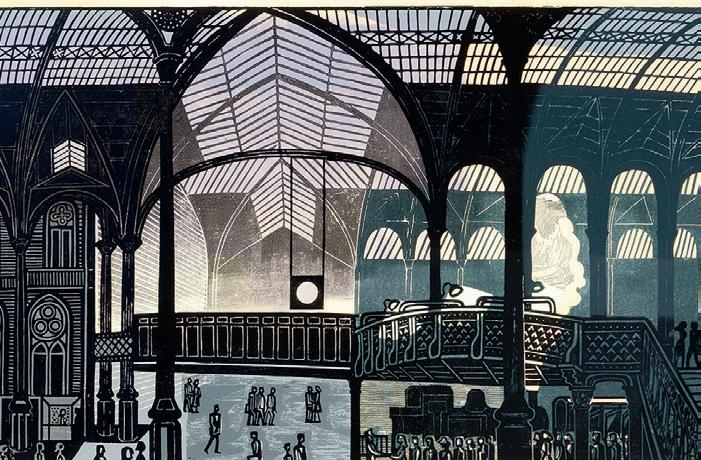
61 Surreal Spaces: the Life and Art of Leonora Carrington, by Joanna Moorhead
Lucy Lethbridge
63 The Three Graces, by Amanda Craig Mary Killen
Arts
66 Hello, Bookstore
Harry Mount
67 Theatre: Crazy for You William Cook
Pursuits
73 Gardening David Wheeler
73 Kitchen Garden Simon Courtauld
74 Cookery Elisabeth Luard
74 Restaurants James Pembroke
75 Drink Bill Knott
76 Sport Jim White
76 Motoring Alan Judd
78 Digital Life Matthew Webster
78 Money Matters
Margaret Dibben
81 Bird of the Month: shag
John McEwen Travel
82 Georgia, Jason and the Golden Fleece
Justin Marozzi
82 Overlooked Britain: Roman loos Lucinda Lambton

86 On the Road: Jools Holland
Louise Flind
Regulars
Editor Harry Mount
Sub-editor Penny Phillips
Art editor Jonathan Anstee
67 Radio Valerie Grove
68 Television Frances Wilson
69 Music Richard Osborne
70 Golden Oldies
Rachel Johnson
71 Exhibitions
Huon Mallalieu
Oldie subscriptions
87 Taking a Walk: Wiltshire's happy valley Patrick Barkham
Oldie
Advertising
Moray House, 23/31 Great Titchfield Street, London W1W 7PA www.theoldie.co.uk
Supplements
editor Jane Mays

Editorial assistant Amelia Milne
Publisher James Pembroke
Patron saints Jeremy Lewis, Barry Cryer
At large Richard Beatty
Our Old Master David Kowitz
To order a print subscription, go to www. subscription.co.uk/oldie/offers, or email theoldie@subscription.co.uk, or call 01858 438791, or write to The Oldie, Tower House, Sovereign Park, Market Harborough LE16 9EF. Print subscription rates for 12 issues: UK £49.50; Europe/Eire £58; USA/Canada £70; rest of world £69.
To buy a digital subscription for £29.99 or single issue for £2.99, go to the App Store on your tablet/mobile and search for ‘The Oldie’.
For display, contact : Paul Pryde on 020 3859 7095 or Jasper Gibbons on 020 3859 7096
For classified: Monty Martin-Zakheim on 020 3859 7093
News-stand enquiries mark.jones@newstrademarketing.co.uk

The Oldie August 2023 3
14 Charles Hawtrey, the genius of Carry On Roger Lewis 16 Joy of not driving Jennifer Florance 17 Thatcher’s housing tip Anne Robinson 18 Death of glamour Charlotte Metcalf 20 Who killed Sir Harry Oakes? Charles Owen 21 Elizabeth I’s love nest Quentin Letts 23 Hell is boring people Oliver Pritchett 26 My fairy godmother Harry Mount 29 Save Liverpool Street Griff Rhys Jones 32 Heroic Harriet Crawley David Ambrose 34 A cruise-ship entertainer’s life for me David Pybus 35 Happy has-been Julian Neal
5 The Old Un’s Notes 9 Gyles Brandreth’s Diary 11 Grumpy Oldie Man Matthew Norman 12 Olden Life Graham Sharpe 12 Modern Life Richard Godwin 37 Oldie Man of Letters A N Wilson 38 History David Horspool 40 Town Mouse Tom Hodgkinson 41 Country Mouse Giles Wood 42 Postcards from the Edge Mary Kenny 44 Mary Killen’s Beauty Tips 45 Small World Jem Clarke 47 School Days Sophia Waugh 47 Quite Interesting Things about ... cigarettes John Lloyd 48 God Sister Teresa 48 Memorial Service: Hilary Alexander James Hughes-Onslow 49 The Doctor’s Surgery Dr Theodore Dalrymple 50 Readers’ Letters 52 I Once Met… John Lewis John de Bruyne 52 Memory Lane Pamela Howarth 65 Commonplace Corner 65 Rant: packaging Carolyn Whitehead 89 Crossword 91 Bridge Andrew Robson 91 Competition Tessa Castro 98 Ask Virginia Ironside
cover Landmark Media /Alamy
Front
ABC circulation figure July-December 2021: 48,249 Subs Emailqueries? co.uksubscription.theoldie@ or 01858phone 438791
Annie met Maggie page 17 Lost and found: Snodhill Castle page 21 End of the line for Liverpool St? page 29 Save when you subscribe – and get two free books
page 31 Reader Offers
When
See
literary lunch
Reader trip to Northern Spain
p35
p79


The Old Un’s Notes
‘Given sufficient notice, one can always be spontaneous.’
If this saying reminds you of Oscar Wilde, it’s entirely appropriate. With this aphorism, Robert Eddison has won the fourth Wilde Wit Competition run by the Oscar Wilde Society, in partnership with The Oldie and The Chap. Oldie columnist Gyles Brandreth is the Society’s honorary president.
Eddison’s quote topped the list of more than 300 entries sent to the Society. Contestants vied with each other to produce Wildean aphorisms, both amusing and profound.
The shortlist was chosen by the Oscar Wilde Society Committee and guest judge Darcy Alexander Corstorphine, who won the first three years. He was invited NOT to enter this year, so as to give others a better chance.

Second place went to AJ West for this quip: ‘If it weren’t for nihilism, I’d have nothing to live for.’
Third place went to Simon Scarratt for: “A man who always tells the truth can never be trusted.”
Congratulations to our witty winners, who — like James Whistler — spoke so cleverly that Oscar himself might have wished he had said it.
John Betjeman and Philip Larkin were fine poets, great friends – and
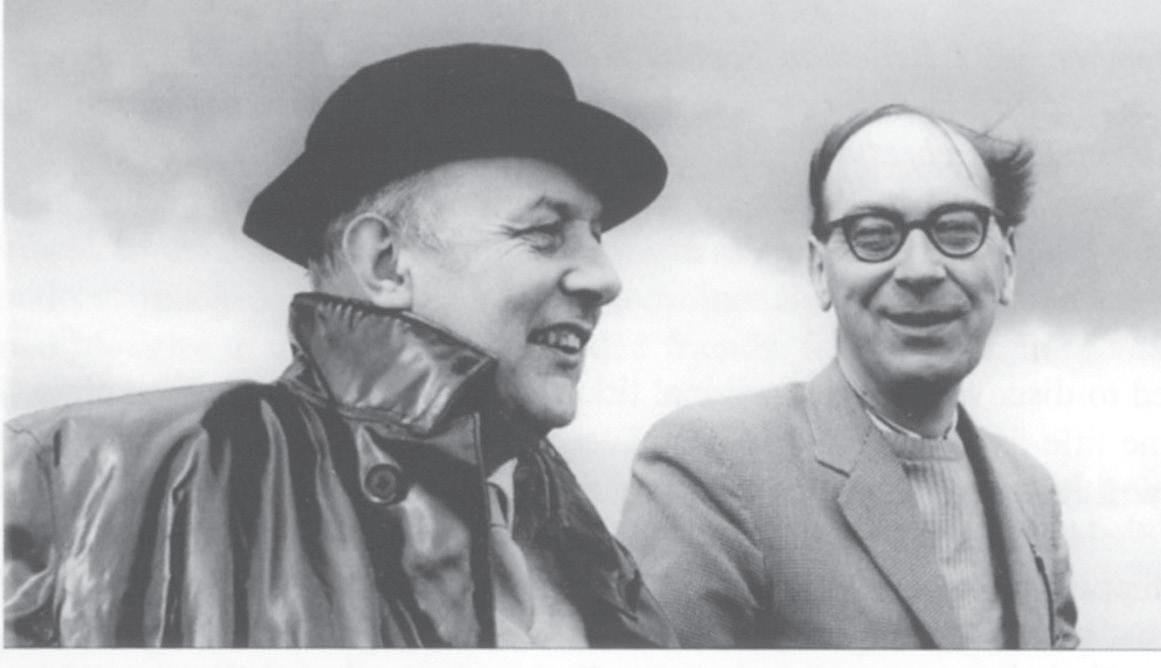
surprising Lotharios. So writes Philip Pullen in the new issue of The Betjemanian, the journal of the John Betjeman Society.
Pullen quotes Betjeman’s wife, Penelope, berating the poet for his affair with Lady Elizabeth Cavendish, the Duke of Devonshire’s sister.
Among this month’s contributors
Charlotte Metcalf (p18) is an awardwinning film-maker and freelance writer. She is the editor of Great British Brands and co-presents the Break Out Culture podcast.

Griff Rhys Jones (p29) starred in Not the Nine O’Clock News and Alas Smith and Jones with Mel Smith. He co-founded Talkback, the TV production company, and presented A Pembrokeshire Farm

David Pybus (p34) has lectured aboard cruise ships for 25 years, on everything from Dragons’ Den to pirates. He is a perfume expert, who has recreated the scent found on the Titanic.

Justin Marozzi (p82) is a travel-writer. His books include Islamic Empires: 15 Cities That Define a Civilisation, Tamerlane and The Man who Invented History – Travels with Herodotus
Peas in a pod: John Betjeman and Philip Larkin filming in Hull, 1964
‘I will take no halfmeasures,’ Penelope Betjeman writes. ‘I am fed up with your divided life and completely false set of values… I’m damned if I am going on with you in this perpetual dichotomy with insomnia, hysterical nerves, fear of losing your reputation etc etc.’
As Pullen writes, this could so easily have been written by Monica Jones, Philip Larkin’s much betrayed girlfriend, to Larkin.
Pullen also quotes the cartoonist Osbert Lancaster’s line that ‘Betjeman was the only person he knew who managed to be married, have a mistress and live the life of a bachelor all at once.’
In his fine article, Pullen also notes the fees Larkin and Betjeman got for their charming BBC programme in 1964, where the two poets tour Hull. Larkin got £125. Betjeman got £200. As Pullen says, Larkin ‘would not have been amused’.

The Oldie August 2023 5
BBC
Important stories you may have missed
Decision on 200 homes plan in Harrogate is delayed
Northern Echo
Shopping trolley dumped in park
Bolton News
Oldie readers will remember AP Herbert (1890-1971), the MP and comic writer Less well-known is his 1928 creation, The Voluble Topsy. She was a sort of Bridget Jones of the 1920s meets Nancy Mitford – and she now returns in the reissued The Voluble Topsy (1928-1947) (Handheld Press).

An It Girl before It Girls were invented, she is a deb and a flapper.
And she has a fine line in breathless patter, delivered in stream-of-consciousness letters, crammed with spelling mistakes, to her friend Trix:
‘Nowadays, the papers only have to say, “You must flock to Thingummy or Whatname,” and we all flock; my dear, it’s too gregarious and unSaxon, and really nobody’s happy this year unless they’re standing in a quue.’
Three cheers for the return of Topsy!
Bench fear for OAPs
Millport Weekly News
£15 for published contributions
NEXT ISSUE
The September issue is on sale on 26th August 2023.
GET THE OLDIE APP
Go to App Store or Google Play Store. Search for Oldie Magazine and then pay for app.
OLDIE BOOKS
The Very Best of The Oldie Cartoons, The Oldie Annual 2023 and other Oldie books are available at: www.theoldie.co.uk/ readers-corner/shop Free p&p.

OLDIE NEWSLETTER
Go to the Oldie website; put your email address in the red SIGN UP box.
HOLIDAY WITH THE OLDIE Go to www.theoldie.co. uk/courses-tours
Roger McGough, the poet who put the beat into Merseyside, has written a musical, Money-Go-Round And he is taking the cautionary tale about our lust for gold, loosely based on The Wind in the Willows, to the Edinburgh Fringe.
McGough, 85, our Oldie People’s Poet of the Year in 2021, has long been a fan of the Kenneth Grahame classic.
‘It was a favourite book as a child, and Toad of Toad Hall was the first play I was in at school,’ he says. ‘Apparently my rendition of Mr Badger is
still considered unbeatable,’ he says.
In 1985, he was asked to write the lyrics for an American version of the book, which had a very fleeting brush with Broadway. Undefeated, he was inspired to write a children’s book, Money-Go-Round, in which a coin is passed around each of the famous characters in the novel until it returns to its original owner.
‘I wanted children to regard friendship as more important than money,’ says McGough.

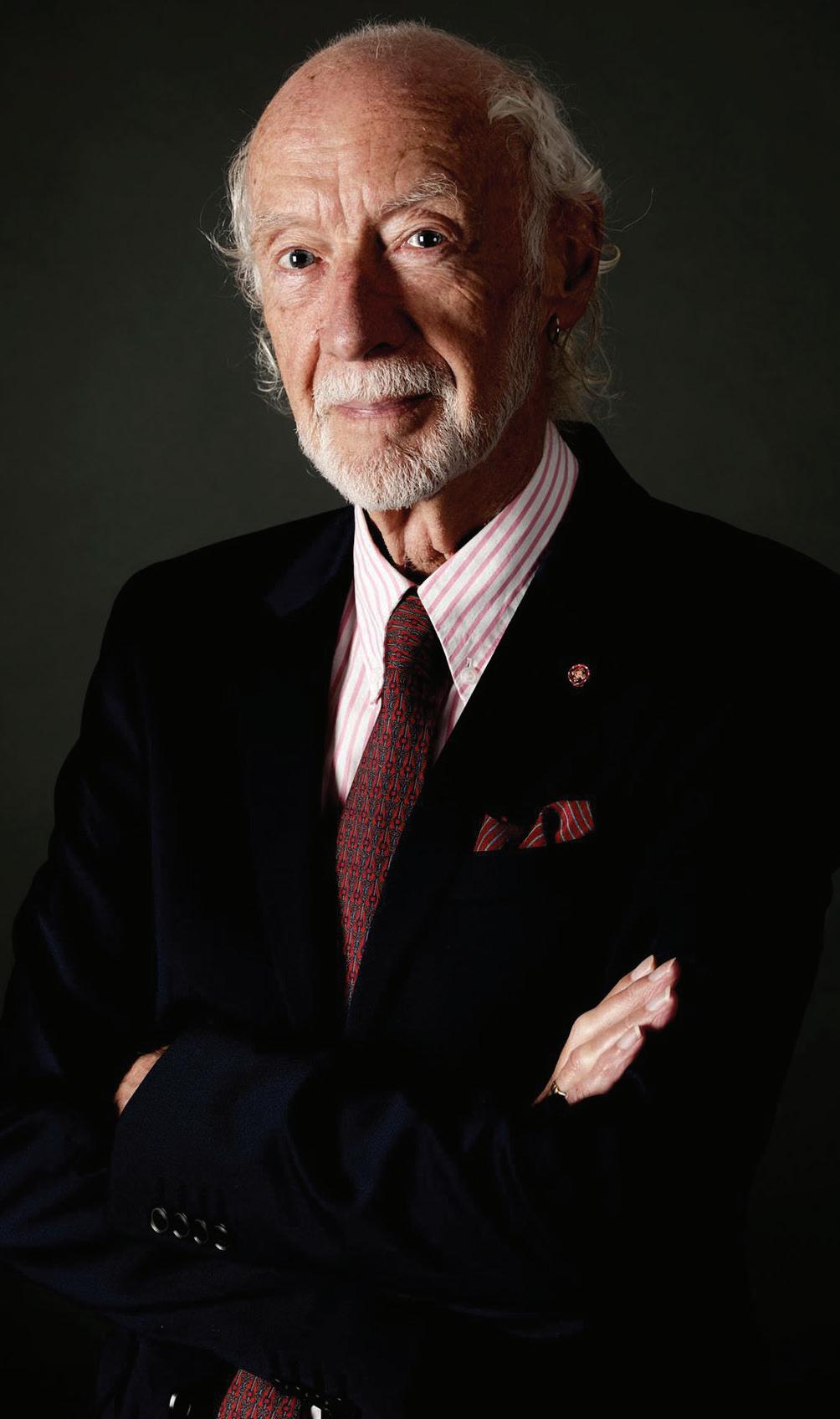
Then the penny dropped. Money-Go-Round could be a musical, too.
McGough, who first went to the Fringe in the early 1960s as part of The Scaffold, is also
founding member of South London band LiTTLe
MACHiNe [sic], a trio who take poetry – from medieval to Metaphysicals, Shakespeare to Carol Ann Duffy – and set it to music.
For the musical, bandmate Steve Halliwell, former lead of 70s ‘bad ass rock band’ King Swamp, wrote the score.
A cast of six (a whole orchestra by Fringe standards) rehearsed in McGough’s home patch in Barnes, agitating against the ‘destructive pursuit of wealth’ while playing Mr Toad, Mole and Ratty.
Here’s hoping the show goes with a bang – or a ‘Poop-poop!’, as Toad might put it.
6 The Oldie August 2023 KATHRYN LAMB / NEIL SPENCE
Lost Mitford: Voluble Topsy
People’s Poet: Roger McGough
‘Talk to me while I ignore you’
Congratulations to Lore Segal – the American writer who, at 95, is still publishing witty short stories.
Her latest collection, Ladies’ Lunch, is full of wry insights into oldie life in New York. Segal quotes the anonymous one-liner, ‘How pleasant the sight of a cheerful old person.’
And she is good at insights into the declining returns of old age: ‘Those were the days when I used to know eighty per cent of the people at a party. Now I know two people.’
Segal, born into a middleclass Jewish family in Vienna in 1928, escaped the Nazis to
Britain on one of the first Kindertransport missions. After graduating from Bedford College for Women (remembered fondly by Pamela Howarth on page 52) in London in 1948, she moved to New York. Her first novel, Other People’s Houses, came out in 1964 – and she has been writing ever since, for nearly 60 years.
Long may she continue to chronicle the lives of oldie New Yorkers.
Many congratulations to Barry Fantoni, the cartoonist who joined Private Eye in 1963, the same year as The Oldie’s founder, Richard

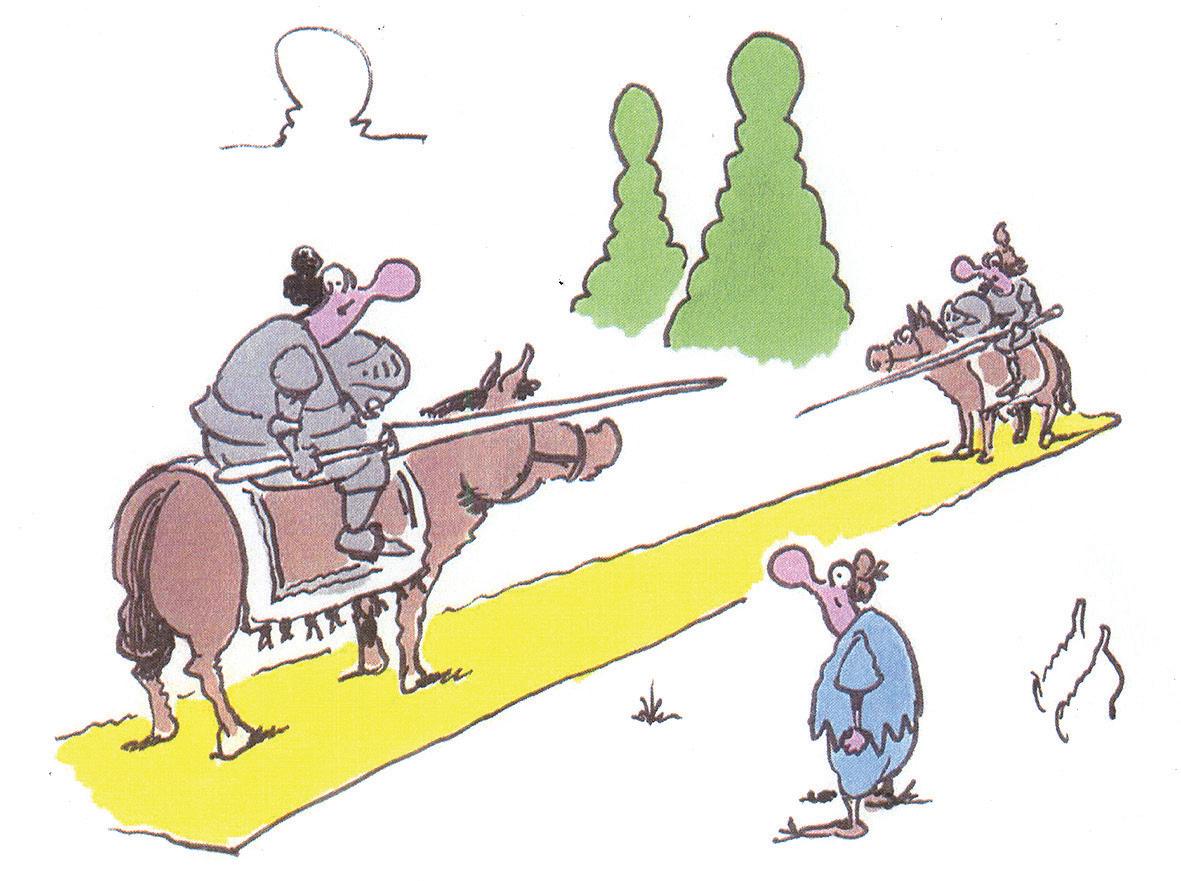

Ingrams, became editor of the Eye.
At 83, Fantoni has written and drawn a charming children’s book, Pep, the story of a Barcelona FC-loving cat, inspired by Pep Guardiola, the treble-winning Manchester
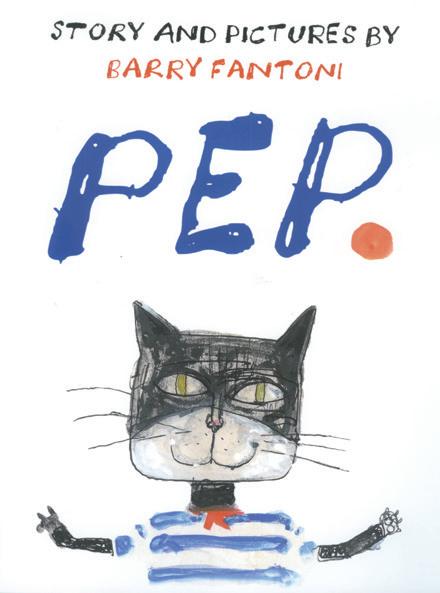
‘This one’s good if you like complaining about the heat ... and this is excellent for complaining about the food ... of if you prefer complaining about ...’
City manager and former Barcelona hero.
Among Fantoni’s creations at Private Eye were the dreadful poet E J Thribb. He also invented Neasden FC, the appalling football team, currently languishing in the North Circular Relegation League. Neasden are run by their permanent manager, ‘tight-lipped, ashen-faced supremo Ron Knee (59)’, and supported by their two loyal fans, Sid and Doris Bonkers.
Surely it’s time for Barry’s two great inspirations, Neasden FC and Barcelona FC to take each other on at Barcelona’s Nou Camp Stadium?
‘Sandraremember those naturists we met in Lesbos in ‘97?’

The Oldie August 2023 7
Pep, the feline footballer
‘All parents ght, son’

Killers I have known – and liked
‘Never commit murder,’ said Oscar Wilde. ‘A gentleman should never do anything he cannot talk about at dinner.’
To date, there has been no blood on my hands, but that may change. I am busy devising the perfect murder. I haven’t had so much fun in years.
It started as a cure for insomnia. When I go to bed, I nod off right away. At 5am, I wake up and can’t get back to sleep. That used to be a problem. Not any more. I now kill the time between when I wake and when the alarm goes off at 7am on an imaginary killing spree.
I don’t have a particular victim in mind. My focus is on the murder itself. It has to be quick, clean and undetectable.
As regular readers may remember, not long before she died, P D James, one of my favourite crime writers, told me the simplest way to murder someone is to take them for a quiet walk along Beachy Head. At 530 feet high, the East Sussex sea cliff provides the perfect setting for an unexpected killing.
When you are sure no one is looking, simply, suddenly and sharply, push your victim over the edge.
Fifty years ago, I published my first book, Created in Captivity. It was about prison reform and about how the creative arts – painting, poetry, drama – can help prisoners on the road to rehabilitation.
Researching the book, I met several murderers and built up a small collection of their paintings and sculptures. My favourite was a still life by Donald Hume (1919-78), a double murderer who ended his days in Broadmoor.
In 1949, Hume, a petty criminal with a pilot’s licence, murdered a fellow petty criminal who, according to Hume, had upset him by kicking his beloved dog, Tony. In his London flat on the Finchley Road, Hume stabbed his friend to death with a wartime souvenir, a Nazi SS dagger, and dismembered him with a lino-cutter and a hacksaw. Hiding the
torso in the coal cupboard (where his wife wouldn’t find it), he parcelled up the head and legs and drove with them to Elstree Airfield where he boarded a light aircraft and flew towards Southend and the English channel. He successfully dropped the body parts and the murder weapon into the sea.
The next day, managing to avoid both his wife and the cleaning lady, he asked a decorator to paint over the bloodstains on the wall in his flat and then, with the decorator’s help, carried another parcel – this one containing his victim’s torso – downstairs and into his car.
This time, he misjudged the route of his flight and instead of completing the perfect murder by dropping the evidence into the Channel, he dropped his package onto the Essex marshes.
The torso was found and Hume was charged with murder. But the jury failed to reach a verdict. At his second trial, he pleaded guilty to the lesser charge of being an accessory after the fact and was sentenced to 12 years. On his release, he killed another man during a botched bank robbery in Switzerland. This time, he was using a gun. That’s not my style. Guns are noisy and unreliable. Daggers
and hacksaws are messy and involve a lot of risky clearing up. I’m with P D James and the short, sharp shove – and with the great Agatha Christie who, given the choice, always opted for poison.
The only murderer I have known that I would properly call a friend was another Hulme, but with a different spelling.
In 1954, when she was just 15, Juliet Marion Hulme and her best friend, Pauline Parker, stuffed a half-brick into a lisle stocking and lured Pauline’s mother into a lonely park where, together, the teenage girls bludgeoned the mother to death.
It was a grim and grisly story, turned into a 1994 film by Peter Jackson called Heavenly Creatures, in which Kate Winslet played the part of my friend.
The ‘gymslip murderers’, as they became known, escaped the gallows because of their youth and Juliet Hulme tried to escape her past by changing her name. By the time I met her, she had become Anne Perry, a bestselling author of historical murder mysteries.
For a while, we were quite close. We went on a book promotion tour together around France and, at the start and end of the day, often shared a meal together. Though I tried, because she seemed such a nice person, I could never get it out of my mind that, once upon a time, she had committed a murder.
Ridiculous as it sounds, whenever she brought two cups of coffee to our table I always made sure I drank from hers and not mine and each time she picked up a steak knife, I flinched.
When she came to stay with us in London, my wife and I locked our bedroom door overnight – as quietly as we could.
Anne Perry died on 11 April this year, aged 84. Of natural causes . . . I think.

Gyles is appearing at the Edinburgh Fringe in August

Gyles Brandreth’s Diary
Some people count sheep – when I can’t sleep, I plan the perfect murder
The Oldie August 2023 9
My friend, the murderer: Anne Perry
‘Mum and Dad, can I borrow the wheel tonight?’


10 The Oldie August 2023
Warning! Moronic road signs ahead
Admirers of the highest classical culture will fondly recall Clash of the Titans, the 1981 filmic meisterwork in which Laurence Olivier’s Zeus and his fellow Olympians look imperiously down on humanity, and use their limitless powers to manipulate the affairs of mankind.
The identity of this modern deity may never become known beyond the screen-filled room in which they toy with mortal events.
But somewhere, in some municipal, modern Olympus elegantly styled after the Lubyanka, there is a Zeus du jour with a penchant for torturing motorists with palpably false traffic information.
There could in fact be dozens of them dotted all over the land. If only for narrative simplicity, however, I prefer to believe in a lone deity responsible for every fraudulent illuminated road sign that plagues a motorway or A road.
What drives this mischievous creature is less a matter for us than for a phalanx of world-ranked psychoanalysts, split evenly into three teams and working in eight-hour watches around the clock.
Whatever the motivation (psychosis; boredom; the weird compulsion to punish an inferior species), these pixillated messages are increasingly divorced from reality.
Long before a recent nightmare on the M4, suspicions had been raised by such old favourites as: ’50 mph: Congestion Ahead.’ You must have experienced yourself the delight of spending an hour travelling at the marginally slower speed of 0.7 mph – only to discover, the moment you reach the end of the queue to find the road ahead clear, that the queue had been generated neither by weight of traffic nor an accident.
The sole reason for the congestion was that a sign warning of congestion had caused motorists to slow to a crawl. One appreciates a cute self-fulfilling prophecy, of course, not to mention the irony
inherent in this motoring version of iatrogenesis (a medical disorder is caused solely by medical treatment).
Recently, however, the deity has taken to egregious taunting with warnings styled not as statements of fact, but as vague claims for which the god of motorway signage has plausible deniability.
‘50 mph,’ read one lately encountered on the M3. ‘Report of lane closure ahead.’
In this context, ‘report’ is the most vexing euphemism to afflict the language since the Radio Times took to describing the output of sitcom writer Roy Clarke (Last of the Summer Wine; that excrescence starring Patricia Routledge as a pantomime snob) as ‘gentle comedy’ – the word ‘gentle’ standing proxy here for the word ‘no’.
What ‘report of lane closure ahead’ appears to mean is: ‘No lane closure ahead, but I’m bored witless stuck here doing nothing, and I want you to know how I feel.’

We know that ‘report’ is a lie for two reasons. First, the presence of a camera every three inches on motorways means that no ‘report’ would be required by anyone with access to: a) screens showing live footage; and b) the miracle of eyesight.
Secondly, not long ago on the M4, I saw this: ‘40 mph: report of wild animals on road ahead.’
The commitment to fairness dictates an admission. Technically, it is possible that the westbound M4 (or, come to that, its easterly twin) will be invaded by rampaging hordes of wild animals. A
truck close to concluding its long trek from the Serengeti might be involved in the pile-up that causes its rear door to spring open, releasing dozens of big cats on to the hard shoulder.
More likely perhaps is a breakout from nearby Windsor Safari Park. Fans of the Planet of the Apes franchise will be familiar with the uprising led by Caesar, the pioneering talking chimp whose craving for social justice would eventually lead to Charlton Heston having that chilling epiphany on a New York beach.
One day, then, it is plausible that the inmate of a zoo – probably one of the higher primates, though conceivably the Spartacus of the hippo enclosure – will spearhead the mass escape and beastly invasion of the M4 that would justify such a message.
The recent afternoon on which the sign was observable, on the picturesque outskirts of Slough, was not that day.
Once again, anyone charged with observing traffic video would have struggled not to notice a herd of wildebeest sweeping majestically along the middle lane. And, even if so, it’s a fairly safe bet that one of the countless over-sharers of Twitter would have mentioned the appearance, on the bonnet of their Lexus, of a giraffe, a pair of ostentatiously mating mountain gorillas and a freshwater crocodile.
It is of course utterly futile to rail against this addition to the myriad horrors of attempting to travel through this miserable country.
Those whom the gods wish to destroy they first make mad, as, I think, Sophocles, put it.
But it’s hard to avoid the feeling that, in the field of deity-generated, roadrelated horror, Oedipus got off lightly with nothing worse than killing his father at the crossroads and the maternal coupling which ensued from that.
Grumpy Oldie Man
The new motorway hazard – phantom traffic jams and mythical beasts matthew norman
The Oldie August 2023 11
Technically, it is possible the M4 will be invaded by hordes of wild animals
what was a boardman?
The boardman was the lowest-paid, most important member of staff in the betting shops that appeared legally on the nation’s high streets from Monday 1st May 1961, then known as licensed betting offices.
He – almost always ‘he’ – was the only member of staff to liaise directly with the clientele, as the other workers were clustered behind a counter, protected by a bandit screen.
The boardman stood in the main area of the shop, liaising with customers. He displayed on his chalkboard – later replaced by white plastic ones and felt-tip pens – the latest betting odds and race results.
Horseracing and greyhound racing accounted for almost the entire turnover of a betting shop. The biggest betting events were the Grand National and the Derby.
what is white people food?
White people food is a piece of white bread with a sorry slice of ham and a sad tomato. It’s a hard-boiled egg and a side of undressed salad. It’s hummus and carrots. It’s a cheese sandwich. It’s a ‘lunch of suffering’.

And it’s a source of fascination and horror for Chinese youths, who claim to be astonished at the bland, spiceless al desko meals we Westerners routinely ingest.
The term originated on the socialmedia site Xiaohongshu, when a Chinese student uploaded a video of a woman on a Swiss train working her way through a head of lettuce and some ham. ‘I saw the pinnacle of white people cuisine today…’ the student told her followers.
This prompted a flurry of responses from other users, describing the joyless meals they’d seen on their travels, typically meagre vegetables and processed meats eaten cold out of lunchboxes.
A long-time resident of Germany
Race commentaries were transmitted over an in-shop Tannoy system – TV coverage was banned until the mid-’80s.
An ambitious boardman’s promotion would result in his becoming a ‘settler’. This meant working behind the counter where, after training, he – again a male role – would calculate the pay-outs customers’ winning bets had won.
When live TV coverage of races was introduced, boardmen became first an endangered species and then an extinct one.
Machines were introduced to settle bets automatically, allowing the person overseeing the process to concentrate on other matters, often becoming shop manager, which enabled companies to cut staffing costs.
Anyone looking for a realistic impression of a ’70s/early-’80s betting shop should watch the BBC series Big Deal, starring Ray Brooks as Robbie Box, which captures the milieu perfectly.
I began frequenting betting shops in
the late ’60s, aged 18, working in one aged 21 as a boardman.
I took pride in displaying runners’ details for the races on the in-shop board, in probable betting order, listing odds against the name of each horse, highlighting the favourite in a different colour.
Once the race was ‘off’, I’d follow the spoken commentary, writing against each horse’s name its current position in the race. I graduated from my role, learning the position of ‘settler’ via evening classes.
My betting-shop career ended suddenly. Filling in as a counter clerk, I handed one punter £100 too much.
I felt the manager had caused this problem by writing the amount due in longhand, letting the tail of a y extend into the pay-out section on the betting slip, where the total appeared in numbers – turning 50 quid into 150. The till was £100 short.
You bet I was sacked!
Graham Sharpe
reported that a colleague of theirs had the same lunch every single day: oatmeal mixed with low-fat yoghurt, plus half an apple and a carrot. ‘If such a meal is to extend life, what is the meaning of life?’
Many Chinese youths are now, ironically or otherwise, experimenting with ‘white people lunches’ of their own. Others theorise about what led the West to such pitiful meals.
Perhaps we have relegated food to subsistence as opposed to pleasure? Perhaps it’s something to do with Christian guilt? Perhaps we don’t know any better? It’s a mystery.
Not since a Chinese businessman recoiled from the ‘putrefied discharge of a cow’s udder’ (ie blue cheese) served to him at a Michelin-starred restaurant have our culinary habits been served up to us with such a healthy dollop of defamiliarisation.
Now, I could discourse for a long time on the simple pleasures of a good ham sandwich; or a plate of crudités with mustardy vinaigrette; or a simple, perfect caprese salad. Indeed, it wasn’t so long ago that we British mocked the
French for their fancy sauces as it was generally considered that our produce was so superior as not to require any embellishments.
These days, though, it’s more commonly British food that’s scorned for its blandness. So perhaps we should breathe a sigh of relief, for here we are, lumped in with the Italians, Australians and Swedes, as if we were all the same. Besides, how many of us would appreciate the finer differences between, say, Jiangsu and Szechuan cuisine? Not many, I fancy.
And here’s another little crunch of irony to savour. It’s common for us Westerners to characterise Chinese people as joyless workaholics. But in China, two-hour lunch breaks remain standard; workplaces are generally expected to have decent canteens serving hot food, which is eaten communally; and some even provide beds for post-prandial naps.
So, as Chinese youths ironically embrace our sad, lonely Tupperware lunches, perhaps we could turn, nonironically, to Szechuan crab, dan dan mian, chicken rice, Peking duck and lashings of jiaozi – followed by a nice sleep. It seems like a good exchange.
Richard Godwin
12 The Oldie August 2023
White lunch

Thirty-five years after Charles Hawtrey’s death, his biographer Roger Lewis salutes the funniest Carry On star – and Barbara Windsor’s favourite
King Charles
Abook worth having would be a gazetteer of our great and generally unsung character actors, supporting players, comic turns – stalwarts such as Richard Wattis, Raymond Huntley, Colin Gordon, Eric Barker, Julian Orchard, Jonathan Cecil and, of course, from the Carry Ons, Charles Hawtrey.
Hawtrey, like those others, was never the centre of attention. He had little to do with plot development. He wasn’t required for romantic interludes. He simply stood there, as Private Widdle, Tonka the Great or the Duc de Pommfrit, smirking slightly and glancing from side to side, unmistakably his eccentric self.
Whenever he appeared (‘Oh, hello!’), the scenes would be given a reliable boost, a dependable bounce. Audiences immediately relaxed and knew they were about to enjoy themselves.
Barbara Windsor said, ‘He was my favourite actor in the team,’ and Hawtrey is certainly the one who remains genuinely funny today.
Kenneth Williams now seems too shrill, with a personality like a pan of milk boiling over. Sid James’s cackling lechery is hard to stomach. The oafishness of Bernard Bresslaw was seldom amusing, and I never could stand Kenneth Connor gulping with sexual frustration. Peter Butterworth, in fairness, excelled at shiftiness.
It is Hawtrey, however, who was imbued with a true comic spirit. He had complete confidence in himself, especially when it came to camp innuendo: ‘He could toy with his dirk’; ‘Oh, don’t make it hard for me’; ‘She’s helping me stick my pole up’; ‘My thing’s caught’; ‘I can’t do it lying down’ and so forth – Talbot Rothwell’s endless bottom jokes and knob gags.
I cherish this exchange, in Carry On Henry: ‘Your hand on it,’ says the king, intending to seal a contract. ‘I never even put my finger on it,’ replies Hawtrey’s Sir Roger de Lodgerley, thinking he’s referring to Joan Sims.
Hawtrey was born in Hounslow in 1914 as George Frederick Joffre Hartree. Perhaps he changed his name to create confusion with a debonair West End actor and manager, popular at the turn of the century, Sir Charles Hawtrey (1858-1923).
Whatever the motivation, he attended the Italia Conti singing and dancing academy, and recordings were made of his boy treble. Hawtrey was in seasonal shows with names such as Bluebell in Fairyland, and he was often cast as a Lost Boy in Peter Pan. His Captain Hook at the Palladium in 1936 was Charles Laughton.
Like Elizabeth Taylor, therefore, Hawtrey began as a child actor and remained one. He had the demeanour always of an elderly child, who never fully grew up.
Starting in 1932, he co-starred in several Will Hay films, as the bespectacled, elfin class-swot. During the war he appeared in revue, joining Judy Campbell, Jane Birkin’s mother, when she delivered A Nightingale Sang in Berkeley Square. Calling himself Charlotte Tree, he perfected a drag act
– more Danny La Rue than Dame Edna. On the night the Café de Paris was bombed, Hawtrey helped carry buckets.
Hawtrey was directed in Shakespeare at the Old Vic by Tyrone Guthrie and did occasional Sunday concerts reciting the classics. I wish he’d been offered the chance to do more of this sort of thing. He’d have been ideal in Restoration Comedy, Sheridan or Congreve.
In 1969, he was marvellous as Marley’s Ghost in a spoof of A Christmas Carol: ‘I say, how much longer do I have to stand here moaning and clanging?’
Instead, there were endless bit parts in black-and-white films. I spotted him as a station porter in a Powell and Pressburger picture. As pale as a parsnip, elongated and undulating, with no dialogue, he’s apparent in Passport to Pimlico (1949) – playing the piano in the pub, looking cheerful in crowd scenes.
No doubt Hawtrey could have gone on playing these small roles for ever – he was in a now-lost television series called Our House (1960) – but nothing was going to be memorable. He turns up in

14 The Oldie August 2023
RANK ORGANISATION FILM
Oh, hello! Charles Hawtrey
Dentist on the Job (1961) and is to be glimpsed in What a Whopper (1961). I spotted him in The March Hare (1956) and in Brandy for the Parson (1952), with Kenneth More.
But it’s the 20 years Hawtrey spent making the Carry Ons that grant him immortality.
Peter Rogers and Gerald Thomas released a sort of smiling devilry in him. As a recruit in Carry On Sergeant, the first of the series, in 1958, instead of being weak and mincing, Hawtrey thoroughly enjoys bayonet practice: ‘You beast, peasant, commoner, have at you, varlet!’
He became adept at conveying mad courage, whether dragged up as an undercover policeman in Carry On Constable (1960), or as an effete French aristocrat in Carry On Don’t Lose Your Head (1967). Awaiting his turn at the guillotine, he is handed a letter. ‘Drop it in the basket,’ Hawtrey says nonchalantly. ‘I’ll read it later.’
In all these cheap films set in hospital wards, schools, army barracks, the North-West Frontier (actually Snowdonia), the Sahara desert (Camber Sands) or the resort of Elsbels (the Pinewood car park), where Kenneth Williams flinches, snarls, recoils and hisses, Hawtrey twinkled.
In Carry On Cleo (1964), which used sets left behind from the Taylor/Burton Cleopatra, Hawtrey, in Hume Cronyn’s costumes, totters about the palace as the ‘dirty old sage’.
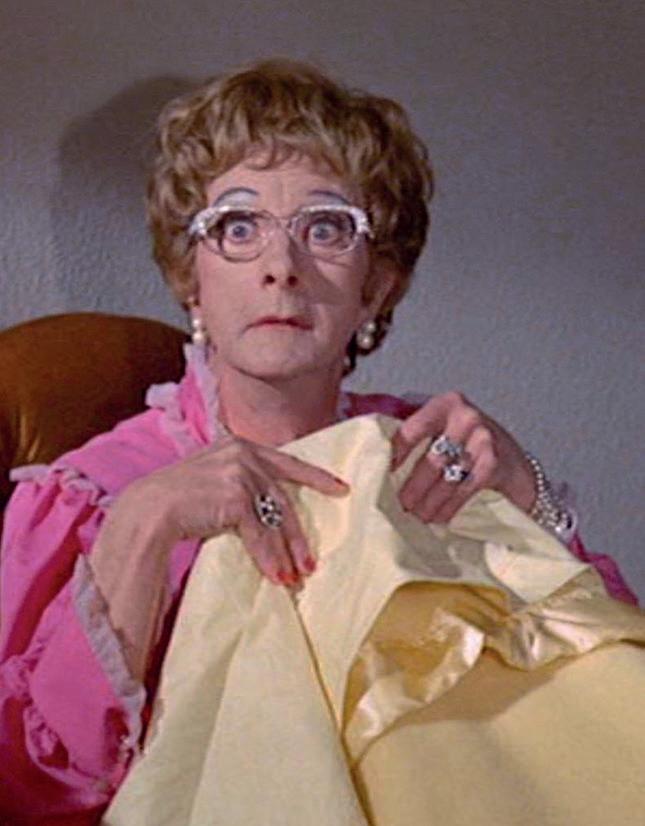

Hopping along the country lane in Carry On Camping (1969), his pots and pans jangling in his rucksack, he’s supremely happy, as he is wearing a kilt in Carry On Up the Khyber (1968).
Boarding the holiday coach in Carry On Abroad (1972), he is peerlessly blithe. ‘Where’s the crumpet?’ he is asked. ‘Oh,’ says Hawtrey, ‘I don’t think they’ll be serving us any tea.’
It’s a tragedy, however, when an artiste knows his worth and is inadequately rewarded. Hawtrey felt insulted to be relegated beneath Hattie Jacques in the billing, yet Peter Rogers refused to improve his conditions, or to pay him as much as Sid James. None received repeat fees.
When Hawtrey complained, Rogers sacked him. He was replaced by dire Lance Percival in Carry On Cruising (1962) and by dreary Norman Rossington in Carry On Christmas (1973). Disappointed, Hawtrey started drinking – and he was drinking on the set, gin concealed in lemonade bottles.
Instead of waiting for him to sober up, Thomas kept the cameras rolling. This is why in Carry On Spying (1964) Hawtrey is flat out in the background. In Carry On Abroad, he is seen swigging what appears to be suntan lotion. He is soon flat out on the beach. In Carry On at Your Convenience (1971), during the works outing to Brighton, Hawtrey staggers along the pier and is shortly flat out in the charabanc boot.
It is a paradox that a celebrity who gave the public so much pleasure became increasingly renowned for off-screen peevishness. Lunching daily on brown Windsor soup at the cafeteria in Bourne & Hollingsworth, Oxford Street, Hawtrey
was unapproachable. He refused to grant autographs and was a tricky customer with photographers.
‘No, bring me a nice gentleman instead,’ he’d insist, when for publicity purposes he was meant to pose with busty starlets.
In 1968, Hawtrey moved to Deal, drawn to the delights of the bandsmen at the Royal Marines School of Music. To this day, he is remembered with dread in the town, where he was barred from all the pubs because of his antics.
In 1984, his house burned down, a rent boy having dropped a cigarette down the sofa. Hawtrey was found by rescuers in bed holding a melting telephone.
When the fire brigade carried him down their ladder, Hawtrey insisted on climbing back up, as he’d forgotten his wig.
Having barely worked since 1972, he died 35 years ago, on 27th October 1988, aged 73. Smoking had caused arteriosclerosis and his legs needed to be amputated – an operation he refused. ‘I want to die with my boots on,’ Hawtrey said.
When the nurse asked for his autograph, he threw the water jug at her. His funeral was attended only by the undertakers.
I wish I knew where his remains were interred or his ashes scattered. I’d like to pay homage.
The Oldie August 2023 15
In Carry On Again Doctor (1969)
As Private Widdle, with Peter Butterworth and Joan Sims, Carry On Up the Khyber (1968)
Roger Lewis is author of Charles Hawtrey 1914-88: The Man Who Was Private Widdle
My road to nowhere
Ican’t drive. Not ‘I don’t drive’, ‘I haven’t got a car’ or ‘I would rather not drive’. I really can’t drive. Now that I’m looking back it doesn’t seem such a big deal, but in the ’70s driving was the Holy Grail for young people and not driving was almost as bad as not being able to read.
When I turned 17, learning to drive seemed as if it would be a doddle.
‘Ten lessons should do it,’ my driver friends hooted enthusiastically. Alan, my first instructor, took me out in his immaculate Mini and invited me to get behind the wheel. We jumped up the road for a bit.

Twenty minutes later, we stopped. Alan unglued my rigid hands from the steering wheel and I tried to relax my toes which had plaited themselves in knots of agonising cramp.
Alan, smiling but a bit rigid, assured me that the first lesson is always a ‘breaking-in’ period and it would get better. But it didn’t, and Alan bit the dust. If anything, it got worse.
Seventeen years and as many driving instructors later (I changed them every year), I was still a non-driver, without even one test under my seat belt. It wasn’t cool. Everyone I knew could drive. Well, apart from my sister. She couldn’t drive. Yet.
Not driving stood in the way of a lucrative career in journalism. I worked on a newspaper and had to catch the bus everywhere. On jobs, I would say that I had parked round the corner and then slink off to the bus stop.
I met my 18th instructor around this time. This one seemed OK. He once stopped my wild screams when I approached a roundabout. He didn’t moan when I dirtied his paintwork by slithering around too near the pavement on wet days and, for the first time, the cramps in my feet unknotted. So, reader, I married him.
I think that this was the nearest to
driving success I ever reached. It wasn’t happily ever after, though. A few years later, the marriage failed the test and I looked around for another instructor.
I also looked around for a new job. It wasn’t easy, but I had a strategy. When the inevitable question ‘Do you have a clean driving licence?’ arose, I had three stock answers. The first was a direct negative, but I would tear up and hint at
Much later, I joined the BBC as a newsroom broadcast assistant. But promotion depended on having driving skills, and without them I would remain grounded in the newsroom.
So back to the sheer terror of driving lessons. Because my sister was now taking regular lessons, sibling rivalry also entered the equation.
The madness finally stopped 45 years after my first sweaty, crampy session in the Mini, when I finally gave up. One day, I was prowling around the newsroom with that just-before-a-driving-lesson look. The usual nausea had set in.
A colleague noticed my heaving green face and asked me what the problem was.
‘Driving lesson soon,’ I gasped, fresh waves of sweat breaking out.
He gently took me aside and told me that he too used to suffer like this. In fact, he was so awful that, during a particularly bad test, the examiner abandoned him in the car, preferring to walk back to the test centre. Sitting there in the car, he came up with the ideal solution –give up.
a mysterious medical condition, which meant it was impossible for me to get behind the wheel. To my relief, no one asked what that condition was and we moved on swiftly to the next question.
The second answer was that I did have a clean licence. How were they to know it was only a provisional one? The third answer came with an outraged look, as I told them that I don’t drive. This implied that I used to drive but my love of the planet now prevented me from doing so.
He told me there are some things in life you really can’t do. It doesn’t mean you are stupid or less of a person. You just can’t drive – it’s not the end of the world. In fact, the world is greener because of non-drivers.
I picked up the telephone, cancelled my lesson and dropped ten years.
The man who gave me the advice spoke so much wisdom. So, reader, I married him too – and I intend to never have another lesson.
Life is sometimes a bit tricky. We walk a lot, and for every house move we have to consider the proximity of shops, railway station and a doctor’s surgery – but I am so much happier. The joys of giving up should never be underestimated.
Incidentally, my sister passed her test.
16 The Oldie August 2023
After 45 years learning to drive, Jennifer Florance has finally given up – and she’s never been happier
After 17 driving instructors, I was still a non-driver, without even one test
‘No problem! I read the lesson on how to fill out accident reports’
Maggie’s tip for first-time buyers
A guide to house-buying by Anne Robinson – and Mrs Thatcher
Not long before her departure from the political scene, I was invited to a Christmas lunch at Lord McAlpine’s country house, where Mrs Thatcher and Denis were the main guests.
We were 12 in all: an odd mix, including Terence Donovan, Mrs T’s favourite photographer, Olga Polizzi and her husband, William Shawcross, and Henry and Tessa Keswick.
In the slightly awkward pre-lunch drinks, I was standing with two other guests and Mrs Thatcher when, out of nowhere, she announced (and this is best done in a slow, deliberate voice after a couple of gins):

‘I always say to young people, “Buy a big house when you first get married and then you don’t have to move.”’
‘Yes, Prime Minister,’ chorused the other two.
I couldn’t help myself: ‘But, of course, Prime Minister,’ I responded haltingly, ‘not everyone can afford a big house when they first get married.’
She turned to face me full on.
‘I bet,’ she said, ‘you’ve made some money out of houses while I’ve been in office.’
By golly, I had. In the eighties, flipping West London properties paid far better than journalism or being a quiz-show host. As a result, I was known to every silk-socked, tassel-shoed estate agent in Kensington. John D Wood, who inexplicably favoured hiring young officers from the Blues and Royals, invited me one year to their office Christmas party.
And when they sent a new girl to take me to a viewing, I automatically asked what regiment she’d served in.
Alas the last two decades have produced a harsher world. Those posh boys from the big firms are now charged with making thirty calls a day, and from 15 viewings they need to achieve one offer – or they’re out.
That means the single operators –often called finders – are thriving. They
have good contacts, people skills and importantly the time to play nanny, shrink, best friend and even ‘close companion’ until the magical words ‘We’ve exchanged’ are uttered.
Cannily one of this tribe has now written an anonymous – he goes by the nom de plume Max –account of a year in his life selling super-prime homes in London. If you are as devoted to Location, Location and Kirsty and Phil as I am, you’ll be gripped.
There’s the Oscar-winning actress who always arrives five minutes early. The billionaire so rude and foul he makes Kanye West seem like Mother Teresa. The sad, deserted wife, the American influencer who may or may not have the price of a Tube ride and the National Treasure in the Cotswolds with an ugly, almost unsaleable 1910 pile.
Best of all is ‘Uncle Fortescue’, who belongs to Natasha, the aristocratic assistant in Max’s office. Uncle Fortescue lives in Victoria Road, W8. It doesn’t come more desirable in Kensington, except that the inside of Uncle Fortescue’s home is a filthy slum for which Uncle Fortescue wants an unrealistic ten million.
Plus he only wishes to sell to an Englishman. Not any sort of Englishman. Because when a wealthy trader from Yorkshire shows an interest, Uncle Fortescue instantly objects because he’s common.
The author also describes showing me a house and ‘twittered on about the joys of an ensuite bathroom’ when I cut him short with, ‘You’ve got a non-speaking
role.’ Quite right.
These days, I don’t wait that long. As we enter a property, I tell Rupert, Giles or Tarquin to imagine my mobile is a remote control pressed to mute him. And unless I hold it up to his face, I wish to hear nothing. Especially not the blindingly obvious.
I don’t recall the encounter with Max, but he comes across as an absolute sweetie. For months, he patiently wraps a protective arm round Zara when her horrible husband goes off with the Pilates teacher and she and her children must find a new home for half the price of a Notting Hill mansion.
The answer is Queen’s Park, where a four million price tag is not unusual and there are now apparently more Filipinos emptying dishwashers than there are in Belgravia.
Max is gay and in a bit of a muddle about his life. Meanwhile, his small team variously fall in and out of love with each other, their clients and, worse, their clients’ unreasonable, spoilt, horrible children.
In a struggle to discover a more meaningful direction, the author even records regular visits to his shrink, Quentin. I like the sound of Quentin, who is no slouch.
For one appointment, he announces they are going on a field trip. Specifically, to visit a sex shop, the Clonezone.
The quest is for Max’s sexual liberation. Once he’s there, in a spirit of helpfulness the salesman in leather chaps explains of an item on display, ‘This can bring you to orgasm without a physical touch to the actual phallus.’
If that moves you more than the property dramas, the address is 266 Old Brompton Road, London SW5 9HR.
Highly Desirable – Tales of London’s Super-Prime Property from The Secret Agent by Anonymous (Headline, £22) is out now
The Oldie August 2023 17
The PM said, ‘I bet you’ve made money out of houses while I’ve been in office’
Maggie the Builder: at Canary Wharf, 1990
RIP the glamourpuss
Marilyn Monroe, Audrey Hepburn and Jackie O all had it – before Instagram and celeb egomania destroyed glamour. By Charlotte Metcalf
Botox, fillers and surgery have made cosmetic perfection attainable and banal. And celebrities are constantly baring their souls or revealing their ‘truth’, rendering their over-shared life stories banal – and distinctly unglamorous.
How times have changed since Peter Sarstedt’s 1969 hit Where Do You Go to (My Lovely)? defined glamour. Allegedly about Sophia Loren, it portrays a beautiful woman pursued and fêted by the richest men in the world, gliding effortlessly between St Moritz, Juan-lesPins and her Parisian apartment.
Only the singer knows of her humble beginnings in the backstreets of Naples. Even now her past is widely known, we still picture the movie star alighting in Capri from a Riva before being whisked off to a secret rendezvous in a scarlet convertible.
Rags-to-riches stories are nothing new, and many celebrities today have clawed their way out of modest, if not downright tough, working-class beginnings.
Yet what strips most of them of glamour is not their struggle but their propensity to talk about – even boast of – their pasts. Stories of depression, abuse, breakdown, drugs, alcohol and rehab abound, almost as a rite of passage.
Did we stop to wonder whether Cary Grant or Brigitte Bardot grew up in a trailer park? We knew Marilyn Monroe was emotionally vulnerable, but her reputation as an irresistible siren remained intact, mainly because she never sat on a sofa chatting to a cosy daytime-television host about being Norma Jeane.
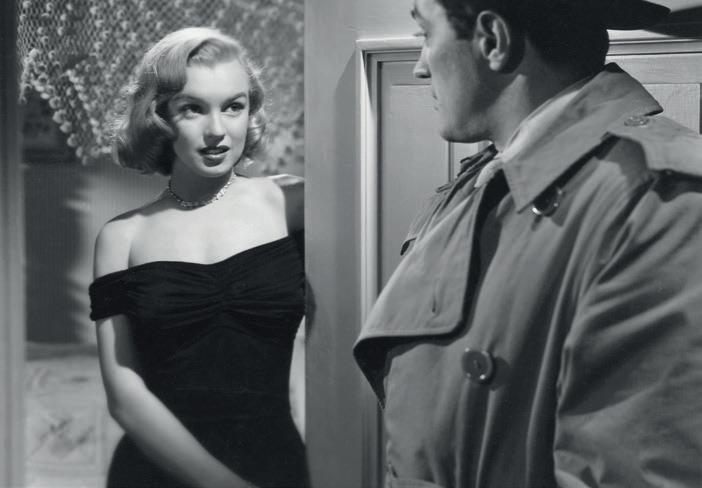
Elizabeth Taylor and Richard Burton might have conducted their wildly volatile love affair in public, but the idea of either of them sharing images of their private life on Instagram or signing up for I’m a Celebrity… Get Me Out of Here! is unimaginable.
‘Glamour’ no longer implies an elegant figure slipping into the Ritz behind stylish sunglasses. Instead, we think of raunchy underwear models or the
scantily-clad compères of shows such as The X Factor or Love Island
Even then, we’re bombarded with unflattering phone snaps of them caught unawares, or interviews about their collagen intake or fashion tips. Movie stars like Lauren Bacall have never seemed so distant.
The ease with which we can find out every detail about famous people today has rubbed the sheen from even the most impressive figures.
Take the American First Ladies. Jackie Kennedy was glamorous, remaining publicly dignified as a tragic widow before being rescued by a Greek tycoon.
Yet the First Ladies of recent years fail to make the grade. Melania is ruled out by dint of her gold-digging proximity to Donald. Hillary’s garish blue pant suits alone disqualify her. Michelle was making the grade until she tore up the rule book by over-sharing in her own book Becoming. To remain glamorous, preserving an aura of enigma is essential.
Princess Diana stopped being glamorous the minute she revealed her misery to Martin Bashir. The nation held its breath as she revealed her egocentric frailty, rendering her a pitiful victim rather than the hard-working, charming beauty we’d previously admired from afar. And we have only to look at her son and Meghan to witness the damage caused by endlessly communicating their ‘truth’.
We want our heroes and heroines inscrutable, like swan-necked Princess Grace. Yet we’re in an age of Instagram, tell-all Q&As, Hello! magazine, self-help books and Gwyneth Paltrow’s lifestyle
website Gloop. The word ‘lifestyle’ alone would be frowned upon by Nicky Haslam as ‘common’. It’s hard to imagine Marlene Dietrich selling a candle on-line that smells of her vagina.
The new exhibition Diva at the V&A sets out to explore how the diva’s role has changed and been subverted over the years. From performers such as Billie Holiday, Maria Callas and Vivien Leigh via Whitney Houston and Tina Turner, the exhibition turns to current divas such as Elton John and Lizzo.
It’s a fascinating subject for a museum famed for celebrating fashion to embrace, tracing how elusive glamour has given way to flamboyant extravaganza and camp spectacle. And this goes hand in hand with gushing emotion – just look at the recent Oscar acceptance speeches.
In his brilliant book Fracture, Matthew Parris, who presents Radio 4’s Great Lives, argues that many great lives are shaped by trauma. While that remains true, the constant exposure of our inner lives to public scrutiny has eroded glamour, even though the mentalhealth benefits of emotional openness are undoubtedly plentiful.
The Oxford English Dictionary defines glamour as an attraction or appeal that enchants, casting a magical spell.
The last time I saw anyone do that was in the early ’90s, when Audrey Hepburn, as a Goodwill Ambassador, made an appeal on behalf of UNICEF at the Palais des Nations in Geneva. In a plain, brown dress, skeletal with cancer and with hardly any hair, she talked passionately and eloquently about the children in need of our help.
She said not a word about herself and bewitched every one of us, not just with her compassion and beauty but with her humility and restraint –glamour personified.
18 The Oldie August 2023
The Diva show is at the V&A until April 2024
Monroe in The Asphalt Jungle (1950)


Murder in paradise
Sir Harry Oakes, a tycoon friend of the Duke of Windsor, was killed in the Bahamas 80 years ago. That night, a young Charles Owen was nearby

The night of 7th July 1943 was heavy with an approaching storm.
My sister and I were in our beds. Our mother came to kiss us goodnight before going out to dinner. I asked her if she was going to Government House. The incumbents were the Duke of Windsor, now Governor of the Bahamas, and the Duchess.
‘No,’ she whispered, ‘and what a relief. Wallis always teases me because I have nothing decent to wear. It all went down with the ship.’ She was dining with friends, she said, ‘and after that we are going to play Murder’.
Lying awake in the dark and the heat, we could hear the cockroaches running up and down behind the wainscoting. The maid had shaken disinfectant powder in cracks in the walls and the creatures, like us, were finding it difficult to settle.
We were renting an old plantation house in Nassau. Fifteen months earlier, we had been aboard the Blue Funnel liner Ulysses, two weeks out from Australia, bound for Liverpool, when the ship was torpedoed by a German submarine and sent to the bottom. We were rescued by a US Navy corvette and taken to Charleston, South Carolina.
Later we moved to Nassau, which was in the sterling area, to wait for a convoy to take us back to England. I was eight years old. Several of my contemporaries on the island became well known later.
Jimmy Goldsmith and I shared a bench in the schoolroom. I remember one morning when he was looking forward to tennis lessons and his mathematics teacher had to tell him off for practising strokes with his racket instead of paying attention.
That night in July, the storm struck Nassau shortly after midnight – thunder and lightning, the waves surging up the beach and the rain coming down in sheets. By the time it had blown itself out, Sir Harry Oakes, Bt, one of the world’s richest men, had been
bludgeoned to death and set on fire in his beachfront home.
Born in Maine, Oakes made his fortune in Canada as a gold-prospector, living under canvas in freezing conditions, often existing only on scraps. Settled in Nassau, where his huge wealth was sheltered by minimum rates of tax, he was a large employer of native labour.
A keen amateur golfer, Oakes was due to play the Duke of Windsor on the day his body was found. He owned the course and had the habit of irritating his opponents by using his bulldozer to change holes and bunkers overnight between rounds.
Count Alfred de Marigny, born in Mauritius, twice divorced, good looking in a rakish sort of way, with a yacht named Concubine and a hereditary courtesy title, was known to his friends as Freddie. He was also Sir Harry’s son-in-law, having married the Oakeses’ daughter, Nancy, as soon as the beautiful young woman had come into her inheritance.
Relations between Marigny and his father-in-law were strained and the two hadn’t spoken for several months. On the night of the murder, shortly after 1am, Marigny had driven two dinner guests to their home about a hundred yards from
Oakes’s house. The timing and the location, along with his known antipathy to Oakes, were potentially incriminating. Marigny was arrested, remanded in custody and escorted to jail.
The Duke of Windsor, whose open dislike of Marigny was no secret, secured the services of two detectives, members of the Homicide Bureau, Miami. At the magistrate’s hearing, the court learned that Marigny was in dire financial straits and that Oakes was in the process of changing his will, putting Nancy’s share of her inheritance beyond her reach until she was 30 – which was 11 years distant. Moreover, Marigny had been heard making threats against Oakes.
At the end of August, Marigny was committed for trial when the Quarter Sessions opened in October. He was returned to his cramped prison cell and its sweltering heat for a further five weeks. A rope was ordered from the chandler for the hanging.
The murder inquiry revealed that, on the night of the murder, Oakes’s wife had been away. Oakes had had some guests to dinner and one of them, Harold Christie, a real estate developer, had stayed the night to avoid driving home in the storm. It was Christie who had found Oakes’s body the following morning.
In the trial, it proved impossible for the police to establish definitively how and where Oakes had been killed. Under rigorous cross-examination of Marigny, the fingerprint evidence against him fell apart and he was acquitted.
He received a telegram offering congratulations that he had ‘won by a neck’. The jury took a more jaundiced view and recommended that he be deported.
The crime remains unsolved. Over the years, people who have continued to probe for answers have met with unexplained ‘accidents’.
Despite this discouragement, there are others who are still trying to unravel the secrets of what has been called the greatest murder mystery of all time.
20 The Oldie August 2023
Sir Harry Oakes, 1st Bt (1874-1943), at The Caves, one of his six homes on the Bahamas, 1940
Elizabeth I’s love nest
By Quentin Letts
Snodhill Castle is England’s newest Norman ruin.

More than 900 years old, it is only just starting to surrender some of its misty secrets, including a rediscovered royal chapel.
Most castles were well documented, having for centuries required military funds. Of Snodhill there is, in historical records, oddly little mention.
Were clerks instructed to lift their quills out of the ink and keep its existence classified? Was this remote site in western Herefordshire a secret base? Or was it a romantic hideaway for royalty?
On a Bank Holiday Monday earlier this summer, a hundred locals clambered up Snodhill’s grassy motte, as indeed any modern visitor can, to inspect an archaeological find.
Television journalist Nik Gowing chaired proceedings. The actor Robert Bathurst read from the diaries of Francis Kilvert, the Victorian clergyman who picnicked on Snodhill’s tree-covered mound on Midsummer’s Day in 1870.
Kilvert and friends drank punch and boiled a saucepan of new potatoes, the men smoking and talking politics while the women did much of the work. Little changes.
From Snodhill’s ruins, fringed by oxeye daisies and the occasional spear of hemlock, the views of Herefordshire’s Golden Valley are certainly divine.
Below lie fields with Anglo-Saxon hedges, sheep’s bleats rising from distant meadows. To the oak-dotted horizon stretches a deer park where aristocrats could gallop and cavort. One area was known as a lovers’ water meadow.
Not that it was all pleasure. From the 12th to the 15th century, the Marches saw repeated biffing of and by the Welsh, during raids by Llywelyn the Great, Dafydd ap Gruffydd and Owain Glyndŵr. Snodhill, sometimes called Snothill, was one of several Marches forts but none was so little chronicled and none had a royal chaplain.
Under its main tower, the Bank Holiday visitors were shown the outline
of the royal free chapel uncovered by Herefordshire Council’s archaeology department. The chapel’s existence was common knowledge but its location had been long lost.
There had been speculation it stood outside the castle but here it was, right in the bailey, near private apartments better suited to a boutique getaway than to a rural garrison.
The dig found evidence, furthermore, of frenzied destruction, probably by 17thcentury Puritans, who left the chapel’s ornate interior in rubble and its sacred artefacts bent out of shape. Behind the altar was a lockable chamber where valuables – or lovers? – could be concealed.
Garry Crook, chairman of Snodhill Castle Preservation Trust, noted the rare level of violence with which the chapel was wrecked. Whoever destroyed it was in the grip of moral outrage.
Could it not simply have been a general’s tactical desire to put the place out of military action? Maybe, but Snodhill saw no battle action in the Civil War and the nearest siege, at Hereford, was pretty low-key. Two cannonballs exist in a house near the castle, but it is thought they are souvenirs from elsewhere. In recent centuries, they were used as cheese presses.
Until five years ago, the castle was engulfed by vegetation and was home to deer, redstarts and badgers, whose setts undermined the masonry.
Then a preservation trust got going, volunteers hacking away centuries of gorse and securing funds from the likes
of Historic England and the Garfield Weston Foundation.
Walls and the north keep were rescued from collapse. Timber felled in the work was turned into salad bowls, which are being sold to raise funds.
‘There is a lot more of the castle to see today than there would have been in Kilvert’s time,’ said Surrey Garland, a Snodhill trustee.
A former bishop of Hereford, John Oliver, who in younger days often clambered over Snodhill with his family, became the first bishop to say a blessing at the chapel for hundreds of years.
The chapel was a ‘royal peculiar’, which meant chaplains were chosen by the monarch rather than by some finger-wagging prelate.
For such a small baronial castle to be a royal peculiar may have been unique. One of Snodhill’s chaplains was the composer Robert Fayrfax, the Elton John of Henry VIII’s day. His songs included ‘I love, loved and loved wolde I be’.
Ash trees at the site date to the 16th century. In 1563, Elizabeth I gave Snodhill to her intimate, Robert Dudley, Earl of Leicester.
A lover’s parting gift? Dudley kept Snodhill for only four years. We may not know – we cannot tell – but maybe this rural idyll stirred such painful memories for him after his fall from Elizabeth’s favour that he could no longer bear to visit it.
‘The man must indeed be of a mind void of imagination,’ wrote T Prosser Powell, a 19th-century local squire, ‘who can stand here on the ruin of this old border castle, where lords of the Marches fought and sported and loved, and say such a spot is utterly uninteresting. How difficult it is to sweep aside the cobwebs of ages and look into the dark corners of the story of these border chiefs.’
Why did Powell say ‘fought, sported and loved’? Did local gossip from Elizabethan days survive to Victorian times?
Was Snodhill Queen Bess’s love nest?
For years, Snodhill Castle was engulfed by gorse and badgers’ setts. Newly restored, it has now revealed royal secrets.
Quentin Letts writes for the Times
The Oldie August 2023 21
England’s newest Norman ruin: Snodhill
Letter from America

A criminal tale of two cities
Stranded by bad weather the other day in Portland, Oregon, I took a walk.
The town still prides itself on its 1880s converted sawmills-and-saloons ambience. But, surveying central Portland from a nearby hilltop, I was struck more by the similarity to Dunkirk in 1940.
Several hundred homeless residents, looking like the remnants of a defeated army, were hunched together around braziers or lying in rows of cots on the pavement. No one in Portland bothers about the remaining laws against public drug use or befouling the streets.
The much-shrunken, demoralised police department, its budget slashed in the wake of the George Floyd riots of 2020, currently has just 749 officers, its lowest total since 1980. The city has added 175,000 new residents in the same period.
Just outside this toxic bubble, there’s the ‘real’ Oregon, represented by a long chain of bucolic hamlets inhabited by friendly, well-dressed men and women. It’s a world essentially unchanged since the days of JFK in the White House and Dean Martin slurring his way through That’s Amore on the radiogram.
It’s as though the whole area has somehow managed to slip through a crack in the space-time continuum; to lie not so much indifferent, as oblivious to the march of progress.
You see long rows of neat, clapboard houses, many with a US flag fluttering out front, and spruce little towns with names like Rockaway Beach, Seaside and Tilamook. After the experience of nighttime Portland, it’s like going to bed in a Hieronymus Bosch painting and waking up in one by Constable.
Should you have an emergency of some kind in rural Oregon, you can expect a swift response. In the metropolis of Baker City, with 10,000 residents, the police promise to be at
your door within seven minutes.
Over in Yamhill, in the heart of Oregon’s wine country, the local sheriff simply gets on his bike to investigate the odd Saturday night complaint about someone overdoing the Bacchic rites.
So, nowadays, it’s a lottery what might happen when an American householder summons the law.
In downtown Portland, the average response time to a 911 (or 999 equivalent) call ranges between 45-90 minutes. In New Orleans, officers take two and a half hours to attend a crime. That’s long enough for the perpetrator to take in dinner and a show in the French Quarter on his way out of town.
Over in Austin, Texas, meanwhile, a retired police officer named Robert Gross recently complained that he’d rung his former colleagues on the force ‘four or five times’ to report a dead body lying in his back garden. It eventually took them two days to respond.
‘I was surprised, but not shocked,’ Gross added of his experience of dialling 911. ‘It’s a shambles.’
Where I live in Seattle, 100 miles north of Portland, it’s all a question of priorities when it comes to an emergency response. One day last summer, trying to report a car break-in, I spent 40 minutes on hold, alternately listening to canned Mantovani music and a recorded announcement assuring me how vital my call.
The ‘detective’ who arrived on the scene 24 hours later displayed all the
befuddled style of Lt. Columbo, without any of that great sleuth’s forensic skill.
Set against this, the Seattle police chief has urged ‘anyone suffering or witnessing any form of racial harassment’ to call 911, and promises the ‘fastest possible response … Even if you’re not sure a hate crime is involved, call us immediately. We are here to help.’
More recently, I happened to pick up the phone to ring a publisher’s office in London to ask about the progress of a book I’d sent them.
Five minutes after I hung up, there was a thunderous knock at the front door. Two extremely large Seattle policemen walked in, an impressive variety of guns and other hardware on their hips, and demanded to know why I had just rung the nation’s designated emergency hotline.
It took some time for the penny to drop. The publisher’s number included the critical digits 911. Merely by dialling it, I’d triggered a police computer somewhere into dispatching a squad car to my home.
I felt like asking the officers why they thought an innocuous phone call to an office 5,000 miles away might take precedence over one reporting a burglary. But it was neither the time nor the place, I decided.
The men didn’t look like the sort of people who debate the vagaries of British STD codes, let alone the finer points of book production. So they thoroughly searched the premises. I thanked them for their time and watched them drive off to their next appointment.
Next time my car is broken into, I’ll call my publisher.
Satisfaction
Christopher Sandford is author of Keith Richards:
. Brought up in Britain, he now lives in Seattle
Portland is running out of cops – in Seattle, I can’t avoid them
22 The Oldie August 2023
Christopher Sandford
Two extremely large policemen walked in, an impressive variety of guns on their hips
Danger! Boring story alert
Have you ever found yourself telling the same excruciatingly dull anecdote twice? Oliver Pritchett has invented the ultimate cure
Do you find that when you are telling an anecdote to someone, you suddenly get the uneasy feeling you have told the same person the very same story before? Maybe several times?
It is one of the perils of getting older. You embark on an amusing reminiscence, lose confidence, falter –and then decide to plough on to the punchline. The trouble is, people are too polite to stop you in your tracks, even when you have begged them to say if they’ve heard it before.

The wonderful news is that I have developed an app that solves this problem. It is called Borenomore.
Its database holds hundreds of your best anecdotes. By means of sophisticated voice-recognition technology, each anecdote can be identified by a trigger word or phrase, such as my dear old granny or donkey’s years ago or my headmaster or complete fiasco – and of course a great mate, my first car, a prank, the war and rather a funny thing actually.
In a matter of seconds, the app can identify the anecdote that’s in the offing, run through all the contacts on your phone and highlight the names of those persons who were present when the anecdote was previously deployed.
An alert is then sounded. You can choose your default alert from a selection that includes a beep, a discreet cough or an audible yawn.
Sometimes, when you are halfway through some reminiscence, you realise
you have forgotten the point of it, the punchline, or the names of crucial characters in it.
No problem. Just touch the ‘abort anecdote’ button on the app and your phone will actually ring itself, so that it appears that you have been interrupted by a call.
You can also alter the settings on your app to suit the surroundings where your reminiscence is likely to occur. The default settings include ‘bar’ and ‘family occasion’ and ‘wedding speech’, ‘coffee morning’ and ‘reunion’. You can, of course, customise the app to suit other surroundings.
The deluxe version of Borenomore
has an additional function. If, in the course of a story you are telling, you happen to mention, for example, what you paid for a house or a meal in, say, 1957, this handy little device will immediately calculate the equivalent of that sum in today’s money.
The app is not quite ready to be downloaded yet. There are one or two snags that need fixing. I’ve been developing it with an old mate who was a contemporary of mine at school.
Actually, there’s a rather funny story about him…
CHRISTIE’S
/
The Oldie August 2023 23
Anecdotage: David Oyens’s De Stamtafel: Storytelling in a Café, 1879
IMAGES
BRIDGEMAN
Oliver Pritchett worked for the Sunday Telegraph for over 40 years
I have developed an app that solves this problem. It is called Borenomore


Lindy Dufferin was a painter, cow-breeder, yoghurt-manufacturer and chatelaine of a great Northern Irish house. By her godson Harry Mount
The Last Marchioness
It wasn’t hard getting people to write down their memories of my dear godmother, the Marchioness of Dufferin and Ava (1941-2020), for a tribute book I’ve just edited.
Memories of Lindy Dufferin came thick and fast – and she always produced a different, striking reaction in people.
‘She had no neutral gear,’ said her friend Tom Stoppard.
‘She laughed. I miss her,’ said David Hockney – whose early pictures were dealt in the 1960s at London’s Kasmin Gallery, co-owned by Lindy’s late husband, the Marquess of Dufferin and Ava (1938-88).
And the singer Van Morrison said of Lindy, his neighbour in County Down, ‘We’re both eccentric.’
Lindy packed several lifetimes of work – and fun – into her 79 years. She was a painter, conservationist, champion cow-breeder, yoghurt-manufacturer –and chatelaine of Clandeboye, an enchanting country house between Belfast and Bangor.
Painting under her maiden name, Lindy Guinness, she was taught by Oskar Kokoschka, Sir William Coldstream and her great mentor, Duncan Grant.
She often painted her champion Holstein and Jersey cows, whose milk is used for Clandeboye Estate Yoghurt.
Every one of the five million yoghurts sold has a Lindy painting on it. ‘That’s how I came to be the most famous disposable artist in the world,’ she joked.
Her furious activity extended beyond Clandeboye. In 2019, she had the idea of bringing sheep back to Hampstead Heath, inspired by Constable paintings showing cattle grazing on the Heath in the 1820s and 30s. Two Oxford Downs and three Norfolk Horns – rare breeds –were duly brought onto the Heath.
She felt that serious things could be achieved, even if – or especially if – you were enjoying yourself.
She wrote in her diary:
‘If there is laughter and joy, however serious the business at hand, you create
Lindy at Clandeboye, after winning the 2007 UK Premier Herd Competition. With Scott & John Robertson, Mark Logan & Clandeboye Gibson Jingle, champion cow Douglas, she hosted Camerata Ireland, the All Ireland Chamber Orchestra, as part of the Clandeboye Festival. It will be held at Clandeboye this August.

more than if it is too heavy-handed and serious. Fun is serious – it’s the best thing to have fun and to play makes one creative and one makes things that one had no idea were possible.’
When Sheridan Dufferin died, aged only 49, in 1988, he left her the Clandeboye estate.
It became, alongside her painting, her life’s work. She built several golf courses, opened the Ava Gallery and created a champion herd with her manager, Mark Logan (pictured). She set up a forest school in the Clandeboye woods for local children to learn about nature and created new gardens with her head gardener, Fergus Thompson.
With the great Belfast pianist Barry
By the time she died from cancer in 2020, Clandeboye was as busy as – if not busier than – in the glory days of her husband’s illustrious ancestor, the 1st Marquess of Dufferin and Ava (18261902), Viceroy of India, Governor General of Canada and British Ambassador to France.
What a fairy godmother she was to me, too – extraordinarily generous when I was a child. Not just with presents but in boosting me with confidence as an achingly shy teenager.
A friend compared us to Babar the
26 The Oldie August 2023
Elephant and the old lady – and she was just as affectionate and gentle a companion to me all my grown-up life as Madame was to Babar.
In one of her obituaries, the Daily Mail made a sublime typo: they called her a ‘conversationist’ rather than a conservationist.
In fact, they were right: she was a conversationalist like nobody else (as well as a great conservationist).
She was extremely funny: a brilliantly skilled tease who could diagnose exactly what you thought and what you were like and, in an affectionate way, joke about your characteristics. I roared with laughter so often with her.
But, still, she took her duties extremely seriously – even if, at the same time, she could joke about them and observe their funny aspects.
She spent many evenings discussing the future of Clandeboye after her death. She was the last of the Dufferins – well, to be precise, she was the last Marchioness of Dufferin and Ava. The marquessate died out with Sheridan’s death in 1988. His cousin Francis Blackwood became Baron Dufferin and Clandeboye, succeeded by his son John Blackwood as the 11th Baron in 1991.
Lindy never showed off about the history of Clandeboye, the Dufferins or the important objects the family had gathered over the centuries. In fact, she knew that history inside out, despite being a questing modernist in her art.
She painted in ever more avant-garde styles, constantly experimenting. Tom Stoppard says, ‘I caught her at the best moment in her Cubist cow movement before she took it too far!’
Of that movement, Lindy said, ‘I am searching for the essence – or platonic form – of the cowishness of cows. They intrigue me.’
Peter Mandelson, who got to know Lindy when he was Secretary of State for Northern Ireland, loved the cow pictures:
‘I bought some paintings by Lindy but, to my eternal regret, I did not buy any paintings of her famous cows (no money).’
Lindy acknowledged in her diary that she’d been taught by so many greats that
Newly weds: Sheridan & Lindy Dufferin by David Hockney, London, 1964. Sheridan, co-owner of the Kasmin Gallery, was one of the first dealers to spot Hockney she had to fight to track down her own style: ‘I might have found my own voice – a sort of mixture of me and so many masters that I have studied and loved. How to use colour instead of line – that seems to be my quest.’

She and Sheridan collected modern pictures, and spotted modern artists such as Hockney, with a rare eye. But they both deeply appreciated the hallowed status of history and the past.
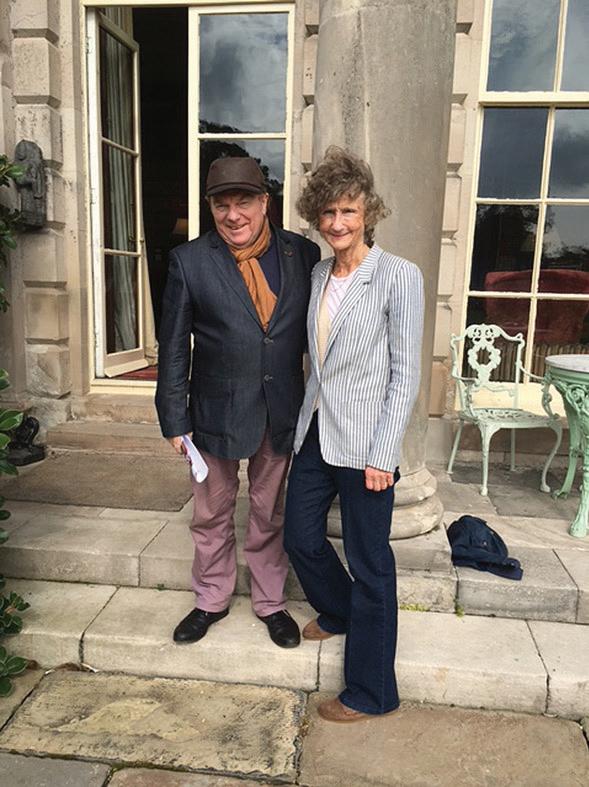
They added to and conserved their historical collections and knew and understood their significance – without displaying any pomposity.
Once, leafing through the books in the
Clandeboye library, I came across a book on Troy by Heinrich Schliemann, the German archaeologist who’d discovered the site of Troy in the 19th century. To my astonishment, there was a letter stuffed inside the book from Schliemann to the 1st Marquess, written in ancient Greek.
I rushed to Lindy, full of smug pride at finding the letter and my ability to read the Greek. She was interested from a historical point of view – but she never showed any of that distasteful pride herself in her considerable possessions and achievements.
With all her gifts in mind, I felt a book should be put together in Lindy’s honour. In part, it was to remember her painting, her mercurial nature and her gifts for sweet kindness and uniquely funny conversation.
But this book is also to remember the way she reacted to the deep tragedy of Sheridan’s early death – and what she did at Clandeboye.
After a period of intense grief on Sheridan’s death, Lindy took up painting again with renewed verve and originality, and reinvigorated Clandeboye.
It’s like the Old Testament story of the honey in the beehive that grew inside the dead lion – captured on the tin of Tate & Lyle golden syrup: ‘Out of the strong came forth sweetness.’
The Last Marchioness: A Portrait of Lindy Dufferin, edited by Harry Mount, is available at www.heywoodhill.com or on 0207 629 0647
The Oldie August 2023 27
DAVID HOCKNEY
The Lady & Sir Van: with Van Morrison
‘She had no neutral gear,’ said her friend Tom Stoppard

Temple of the steam age
Some great souls have helped preserve London’s architecture – as gorgeous, monumental and distinguished as the buildings themselves.
William Morris, John Summerson, Mark Girouard, various Guinnesses, Ian Nairn, Spike Milligan, Michael Heseltine, Lord Duncan-Sandys, Nikolaus Pevsner and the poo-bah teddy bear of them all, Sir John Betjeman.
And me. I feel unworthy to step into the clumpy shoes of John Betjeman. Surely I ought, humbly, to slide in through a back door and lurk in a well-proportioned, shadowy corner.
But I have been appointed President of the campaign to save Liverpool Street Station.
We have to stop a new threat. A cross between a monstrous killer squid and a bloated white elephant is threatening to engulf dear old Liverpool Street. We need to start shouting again.
I have used this great 1870s terminal all my life. That’s, frighteningly, for almost a third of its existence.
I started when it looked a bit more like Edward Bawden’s sooty and dramatic linocuts. I’ve ambled through the station, lazily heading for appointments. I’ve sat waiting for that hourly Norwich fast
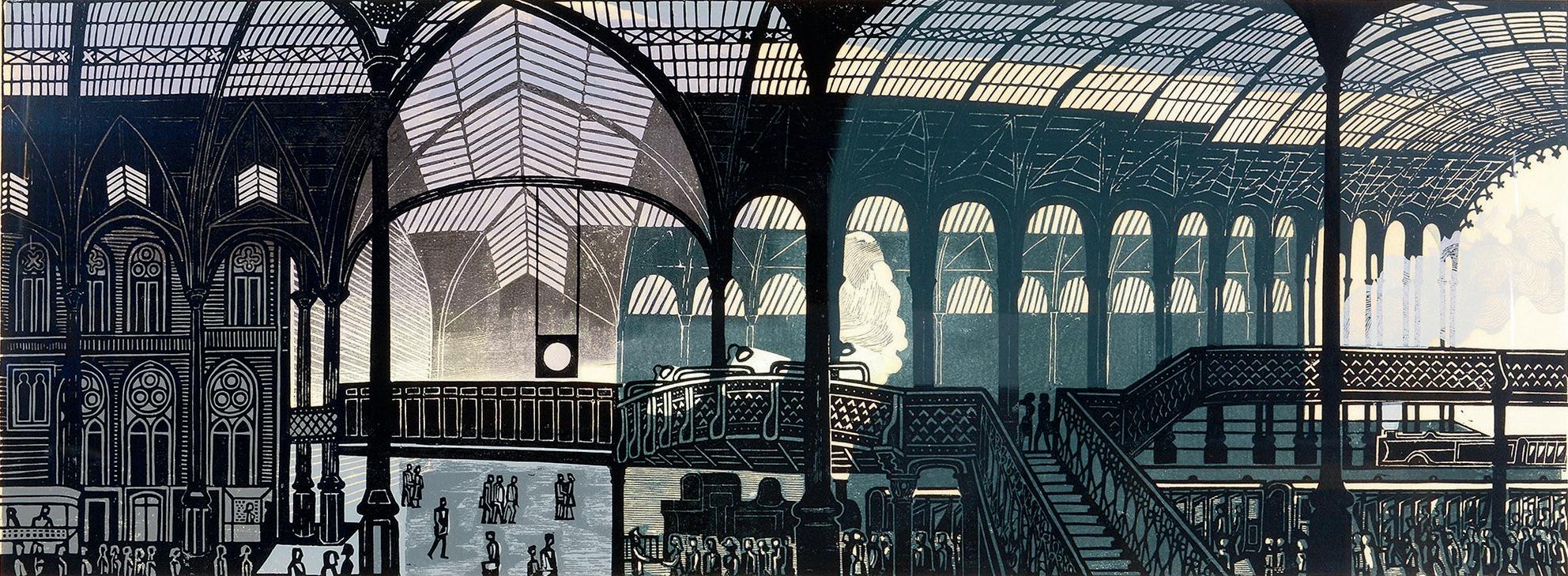
train. I’ve charged across the concourse, desperate to get the last train to Suffolk after appearing in the West End, on a Saturday night – not always a happy experience.
Once in the late eighties, after speeding through the final act of some low farce, I threw myself into a carriage. The last door banged shut. I found myself in a compartment with 20 members of an East End rugby club off their faces and on their way to continue a stag celebration at Hollywood, Romford’s première nightclub.
I have endured criticism of my sketchcomedy output in broadsheet newspapers. But as we drew out of Liverpool Street Station that night, I was glad I had made all those dick jokes on stage. This was my audience. Though already falling down drunk, and seemingly well-up for a fight, they formed an orderly and savagely disciplined queue.
Each got their turn to enquire about Pamela Stephenson’s embonpoint or Mel Smith’s jollity. When one of them threw open the carriage door for a bit of fresh air, the others beat him up for endangering their pet Griff.
But this is what Liverpool Street Station is. You’re not heading to poncy Edinburgh. It’s a Lunnon station with
a proud history of short noisy trips into Essex. Bugger around with it at your peril.
The rugby club is not in the market for Louis Vuitton or seaweed moisturiser. We Essex and Suffolk people like our Victorian railway station and don’t want it to be left peeping out of some developer’s wet dream of avarice.
Last Monday, I walked out from Bloomsbury to get a sense of the City, the immediate London, that this station serves.
I certainly noticed how distinguished the entire place seems to have become. It was a stroll through well-tended streets, past little, carefully brushed architectural gems, not just the Wren churches, but the Armourers’ Hall, the restored Girdlers’ Hall and stunningly conserved miniature gardens.
It made me wonder why on earth Liverpool Street Station should fall through this net. Shouldn’t this simple and striking piece of architecture be similarly manicured, its girders primped and its terracotta frontage brushed up and polished?
Next door to the station is a Richard Serra sculpture, Fulcrum. It has been carefully protected while they rebuild Broadgate. They have smashed the
Liverpool Street Station, a great Victorian building, is threatened by a hideous development. We must stop it, says Griff Rhys Jones
The Oldie Auguts 2023 29
Edward Bawden’s Liverpool Street Station (1960). In 1874, Edward Wilson built the station in Early English Gothic style
1985 masterpiece of Broadgate – to the horror of the Twentieth Century Society – into a pit, in order to pump up the site.
But, let’s face it, the station is a work of art, too – isn’t it? Because it’s owned by the rapacious and permanently cash-strapped Network Rail, however, nobody wants to cosset it. They have to exploit it in some way. So they have decided to market the ‘air space’ directly above it.
The bizarre, Swiftian notion is to build 800,000 square feet of office space directly on top of the existing concourse. The whole Bishopsgate conservation area will be compromised by its scale. To the east is the former Great Eastern Hotel, where John Betjeman got married.
They claim the Grade II*-listed first grand hotel in the City and the original train sheds to the north will ‘not be harmed’. This depends what you mean by harm. The hotel is already six storeys high with turrets, cupolas and romantic spires. The building would be left peering out from underneath a further ten storeys, cantilevered over its roof and dropping down its side to engulf the place.
Mind you, the area around Liverpool Street Station is a greedy district. There are fat, bulging moneymaking offices reaching into the heavens on every side. And why? Because they are such a short walk from this glorious station, that’s why.
Network Rail, however, are clearly jealous. They have a valuable site – just with a damned inconvenient national monument sitting on it. Can they join the big boys?
Having arrived, I walked past Lush and Marks & Spencer, down a narrow passage to a vantage point that reveals the full glory of a sadly neglected treasure. The windowpanes in the ceiling, supposed to suffuse this simple and glorious structure with light, are blackened, yellow and grimy.
The rear is also a shock. A huge, new steel basket – a Marvel Comics block – glowers at the station across another of these carefully tended financial-district designer gardens, called Exchange Court.
The rear of the sheds is blessed with a wonderful gable detail. Long, whitepainted ‘station woodwork’ hangs down in an undulating rhythm of pointy arcs.
Closer examination, though, reveals that the paint is faded and peeling; the planks are starting up and rotting. Unlike the shiny seats and nodding alliums in the planters, the preservation of this most essential part of the park is not being paid for by anyone.
London has recently regained some excellent working railway-age monuments. The almost modern 1850s front of a bare and unadorned yellow King’s Cross is striking, impressive and bold. It has been allowed to become the major statement that it was always meant to be.
Next door is St Pancras, rising up some 15 years later, and very different –that glorious puce cathedral of the railway age. Betjeman’s statue now stands there: justifiably his finest victory. At last, we seem to have recognised that the stations themselves are part of our London story.

Liverpool Street may be, by contrast, a starkly practical, serried rank of triangular roofs. But I think it is all the better for that. It has long been a
working commuter station for a working City of London.
When Ilford and Romford became rows of semi-detached Metroland in the 1890s, local rails had to be laid alongside the long-distance ones to serve the daily rush of commuter ‘clerks’.
The departures board that once highlighted Harwich and the Continent (or Frinton and the incontinent) directed thousands out to Ponders End and Manor Park, Hatfield Peverel and South Woodham Ferrers, Rochford and South End. I think it sounds like a poem.
Any sane policy towards this station would emulate King’s Cross and clear Bishopsgate of the ghastly recent excesses in front of it – to free it to stand as the monument that it is.
Instead, Network Rail have launched a
30 The Oldie August 2023
John Betjeman’s statue, St Pancras Station. Betjeman compared Liverpool Street Station to a cathedral, with a café where the altar would be
cloak of self-righteous nonsense to mask their Monopoly money fantasies.

They claim they are ‘providing ten thousand jobs’. Really? They are giving jobs to temporary workers in the construction business, maybe. God help us if, like the Old Street roundabout, this takes several lifetimes to complete.
But what sort of wonky reasoning assumes that if you build new offices, they will fill up with new jobs? In all probability they will move in from other offices, won’t they?
They claim they are ‘sustainable’. This is extraordinary. The word is tacked onto everything and, this time, is particularly meaningless. The huge construction they plan to throw up would generate tons of carbon emissions.
According to the latest research, the demand for office space will not return to pre-Covid levels until 2030, at the earliest. The rush hour has had its day.



Nothing is less green than the constant urge to import thousands into the City every day. Arup and the LSE tell us the City needs ‘quality’ – and how do you get that? By preserving your heritage assets, not by trashing them.
The developers claim that the City of London ‘needs a world-class transport hub’. Liverpool Street already has precisely the sort of Victorian, Baker Street, Mary Poppins glamour that visitors come to see. By all means, improve its Victorian elements. That’s what the last reconstruction did so admirably. But why turn it into a new, shiny, white anonymous toy?
‘It’s all delivered at no cost to passengers or the taxpayer,’ they say. What is? Acres of unnecessary office floor? Hotel rooms? Shops?
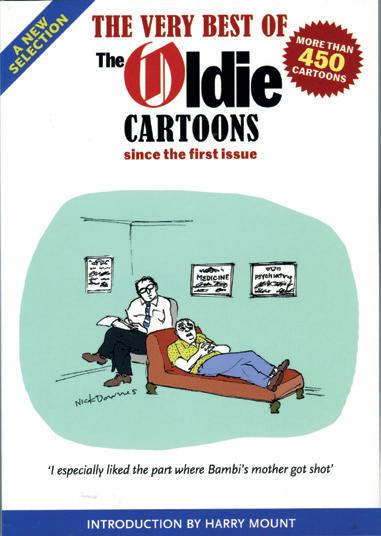

What they mean, apparently, are the ‘urgent improvements’ to the station itself.

The biggest fib in their ‘consultation’, which took place just a fortnight before the planning application, is that they have tried desperately to hide the offices and the new hotel floors.
They claim the station doesn’t have enough disability lifts or escalators. They will apparently provide £450 million of improvement utterly free. But hold on! It doesn’t cost £450m to stick in a disability lift. Or two disability lifts and five escalators. Or five disability lifts and six escalators. But it does cost that to create a shopping centre.
If the improvements are urgently needed, then Network Rail should provide them urgently.
They claim the current layout is ‘not fit for purpose’. Really? When I was last




there in a rush hour, the only queue was at the bottom of the escalator out of the Elizabeth Line: a spanking new chunk of spacious, high-ceilinged, architectdesigned tunnel. The lack of proper priorities in that modern ‘solution’ doesn’t fill you with hope for other new ventures.
You may well believe that after the tragic loss of the Euston Arch, a dirty great soot-covered propylaeum, and the demolition of Bunning’s Coal Exchange, after the formation of the Victorian Society, the Twentieth Century Society, SAVE and even the Thirties Society, after Town and Country Planning acts and listing, there are plenty of watchful eyes on our heritage.
But Smithfield Market was preserved only recently. The area behind King’s Cross was stopped from being razed after painful consultation. Great urban planning, mixing old and new, was the result. We have to continue fighting.
I recall campaigns in London not only for Smithfield, but also for a workhouse in Cleveland Street and the University of London’s terrace opposite St Clement Danes. (The latter is looking very shabby, I noticed. Hope they are not letting that die by neglect.) I also spent 20 years raising cash for the rehabilitation of the Hackney Empire.
We have good legislation, we have statutory guidance, we have conservation areas, local plans and archaeological preservation orders.


They are there to monitor and control what goes up and what comes down. But someone needs to make sure that these considerations are properly policed –especially when greedy councils and corporations are seeking parts of the profit for themselves. This one will save the economy/your city centre/your railway network/the planet.
Concerted planning protest is rare. Ninety-five per cent of applications go through utterly unopposed. That’s fine. Some shouldn’t.
We need to go to the sound and intelligent existing law to stop this assault on Liverpool Street Station. Sign and share the petition (www. change.org). Join us in protest. Join the Victorian Society. Let’s make the requisite process to prevent big money and expensive lawyers running roughshod over London’s heritage.
We all need to be great souls and get out of the shadows.
* Europe/Eire: £58; USA/Canada:£70; Rest of world: £69 To order your subscription(s), either go to www.subscription.co.uk/ oldie/o ers or call 01858 438791, or write to Freepost RUER–BEKE–ZAXE, Oldie Publications Ltd, Tower House, Sovereign Park, Market Harborough LE16 9EF with your credit-card details and all the addresses. Always quote code POLD0823 This o er expires 31st August 2023. Subscriptions cannot start later than with the October issue WHEN YOU TAKE OUT (OR GIVE) A 12-ISSUE SUBSCRIPTION FOR £49.50* SAVE £13.50 over 12 issues BEAT THE PRICE RISE AND GET TWO FREE OLDIE BOOKS WORTH SPECIALBUMPEREDITION The Pick of the All-Time Best With an introduction by Harry Mount Annual 2023 CONTRIBUTORSINCLUDE:AUBERONWAUGH,WILLIAMTREVOR, MILESKINGTON,GILESWOOD,BERYLBAINBRIDGE,JANMORRIS, TOMCOURTENAYANDRAYMONDBRIGGS PACKED FULL OF CARTOONS £14.90
Griff Rhys Jones is President of the Liverpool Street Station Campaign (LISSCA)
Phoenix from the flames
Plucky Harriet Crawley – who lost her two brothers, mother and husband in tragic accidents – has written a gripping thriller. By David Ambrose
Harriet Crawley’s mantra has always been ‘Life is not a sprint, but a marathon.’
This is just as well, considering the head-spinning number of careers, relationships, tragedies and triumphs she has packed into her 74 years.
We have been friends for 55 of those years. I’ve just been to the packed launch party of her fourth novel, The Translator, flagged by both the Times and the Sunday Times as their Thriller of the Month.
But it had not been plain sailing. On its initial submissions, even though it was in the hands of a top literary agent, the novel hit the buffers.
Her son, Spencer, who works in venture capital, tried to keep her spirits up, saying, ‘Mum, all you need is one person to say “yes”.’
That person turned out to be François von Hurter, founder of Bitter Lemon Press, a small independent publisher.
The Translator deals with a Russian plot to cut the undersea communication cables linking Britain to America and cripple our economy. Recently the First Sea Lord warned of just such a possibility. Where had Harriet got the idea from? From a paper written for the Policy Exchange think tank in 2017 by a little-known MP called Rishi Sunak.
I have known Harriet since she published her first book at 19. A Degree of Defiance was about the student riots in Europe in 1968. Her fluency in French, German and Italian, a great help in the endeavour, was a legacy of a bohemian yet sophisticated education and an interesting background.
Her father was Aidan Crawley (1908-93), first-class cricketer, fighter pilot, a Labour and Tory MP, writer and pioneering TV journalist and editor.
Her brilliant and elegant American mother, Virginia Cowles, had been one of the great war correspondents of the Second World War before turning her hand to history and biography – until her death in a car crash in 1983.
All this left Harriet and her two
brothers, Andrew and Randall, with a lot to live up to. The family was noisy, closeknit and adventurous. And not rich. Everyone had to earn their own living.
Harriet kicked off in television and radio. Within a few years she and her brothers had started an art business, and were living first in Tehran, then in Hong Kong, then travelling the world. Her first novel, The Goddaughter, was published in 1975.

She stood as a Conservative candidate for Brent East against Ken Livingstone in 1987. She announced she was pregnant after a brief affair and would not be naming the father.
‘Why embarrass him?’ she told me. ‘He doesn’t want to be a father. But I do want to be a mother. And I can support myself.’
She had the full backing of her association, and she slashed Livingstone’s majority.
She was preparing to stand as a candidate for London Central in the European Parliament when tragedy struck. On 10th September 1988, her two brothers took off from Turin in a Cessna to fly to Oxfordshire and join Harriet for her 40th birthday. The plane crashed and they were both killed, leaving small children and pregnant wives.
‘When my brothers died, I knew there was only one way forward: work and change.’
She lived with her grieving father until he died, published a second novel and
then married Gleb Shestakov, a Russian 17 years her junior. They moved to a writers’ village outside Moscow and placed her son in a state school. ‘With Gleb, I could put all the terrible sadness behind me and start a new life.’
It was around this time that she lost all her money in Lloyd’s. She says, with a sigh, ‘That was another nightmare.’
She restored her fortunes by starting her own art business in Moscow. The marriage to Gleb didn’t last, although they have stayed friends and he is devoted to her son.
In 1999, in London, she met the love of her life, Julian Ayer, adopted son of the philosopher Freddie Ayer. ‘I had five years with Julian,’ she told me, ‘five years that changed my life. I loved him with every fibre of my being.’
In 2004, they went to watch Spencer play cricket for Harrow in Sri Lanka, and on 26th December Julian drowned in the tsunami:
‘We were in a public bus together. He pushed me through an open window … he saved my life, but he couldn’t save his own.’
Even though she was only 55, she knew with absolute certainty that she would never have another relationship. ‘No one could follow Julian.’
A few months later, a Russian friend who ran a gas processing company in Moscow offered her a job at a technical publishing company. She would translate impossibly complicated books such as Gas Well De-Liquification from English into Russian.
‘I thought he was mad,’ she said, ‘but it was a lifeline.’
The job lasted ten years. Then Putin put the squeeze on small independent companies, and her friend went under. She left Moscow for good in 2016 and started The Translator. Topical, suspenseful and above all a love story.
‘Of course,’ she says. ‘What else could it be?’
32 The Oldie August 2023
The Translator (Bitter Lemon Press, £16.99) by Harriet Crawley is out now
Harriet: writer, politician and translator


I ran away to sea
After 25 years as a cruise-ship lecturer, David Pybus adores life on the ocean wave
My cruise-ship career started last century with a phone call which I thought was a scam.
I was known as the Indiana Jones of Scent after my career in the perfume business. The career has its advantages. If I didn’t come home smelling of perfume, my wife would shout, ‘Where the hell have you been?’
The man at the other end of the phone asked if I would like to give a 45-minute talk about perfumes on a two-week cruise for me and my wife in the Indian Ocean. I hung up. The next call, a few minutes later, was more insistent and infinitely more believable.
After many years aboard, I’ve grown used to all the jokes on the moreadvanced-age cruises: ‘I’m the only one on board with my own hips;’ ‘Even the portholes are bifocal.’ The best one was ‘I don’t know how old the lady is that I danced with last night but her National Insurance number was 4!’
Despite my decades at sea, I must still look young for my age – they haven’t started to put prunes on the pillow at night instead of chocolates.
I now have 52 presentations – like a pack of cards. Crossing the Atlantic, I have a talk on my Dragons’ Den experience, recreating perfume found on the Titanic. If it’s Norway, it’s Vikings. If it’s the Caribbean, it’s got to be pirates.
As most cruise-directors came from the dancing and singing world, they lean towards favouring that kind of entertainment. Speakers are way down the list of importance, often because we are sage and experienced and they frankly don’t understand us or our topics.
The hierarchy goes like this:
• Celebrities
• Song and dance groups
• Singers
• Comedians
• Magicians
• Ship’s personnel
• Speakers
Within the speaker family, there’s another hierarchy:
• Celebrity speakers who talk of their experiences in sport, comedy or politics
• Destination speakers who give port talks on the itinerary destinations
• Special-interest speakers on everything from ‘Moths I have known’ to ‘The bones of the body’
• Craft nstructors for talents from banjo-playing to making sprinkled Christmas cards
• Jobbing speakers like me, the Jacks and Jills of all trades
There are talks to avoid if you aren’t an expert. Politics, sport or religion can foment mutiny or a minor punch-up.
And be prepared for varying audiences. In a 600-seat theatre, a crowd of 20 isn’t exactly enthralling.
This gets particularly bothersome when you are on at the same time as the big football match shown live, an interview with the captain or the final of the quoits championship.
Worse still, the captain may decide to make a prolonged announcement about the age of a nearby Norwegian glacier, right in the middle of your presentation. The ability to mime or tap-dance comes in handy at these moments.
Fear of public speaking is said to be a greater worry for the British than the prospect of dying. At least it keeps me in work. But who’d have thought that, at a funeral, people would rather be in the coffin than giving the eulogy?
In the bad old days before 2010, speakers were designated as crew, and given crew cabins. This could be a cabin with a torpedo-tube porthole or one next to the morgue – quiet enough, I suppose.
If you were lucky, you’d get upgraded to a ‘condemned’ passenger cabin, which had either a restricted view, such as of a lifeboat across the porthole, or noise from a dough-making machine in the bakery above, which started at 4am. My least favourite was one I christened the Anchor Suite (no prizes for guessing why).
Despite these little grumps, I love it. I’ve travelled the world (115 countries and islands to date), been on great cruise liners and met some fabulous people who are all out to have a terrific holiday.
And they do make me chortle with their queries and complaints. One was upset that he couldn’t get his daily paper. At the time, we were four days out into the Atlantic. I imagined the little newspaper lad frantically rowing his dinghy to catch us up.
I once heard a frightened lady approach the captain with the worried comment that there was water going down the stairs – it was a force 8 gale. He responded, ‘Madam, the time to concern yourself is when the water is coming up the stairs!’

And the question ‘Do the crew sleep on board?’ always gets a chuckle.
Life at sea does sometimes leave you all at sea. But I wouldn’t miss it for the world.
34 The Oldie August 2023
Ocean notions: Brigitte Bardot and Dirk Bogarde in Doctor at Sea (1955) COLLECTION CHRISTOPHEL / ALAMY
Joy of being a has-been
Julian Neal went from top doctor to dawdler – and loved it
Iam a ‘has-been’, a ‘former this’, an ‘ex-that’ and a ‘past everything’. Although my children never believed I was anything other than an embarrassment, there was a time when I was quite a big fish in a small pond, with some influence in larger lakes. I was a GP and senior partner in a Portsmouth group practice.
But now I’m more plankton than fish – a piece of flotsam, all washed up.
An early intimation of life as a has-been occurred shortly after I retired for the first time (it took me four attempts over five years to stop working) when I found myself in a supermarket early one Monday morning.
Apart from the absence of working-age people, it was the sight of dejected-looking older men, meekly pushing trolleys a couple of obedient paces behind their bustling wives, that left an indelible image.
I recognised some of these old fellows: a former chief executive, a recently retired GP, and a retired admiral. As they trundled around the supermarket, obsequious and forlorn, I thought to myself, one day this will be me!
But life as a has-been is not at all
unpleasant, providing one is fortunate enough to be financially secure and in reasonably good health. It doesn’t have to be endless days visiting garden centres, interspersed with crossword puzzles and daytime TV. I am more content with my lot now than at any time in my adult life.
For Father Time, so long an everpresent, hectoring sergeant major barking out orders and deadlines, has become a friend. Without the tyranny of emails, countless meetings and long commutes, I have time to stand and stare.
Because of the recent pandemic and lockdowns, I have had ample opportunity to stand and stare; to observe Nature’s cornucopia of wonders. A bumble-bee ponderously hovering a few inches above the ground in early spring searching for a family home, a red kite spiralling heavenward on invisible thermals or the subtle scent of a bluebell carpet drifting on the breeze – these are just a few examples that have captured my attention for many languid moments.
Time has become a friend, as days meander into one another. Time to think; to reflect on one’s past, to rekindle an interest in mathematics and to write
poetry. Freed from the prosaic, I now play more chess, saunter along country lanes and scramble up hillsides.
Of course there are downsides. Joints and muscles ache a little more. Pills are popped with increasing regularity and friends become ill, as the era of four weddings and a funeral becomes four funerals and a wedding.

But the grim reaper aside, life, for an indeterminate period, is more about play and old dogs being taught new tricks, which for me, unexpectedly and astonishingly, has meant learning to fly. I am on course to gain a private pilot’s licence before the year is out.
I realise belatedly that I have had the immense good fortune to belong to that lucky generation who have thrived in a postwar period of economic prosperity, peace in Europe (until recently), affordable housing and loan-free education.


Meanwhile, science and technology have relieved much of the physical burden of living. Combined with social change, this has led to greater freedom, opportunity and tolerance.
How this has-been is enjoying his great fortune in later life.

The Oldie August 2023 35 ALAN STRUTT / EAMONN MCCABE / POPPERFOTO Sponsored by Literary Lunch 5th September 2023 At the National Liberal Club, 1 Whitehall Place, London SW1A 2HE TO BOOK TICKETS email reservations@theoldie.co.uk or call Katherine on 01225 427311 (Mon-Fri 9.30am-3pm). The price is £79 for a three-course lunch including wine or soft drinks ● Fish and vegetarian options available on advance request ● Meet the speakers from 12 noon; lunch at 1pm ● Authors speak 2.30pm Forthcoming dates at the National Liberal Club: 17th Oct, 14th Nov, 12th Dec Michael Crick on One Party After Another: The Disruptive Life of Nigel Farage Cleo Watson on Whips A Westminster tale by an insider Jane Ridley on George V: Never a Dull Moment
Night train to Hell
Prue Leith loved the romance of travelling overnight – until she and her husband squeezed onto the sleeper to Edinburgh
There is something lovely about sleeping cars. Maybe because it’s the only way grown-ups get rocked to sleep.
As a child, I would ride the Blue Train from Johannesburg to Cape Town and fight with my brothers for the top bunk. The excitement of travelling without Mum and Dad would keep us awake until the steady rocking and creaking would send us to sleep.
We’d be woken in the morning by the steward, smart as paint in his starched white uniform, delivering tea. We’d roll up the blind to see the open plains of the Karoo, or the magnificent Drakensburg.
As a board member of the Belmond Hotel company (the ex-Orient Express group), I got to ride on all sorts of posh trains, and loved them all.
On the restored Orient Express to Venice, I woke to a tray of Italian coffee, fresh croissants and the New York Herald Tribune, with Mont Blanc through the window, shining in the sun.
The Eastern and Oriental Express crawls up the Penang Peninsula from Singapore to Bangkok and has private loos and showers. Sadly, we sometimes stopped in the night to let a few hours go by, and the rocking stopped.
Best of all was touring the Highlands on the Royal Scotsman, also with private mod cons, and accompanied by a whisky buff to educate us in the finer arts of drinking Scotch.
But the modern Caledonian Sleeper, from London to Scotland, is a crashing disappointment. Sixty years ago, the bunks were a decent width, the bottom one low enough to give the top one room to sit up in, and a ladder with wide comfy treads.

The bunks had a two-foot shelf with an edge to it to stop your book, spectacles, etc from falling off and a dip to hold your glass or bottle. The walls were covered in a thick velvety cloth with a brass hook and a little round recess for your watch. The coathangers were padded so they wouldn’t rattle, and the
basin had brass taps and Pears Transparent soap.
Some time later, the sleeper cars got a makeover, and the velvet walls, brass fittings and mahogany woodwork disappeared. The bunk shelves were replaced by a net fixed to the wall for your night-time possessions. The nostalgia had gone but at least everything still worked.
Not so today. Having heard that the much-trumpeted new Caledonian Sleeper had private bathrooms and double beds, my husband and I booked tickets to Edinburgh from Euston.
On arrival, we were told our room was unavailable, but they’d managed to find us an identical one. It turned out not to be a double bed or even twins, but two super-narrow bunks, one above the other. We protested.
The steward explained, ‘This is a common misunderstanding. People think “double” means double bed, but it means two beds. This is exactly the same as the one you booked.’
Well, I am 83 with a dodgy ankle and John, my husband, has just had a knee op. We didn’t think either of us could climb up top. But since it was now 11 at night, too late for a plane, and I was due
to shake 1,200 graduating students’ hands the next day (I’m the Chancellor of Queen Margaret University in Edinburgh), we had no option but to be grateful.
No one has given any thought to the design of the bunks. The ladder is vertical, fixed hard against the bunks with narrow, ridged metal treads, which are agony on bare feet.
There is so little space above the top bunk that you must start to lie down before you get your knee over the top. There are padded boards to stop you falling out, which also make getting in, at least for me, almost impossible.
There is neither a shelf nor a net. Probably the new bunks are too narrow to allow for one. There is a little contraption behind your head which charges your phone and takes your water bottle, but nowhere for your book, glasses or anything else.
If getting in was difficult, getting out was worse. One of the bores of old age is needing a wee in the night – sometimes twice. I’d have liked to descend the ladder backwards, but there wasn’t room to roll over and kneel up.
I tried to come down with my back to the bunks, but my heels slipped off the ladder and I fell the few feet to the floor, fortunately half-caught by John.
Next time, not wanting to wake him again, I managed to climb down via the wash-basin. John woke anyway and suggested that we tuck up, like teenagers, head to toe in his bunk. Not a success. He still has a lot of post-op pain and needs to roll over. He slept on the floor.
We thought a Scottish breakfast of kippers, haggis, black pudding, toast and marmalade would revive us. It was dire. The dining car is soulless, the fare miserable. My yogurt and granola came in a sealed carton, with disposable spoon.
A fare of £390 for two is a lot to pay to get no sleep.
36 The Oldie August 2023
Prue Leith presents The Great British Bake Off
SCREENPROD / PHOTONONSTOP / ALAMY
Bunk-up: Cary Grant and Eva Marie Saint in North by Northwest (1959)
Message to the BBC – the party’s over Why is the media obsessed with party politics? Nobody else is a n wilson
When we oldies were young, the BBC abounded in interesting discussionprogrammes in which party politics was never mentioned.
There was, instead, the sense that the radio – later the telly – were like intelligent dinner tables or tutorials. There was still a Reithian sense that the public broadcaster could provide, in accessible form, what the Athenians had sought in Plato’s Academy.
There was the Brains Trust, in which figures such as C.E.M. Joad or Bertrand Russell attempted to answer questions sent in by the listeners.
In its glory days, 12 million people –around 29% of the population – tuned in on Saturday afternoons to hear Isaiah Berlin, Kenneth Clark and Harold Nicolson give their intelligent, rounded views.

Sometimes, the BBC received letters of complaint about the programme’s supposed political bias. But when the speakers were surveyed, it was discovered that 25% were left-wing, 28% were right-wing and the rest could not meaningfully be labelled.
I suspect that this proportion is true, to this day, of the population at large. Certainly, we do not belong to political parties much.
This is for the very good reason that – in England, at least – the political parties do not really represent our opinions.
This is a very good thing. In Northern Ireland, where the parties DO represent “grassroots” opinion, they find themselves in an ungovernable deadlock of mutual hatred. They can not even bring themselves to sit down together at Stormont.
Party membership has hugely declined in the last fifty years, along with membership of churches and trades unions. We do not want to be classified.
Yet, with each passing year, the BBC
tries to pretend we DO all divide along party lines.
The news programmes give a quite ridiculous amount of time and space to the ins and outs of party politics, and to the possible contents of these parties’ manifestos. Why should we care?
Those of us who choose to vote at the next election (this will not include me – I have not voted for years) will do so because they want to vote AGAINST another party.
Few lefties actually like Keir Starmer, but he will attract the votes of those who, with very good reason, have come to hate the Tories. And those who vote Tory will do so, not because they like the Conservative Party – an odious organisation, all of whose actual members are nerds, Rotary Club bores or lonely young men who think it smart to wear hired dinner jackets at ‘black tie dinners’ – something most of us have either never done, or not done for years.
Consider a programme such as Any Questions. Again, when we oldies were young, lucid, clever people such as Marghanita Laski or Malcolm Muggeridge would regularly appear and give their well-modulated views.
Now the programme has become entirely political, and party political at that. Chris Mason, a weaselly little fellow in specs who has recently become BBC political correspondent in succession to Laura Kuenssberg, took to introducing speakers on the programme with party labels.
‘Diane Abbott – for Labour,’ he might say. ‘Bernard Jenkin – for the Conservatives.’ Why not simply ask their views as individuals?
It is absurd to suppose that the Westminster parties, a few hundred nobodies whose chief interest in life is holding on to their seats, and who trim and concoct their ‘manifestos’ with this aim in mind, should have drawn up a
programme for life that we all want to follow. Old John Mortimer used to ask why should socialists not support fox-hunting – as Friedrich Engels had done?
The quality of Any Questions is now deplorable, and the torture of listening to it – which I only do in the car when my dear wife wants to tune in – is augmented by the sad old crocks who ring in on Saturday afternoons to bore for Surrey or Cheshire in response to the party politicals.
The BBC has absolutely failed in its duty to allow a proper debate about public issues. No political party would dare to go to the polls saying a word against the NHS, for example.
Both main parties, egged on by the Lib Dems, think we should be sending billions of taxpayers’ money to aid the mutual slaughter in Ukraine. It would be more or less impossible to find a voice on the radio questioning this course of action, which, to many of us, seems a criminal wickedness. Those who consider abortion to be the inadmissible taking of a human life could not, I suspect, find anywhere on Radio Four who would allow them five minutes of airtime –because no political party would dare include a pro-life clause in its manifesto.
If I were Director-General of the BBC, I would ban the mention of party politics at all, except perhaps at election time. Otherwise, I’d make the news editors and the producers of discussion shows remember the ideals of Lord Reith and to read Lord Macaulay:
‘Then none was for a party; Then all were for the state; Then the rich man helped the poor, And the poor man loved the great; Then lands were fairly portioned, Then spoils were fairly sold; The Romans were like brothers In the brave days of old.’
Oldie Man of Letters
The Oldie August 2023 37
The strange invention of Late Antiquity
What makes a good historian?
A new book, Journeys of the Mind, by one of the best of the past 50 years, Peter Brown, promises some answers.
Brown is the pioneer of a whole way of looking at a historical period, ‘late antiquity’, between the fall of Rome and the beginning of the Middle Ages. It includes the rise of two great religions, Christianity and Islam.
When he began his studies, back in the 1950s, Brown tells us, there wasn’t even an accepted name for the period he wanted to study.
A French historian suggested a German coinage for antiquity (historians then read French, German, Latin and Greek with enviable ease): Spätantike. But it was Brown himself, in his magnum opus The World of Late Antiquity (1971), who popularised the English version.
Brown had dealings with some of the towering minds of the age, from C S Lewis to Michel Foucault.
But good historians, he realises, do not live in the mind alone. He has a story to tell of his own background, as an Irish Protestant from Dublin who negotiated the worlds of English and American academe. Later, he ‘was sometimes left feeling that it was easier to explain to young Americans and Europeans the institutions of Dark Age Europe than the workings of Oxford in the 1950s and 1960s’. He decided that ‘I had to explain myself by becoming a historian of myself.’
His own Christian background meant he ‘expected religious ideas to be powerful and have an impact on society’. He remembers ‘being puzzled … by the polite indifference of so many of my English friends to the role of religion’.
As an undergraduate, he attended, and became a convert to, the ministry of Billy Graham, and later flirted with Catholicism. If you want to study the genesis of world religions, it probably
helps to have some sympathy with the religious life.
The greatest historian of Brown’s period was Edward Gibbon, author of The Decline and Fall of the Roman Empire. Brown felt himself to be ‘following in the footsteps’ of Gibbon. Gibbon himself wrote a memoir, beginning when he was 52, but had completed the Decline and Fall. It’s a good thing he didn’t wait, as he died aged 56; the book, the Autobiography, was published posthumously.
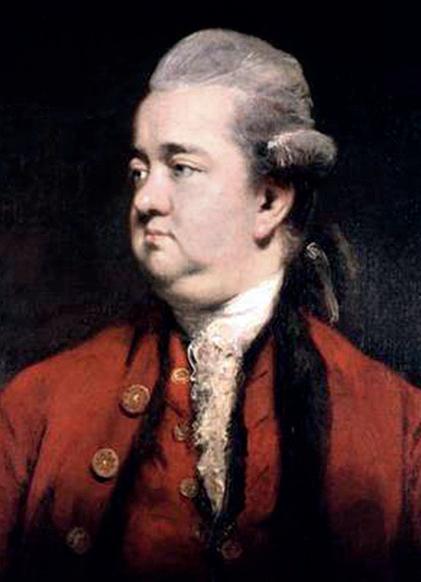
Like Brown, Gibbon attended Oxford, as a ‘gentleman commoner’ at Magdalen. Gibbon said it was the ‘most idle and unprofitable time of his life’: ‘The fellows of my time were decent, easy men, who supinely enjoyed the gifts of the founder; their days were filled by ... uniform employments; the chapel and the hall, the coffee-house and the common room, till they retired, weary and well-satisfied, to a long slumber. From the toil of reading, or thinking, or writing, they had absolved their conscience.’
While Brown had been free to question his religious upbringing, Gibbon’s youthful embrace of Catholicism led to his ejection from Oxford, at a time when ‘popery’ was feared and legislated against. Gibbon’s first journey of the mind, and to a tutor in Lausanne, was made of necessity, as at home he was persona non grata
Like Brown, Gibbon’s formation as a historian was made mostly through books. Not just history books: Gibbon read as deeply in philosophy as Brown did in anthropology. He treasured his youthful meeting with Voltaire.
But even the cerebral Gibbon lived outside his intellect, if sometimes reluctantly. The Autobiography describes a ‘bloodless and inglorious’ interlude in
charge of a company of Hampshire militia.
He resented being taken away from his books, but he admits ‘the captain of the Hampshire grenadiers (the reader may smile) has not been useless to the historian of the Roman Empire’. It gave him a ‘clearer notion of the phalanx and the legion’.

Unlike Brown, Gibbon, despite knowing ‘that from my early youth I aspired to the character of an historian’, didn’t fix early on a subject. He thought of writing about Sir Walter Raleigh, the Swiss and the Medici, while rejecting everything from Richard I’s crusade to a comparison of Henry V and the Emperor Titus.
Brown has lived through the era of ever-increasing specialisation. Gibbon, a private scholar with no academic duties to fulfil, was for some time a victim of too vast a sphere of interest.
As with Gibbon’s epiphany ‘amidst the ruins of the Capitol’, Brown experienced moments of inspiration on his journey to being a historian. Brown mentions among them his visits to the Scala Cinema to see Japanese samurai films, ‘a touch of the utter strangeness of another Middle Ages’.
Gibbon’s trickiest obstacle wasn’t researching his subject, or deciding its parameters or even its general argument. It was the style of the book: ‘Many experiments were made before I could hit the middle tone between a dull chronicle and a rhetorical declamation.’
Some 250 years later, Peter Brown thinks the same qualities are still important for a historian: ‘To write well, to spread knowledge and to widen sympathies by the use of the pen.’
Journeys of the Mind: A Life in History by Peter Brown is out on 1st August
38 The Oldie August 2023
History
Edward Gibbon remains the best historian on the fall of the Roman Empire david horspool
Gibbon (1737-94)



Town Mouse

John McVicar’s advice on fights? Run away
tom hodgkinson
was being a bit annoying – actually quite aggressive – and she lost her temper. The courts did not see her point of view, and the poor woman got nine months for ‘threatening or abusive behaviour’.
Clearly she would have been better off had she kept her mouth shut.
Vine later said he regretted the whole affair and if something similar happened again, he would just quietly walk away.
‘The level of frustration and fear and anger and loathing that goes on behind the wheel of an ordinary car is just unbelievable,’ he said, having learned his lesson that fighting on the streets is a lose-lose game.
Having said this, Vine recently told a Bentley driver that he was ‘quite a dangerous driver’. The driver said, ‘My name’s Paul and you’re a d**k.’
We should thank God that neither Vine nor either of his opponents had a gun. An American friend tells the sad tale of an altercation he saw.
‘A couple years ago, I witnessed a road-rage incident outside my house, where a big, thuggish-looking guy got out of his SUV to assault an old man in a Mini. The old man pulled out a gun and shot the thug! There is now a a crucifix with flowers at the spot where the younger man died.’
In 1966, the lead singer of The Lovin’ Spoonful, reported that when summer hit the city, the back of his neck would get ‘dirty and gritty’. All around him, he said, people were not only ‘half-dead’ but also ‘hotter than a match-head’.
Yes, when it’s in summer in the city, the thinking goes, temperatures rise, car horns blare, fuses shorten, heads get hot, we start fuming and bubbling and we might even boil over.
The Spoonful’s songwriter Mark Sebastian grew up in New York: ‘My parents had an apartment on Washington Square West.
‘We were 15 stories up and my window looked directly out onto the Empire State Building, almost nose-to-nose. But when the summer came, it was horrific! You’d pray that a breeze might blow from one window to another. I’ve had a lifelong sensitivity to heat ever since.’
Here in Blighty, we’re less likely than our Transatlantic cousins to blow our tops when the going gets tough – more likely to say, ‘Sorry, mate,’ and carry on.
As a mouse, I do avoid the heat when I can. I would far prefer to scamper back to my nest than stand up for myself.
You wouldn’t take on Roger Federer in a game of tennis or Gary Kasparov in chess. Why think you can take on a psycho in the park?
I might allow myself a mumbled threat as I retreat, as long as I’m pretty sure my enemy cannot hear me.
‘You silly, silly man!’ I squeak. And then, later, I fume quietly in tranquillity and indulge in fantasies of revenge.
Yes, we Brits are passive aggressive. And we’re criticised for it. But does being aggressive get you anywhere? Surely there’s a lot be said for being passive.
It’s about survival: the armed robber turned author John McVicar once told me the wisest course of action when confronted by a violent man is to run away. The violent man is better at violence than you. You will not win a fight – so beat a hasty retreat.
All motorists in London fear an altercation with Jeremy Vine, the radio DJ and possibly slightly self-righteous cyclist. Vine appears to video everyone he sees while zipping around London.
In the summer of 2016, he filmed a motorist shouting at him. I thought the motorist might have had a point. Vine
Better also not to succumb to train rage or plane rage, either. The rage is often caused by delays. I’ve seen many humans stomping about, fussing and fuming, even shouting at staff, as if their aggression will somehow reverse the delay.
Better to be as the mouse, and quietly wait – or retreat to a little hole, where you can nibble away unobserved, and enjoy being in the moment.
It’s well known that Robert Burns felt sorry for us mice:
‘Wee, sleekit, cowrin, tim’rous beastie, O, what a panic’s in thy breastie!’
It’s less well known that, later in the poem, he concedes that the mouse’s strategy of being suddenly startled by events may not be such a bad one. At least the mouse is not consumed by senseless worry and regret:
‘Still thou are blest, compared wi’ me! The present only toucheth thee: But och! I backward cast my e’e, On prospects drear!
An’ forward, tho’ I cannot see, I guess an’ fear!’
So don’t worry, my fellow mice – but do passively walk away from all aggressive cats.

40 The Oldie August 2023
Country Mouse
Slugs and snails – the gardener’s best friends
giles wood
I have been fascinated for some time by over-achievers.
My own brother, for one. While simultaneously holding down a job as a partner in a West End firm of surveyors, he has a massive, self-tended show garden that would not look out of place at Chelsea. He grows purple basil with leaves the size of small envelopes and still finds time to supply me with tomato plants, Mexican sunflowers and multiple species of unwanted cacti.
Charles Ives, now regarded as the leading American modernist composer of the 20th century, was head of a successful insurance firm and composed in his spare time.
And how did Winston Churchill manage to fit in the writing of 43 books, as well as over 550 paintings, alongside his military and political career?
TV gardener Alan Titchmarsh, another restless over-achiever, has added poet, bell-ringer, novelist, children’s author and interviewer to his portfolio of professions. He is not without his critics.
Following his 2012 TV celebration of the late Queen Elizabeth II, the Guardian accused him of ‘obsequiousness’ and Quentin Letts included him in his classic round-up of Fifty People who Buggered up Britain (2017).
To his credit, the twinkly, gilet-clad homunculus - or avuncular National Treasure, according to your taste - ‘fessed up’, at a Dubai literary festival, to his ‘dreadful mistake’ in the 1990s of prescribing decking as the best way of covering up a multitude of sins during garden makeovers.
But it was a confession that came too late, observed Letts, ‘for generations of insects and worms who grew up never seeing the sun’.
Time will tell if Titchmarsh will live to regret his latest pronouncements from the Chalke Valley History Festival, where
he decried the latest RHS doctrine that gardeners should see slugs and snails as our friends, adding that he and the King ‘moan together’ about the garden menaces. Sir Alan – it’s only a matter of time – is an organic gardener and would never use glyphosate but I suspect he will find himself on the wrong side of ecological history.
It is now the ecologically correct view that such molluscs should be considered, like weeds, an important part of the garden ecosystem. Titchmarsh, along with Monty Don, believes that weeds are fine for rewilding, but not for a garden.
At the recent Daylesford Summer Festival, I listened to three greats of modern ecology, Jake Fiennes, Craig Sams, and Ian Wilkinson of FarmEd, which spreads the word about regenerative farming.
Farmers are experiencing a paradigm shift, we were told, as it is dawning that they must ‘unlearn’ everything they have ever been taught at agricultural college.

Clearly the same applies to gardeners, who must also unlearn everything that, until recently, was thought good practice.
The reason for necessary change is that the extinction and biodiversity crisis is now so deadly that we must allow the weeds and slugs and snails to flourish within the garden as well as outside it.

I stopped mowing my lawn years ago. The sky did not fall in – although, admittedly, my womenfolk occasionally get stung by nettles.
Yet, I argue, why not wear slacks at all times to avoid being stung?
‘Slacks!’ they scream. ‘We wouldn’t dream of wearing slacks!
‘Please just get a man in to strim the nettles.’ (As if I were not a man myself, but a homunculus, like Titchmarsh.)
As Bob Dylan would say, the times, they are a-changin’. In the TV twilight zone, I came across Earth XTV, which showed enthusiasts in Texas ripping up thirsty monoculture lawns and replanting them with native species from the bioregion.
All this was watched gleefully by the lawn-owners, new converts to habitat restoration. To be fair, some of the enthusiasm must have been linked to now being spared the tyranny of mowing.
If only the workaholic Titchmarsh had more downtime on his hands, instead of constantly reinventing himself, he might have spotted that he is moving out of touch with the zeitgeist.
But, surrounded by admirers and selfie-seekers, he gains endorsement wherever he goes and has no reason to feel self-doubt. There is even a wax statue of him in Madame Tussauds. Moreover, he’s minted. Worth £7 million, according to Wikipedia.
And that might be the real reason for my macabre fascination with this curious fellow. Simple jealousy.
I am no closer to financial independence than when I started my own career – or never started it, according to my wife.
The Oldie August 2023 41
‘What wine goes best with a job interview?’
The days when coal and smoking were hot
Mary Kenny
Midsummer this year brought much conversation about the outcome of Brexit, seven years on. Michael Heseltine predicted that when our generation pops off, the younger people will revise and correct the Brexit question.
Perhaps. But there is also a theory that everything could change again. If Continental Europe produces more right-wing regimes, like Hungary, Poland and Italy, the liberal remainers could become the patriotic leavers – and the other way round, too.
Since all political alignments have changed in my lifetime, this wouldn’t be surprising. When I first came to London in the 1960s, the left was fiercely against Europe, and the right strongly in favour. Then things switched.
The same patterns were seen on social issues. Only ultra-conservatives such as Mrs Whitehouse advocated censorship.
Now it’s the liberals and the left who are doing the censoring, with their ‘trigger’ warnings on authors from P G Wodehouse to Ernest Hemingway. To favour freedom of expression is now ‘right-wing’.
The Anglican church used to be mocked as ‘the Conservative Party at prayer’. Now there are complaints about ‘those cultural Marxists running the C of E’.
Back in the day, I often heard the contraceptive pill advocated by disapproving reactionaries as ‘a jolly good thing to stop these feckless young girls getting themselves pregnant and living on benefits’. Now unrestricted birth control is held sacred by the left, while social conservatives, panicked by the continuing decline in the birth rate, actively support teenage single mums.
The old left was keen on being macho.
feminist cigarettes
When the French philosopher Michel Foucault applied to join the Communist Party, he stated that he was a homosexual.
‘Don’t be ridiculous,’ the comrades told him. ‘Get yourself a good woman and you’ll forget all that queer nonsense!’
Today even the French Communists wave the Gay Pride flag – indeed they embrace it.
How well I remember the lefty backing for the miners in the 1980s, when Mrs T went all out to defeat Arthur Scargill.
At the trendy Notting Hill school my kids attended, hipster parents arrived with badges proclaiming ‘Dig Deep for the Miners’. Today, fossil fuels are considered downright wicked, and coal mines evil: only eccentric Tories such as Jacob Rees-Mogg see a case for opening collieries again.

When I first went to America in the 1960s, smoking was considered a feminist affirmation of liberation. We even had a special brand of progressive cigarette for liberated women – Virginia Slims, whose advertising slogan was ‘You’ve come a long way, baby’. Nowadays, only extreme ‘right-wing’ libertarians support smoking.
Yes, in time, all political and social alignments are turned topsy-turvy. Brexit will be revisited in the future, but who can say how the cards will fall when the landscape shifts?
Those who enjoy coach trips complain that the habit of communal singing on a charabanc has seriously declined: there are now fewer songs people know in common. Indeed, in her excellent book exploring song psychology, Why We Sing, the music therapist Julia Hollander reports that communal singing in general has fallen in popularity. And Covid
lockdowns accelerated the trend. Yet it should be encouraged because singing together is ‘bonding’, and it’s a healthand mood-booster.
Perhaps modern songs are harder to sing communally, but traditional Scottish songs such as My Bonnie Lies Over the Ocean and Loch Lomond often touch a shared base. Hollander also recommends the Irish Molly Malone for its easy-torecall storyline and rhyming couplets (‘She died of a fever/And no one could save her’). It’s a Long Way to Tipperary usually raises a few voices. Oh My Darling, Clementine is an easy share. Perhaps Waltzing Matilda?
Country and Western ballads are often a good choice. A surprising number of people can give a very passable rendition of Sixteen Tons (‘…and what do you get?/ Another day older and deeper in debt’).

Communal singing is cheering but, alas, many coach tourists would probably prefer to stay glued to their phones.
I’ve always thought I’d like to die in a cheap hotel in Montparnasse. But now there are no cheap hotels in Paris’s Left Bank.
Prices at the pleasingly modest Montparnasse hotel where I stayed last year at £90 a night have risen to over £250. If I expire in my chosen location, I can plausibly quote Oscar Wilde about ‘dying beyond my means’.
I love cheap hotels – the luxury five-star establishment has no appeal to me. I love the simplicity of low-budget places. The best I ever stayed in was an Ibis in Charlottenburg, Berlin: the bare essentials, spartan and spick and span.
The cheap hotel was a romantic evocation of La Vie de Bohème, in which you could imagine living the artist’s life unburdened by possessions.
Noël Coward lamented that ‘the wrong people travel’, but now it’s more a case of too many people travelling, making reservations in advance over the internet – bumping up prices everywhere.
TOBY MORISON Postcards from the Edge
remembers when miners were revered and she smoked Virginia Slims, the
42 The Oldie August 2023

Oh, for the golden age of fashion mags!
Glossy magazines were driven by gripping stories, not dreary commerce

The eighties and nineties were glorious decades for fashion editors.
Glossy magazines had big budgets to enable the expression of aesthetic vision. Humans still had the capacity for abstract thought.
Never mind if the clothes were neither practical nor affordable; the message could still be absorbed: ‘The barons of impeccable taste decree that this is the vibe this season.’
The ‘vibe’, mark you, not ‘the look’, because you often couldn’t see the clothing clearly on the page.
‘It was all about stories,’ says Charlotte Pilcher, fashion stylist, then fashion editor and now shoe-designer, who entered the glossy world in 1985.
Her fashionista stepmother, Meredith Etherington Smith, had arranged for the school-leaver to be interviewed by Michael Roberts, then the creative director of Tatler and reigning grand homme of fashion.

‘I had no real knowledge of fashion history,’ admits Char. ‘But, once Michael realised we shared a sense of humour, he didn’t grill me about fashion. I worked like a demon, learning on the job because I saw immediately that Michael was a genius really: a polymath, an incredible writer, stylist and artist. He soon knew that I was going to do anything for him to facilitate his creativity.
‘The tiny office we had, which looked over Hanover Square, was a mass of papers, glue, glitter and little layouts and maquettes of things – and his ideas. Manolo Blahnik and Rifat Ozbek were in there every day, smoking, and I was the only one typing. I didn’t realise a world like this existed.’
Michael believed that whatever made a picture look good, you had to strive for that and not compromise on any level, whether it be budget restrictions, how to get there, the clothes you wanted.
Char says, ‘You have to pursue your ideas the best you can. It served me in
very good stead for everything in life.’
For one session, the magazine rented a house in Saxmundham for a Midsummer Night’s Dream shoot with Naomi Campbell. Beautiful designs and props were made by Michael, with couture clothes by designers created especially for the shoot.
But Michael was never a slave to commerce, which is the complete reverse of what happens now.
Char says, ‘Everything is logo-driven now, and it’s suffocating. Its unsubtle, and it’s the bottom line. Now they do something called affiliates.’
It’s all tied into the advertising. With an affiliate, a company has to give the publication a percentage of the sale.
Char was often in tears – ‘Probably because of working so hard and dealing with so many unreasonable people.’
The tall and lofty Michael always stood up for her but never cuddled her when she was upset. ‘No, no physical contact. Only 35 years later. Pretty much on his deathbed last November.’
By the late eighties, Char had progressed from assistant to stylist –which meant conceiving stories, finding clothes, models, locations and photographers. One day, Nick Coleridge, Chairman of Condé Nast, asked her, ‘Char
what do you think of this cover?’
She said, ‘If you’re asking my opinion, I don’t think it’s great. But Nick was right and I was wrong because the Zeitgeist at the time was It Girls and paparazzi shots – Eurotrash with a bit of grunge chucked in. It was the end of an era that I had been part of. There was a whole shift in fashion. So it was like a mutual uncoupling between Nick and me, but I hold him in great regard.’
Char then had a couple of wilderness years of tough slog as a freelance stylist for You magazine, Visage and album covers and soapsud package pictures.
She adapted. On Mirabella, she produced ‘very different fashion, called normcore – it was basically a white T shirt and jeans, very paired down.’
Then Alexandra Shulman made her a fashion editor on Vogue and she stayed for 17 years.
Char says, ‘It was bliss, she was an amazing boss. That world doesn’t exist anymore. Grace Coddington – she’s the greatest fashion editor of all time – said recently her shoots used to be based on huge creative discussions, arguments and big explosions, out of which wonderful fashion photographs were created.’
One fashion photographer, Tim Walker, is finally hanging up his fashion camera. He says, ‘It’s all commerce now. There is no storytelling. There are no big ideas.’
Today, with Vanessa Barker, a former colleague at Vogue, Char designs and manufactures a niche brand of luxury boots and shoes, Sweethearts of the Rodeo.
She says, ‘We wanted to create an evergreen brand which could link up Hermès quality with a sprinkling of rock and roll.’
With everything unlined and exquisitely made from the finest leather, they are the Rolls Royce of footwear.
And they are, of course, reassuringly expensive.
Mary Killen’s Fashion Tips
44 The Oldie August 2023
When fashion was in Vogue – the 80s & 90s
Doctor, I’m in trouble – in the swimming pool
The surgery refuses to investigate my breaststroke problem
Jem Clarke is in his very, very early fifties, is five foot zero inches tall and has never left the family home in Cleethorpes, which he shares with his parents…
I have asked my doctor if it would be better if I postpone my return to swimming till things have settled down a bit, internally.
He said it would be better for him He’s got even more huffy and time-poor than usual recently. He doesn’t have much tolerance any more, even for my most curable conditions.
His surgery gatekeepers started a rule of one illness per appointment. I have explained to the mass-of-seething called Celia, sat all long-necked and tall-stooled behind the medical practice desk like a psychotic swan, that I’m not bringing multiple illnesses to my single-illness appointment, I’m simply bringing multiple symptoms
I don’t know how many illnesses I even have: it’s up to the doctor to hear my multiple symptoms and then sort them into single or multiple illnesses, I explain to Celia.
Once with the doc, in order not to waste his time, I offered to get onto his examination couch. I’d model the swimming stroke I intended to use and he could just check if anything looked as if it was going to pop out.
His heart wasn’t in it. He swivelled round, pressed a button on his keyboard and casually side-mouthed that he’d sent a prescription, that should make me swim-ready, to my local pharmacists.
I normally love it when the doctor presses the magic button that sends an electronic edict to the chemist. It still seems a bit sci-fi and makes me feel special. I used to love breezing into Boots, and explaining, Roger Moorestyle, ‘Clarke, Jem Clarke – you’ve been expecting me.’
I would often fantasise about dating the third-best-looking assistant pharmacist. I sensed a frisson. But I hesitated – do I want to romance someone who knows I’m on free
prescriptions? Mind you, given they would know your medical history, it would save any awkward conversations later about surgical stockings, strawberry rashes and full-scalp psoriasis. It’s not contagious but, in an erotic context, can get flaky.

Recently, I’ve hated going to collect my prescription because there’s a man who stands directly outside the shop, constantly dancing. The dance is no more than a small two-step with outstretched arms and constant rhythmic rotation of his wrists. You get a sense from his Adidas top, perpetual Joker grin and suede Puma trainers that he is permanently stuck inside a rave tent of his own imagining.
I often sit in the café opposite trying to out-wait him, but he dances for the whole morning. Social-network enquiries reveal he often starts in other locations at dawn. He’s pushing 60 and looks well on his diet of perpetual dance, but he annoys the heck out of me.
Most locals find him charming. But, for me, it’s all about context. What if I took to standing outside nightclubs and began asking people in the queue if my repeat prescription was in and would they be willing to put double points on
my loyalty card if I bought an ad-hoc athlete’s foot spray from their point-ofsale display? No one would update their socials, gushing, ‘He was amazing. My kids love him.’
How can I control this mimer of modern dance, when I have no control over even my own teatime? My written request to ‘shunt tea up the track half-an-hour’ when my TV treat Neighbours was cancelled didn’t go down well.
Mother hollered, ‘No more shunting of teatime. No wonder your large intestine is like a sun-perished hosepipe.’
On reflection, my attitude towards the perpetual dancing man has softened. The other day, I noticed his dancing was a little slower and lacked his usual snap. My guilt grew worse when I saw him walking away after a meagre two hours, rubbing his hamstring.
On my next visit to the GP, I smiled my best smile at Celia and said, ‘First, could you pass on to the doc my compliments on his recent prescription – the codeine. And, while you have his ear, could you ask him if he has any opinion on the safest level of – or recommended daily amounts for –silent raving?’
The Oldie August 2023 45 Small World
jem clarke
STEVE WAY

Sophia Waugh: School Days
A trip to Cardi Castle – and a broader mind
School trips are back on again.
A member of staff says that when, in old age, we look back on our schooldays, we will remember nothing at all about the teachers or the lessons – but only the friends and the trips.

I’m not sure I agree. There are teachers I will never forget (not always for the right reasons) and lessons I will never remember – but the trips? Even the bits I remember about trips are not for the reasons the teachers ran them.
I remember a geography outing to Minehead. We were meant to be counting different types of shop, but a group of us was caught by some proselytising Christians who would let us go back to our greengrocerycounting only after a final prayer.
My best friend and I, good Catholic girls, dropped to our knees in the middle of the high street. Our other friends collapsed in giggles. The Christians persevered and gave us a few extra blessings. I still don’t know how many grocery shops there are in Minehead, nor do I care.
In those days, school trips were all about giggling and singing on the bus. A
teacher once marched to the front of the bus and made the driver turn off the radio, so we wouldn’t hear My Ding-a-Ling. Had she not done that, most of would have had no idea of the double entendre.
The bus elements of trips are now pretty silent. Children stare at their phones and eat sweets; there is no singing.
But now, as a teacher, I finally see the true worth of some of these outings. I’ve recently joined the history department on a Year 10 GCSE trip to Cardiff Castle.
The group of 15-year-olds studying history are thoroughly agreeable children – but not necessarily intelligent or cultured.
A girl on the bus asked, ‘Will there be a queen at this castle?’; ‘What is a castle, then?’; ‘How do they even make it?’
Her questions were unbelievably stupid – or were they? They were born of curiosity and ignorance, not stupidity; of a lack of cultural input or general knowledge from her family. She became genuinely quite interested in fortifications and defence.
The students were first given a workshop about medicine through history. There were menacing instruments of torture, or
medicine. They seemed to like that – but what really drew their imagination were the rooms by William Burges.
‘That’s art, innit, Miss?’ the girl said. Her eyes were shining and ‘her looks went everywhere’, as Browning would have it.
The same amazement was shown by the 11-year-olds we took to Salisbury Cathedral.
A child on the bus pointed out an ugly little church as we drove into the city and asked if that was the cathedral. When, walking round a corner, we saw the real thing, the crocodile of children literally came to a halt. ‘Miss, it’s like Hogwarts,’ said one. ‘It’s like CGI,’ said another.
‘Or a video game,’ a friend added.



The children on these outings may not pass their history or RE GCSEs, but they will have seen places that they might otherwise never have seen. Their imaginations have been stirred by something away from a screen. One boy was fascinated by the nave of Salisbury Cathedral and might have discovered an interest in architecture as a result.
These curriculum days are worth much more than the £15 parents are asked to pay.
Quite Interesting Things about … smoking
equivalent to every person in the country smoking a cigarette a day.
97 per cent of smokers who
cigarettes a day.
One-third of the world’s cigarettes are smoked by the Chinese.
480,000 Americans die each year from smokingrelated illnesses.
Smoking kills more Americans than alcohol, car accidents, HIV, guns and illegal drugs combined.
Before the Portuguese revolution of 1974, owning a cigarette-lighter required a licence.
Air pollution in the UK is
Breathing the air in New Delhi is equivalent to smoking 45 cigarettes a day.
In 1900, American adults smoked an average of 54 cigarettes per year. By 1960, it was more than 4,000.
The average adult in Montenegro today smokes 4,124½ cigarettes a year.

From 2010 to 2016, smoking in popular American movies increased by 72 per cent.
In 2015, Americans smoked 267 billion cigarettes.
Sales of black-market
cigarettes in New York cost the state government $1.63 billion a year in lost tax revenues. Smoking while using an Apple computer voids the warranty.
A 2017 vegan documentary on Net ix, executiveproduced by Joaquin Phoenix, claimed that eating an egg is as bad for you as smoking ve cigarettes.
In 2018, a Polish smoker set a new world record for making a cigar last three hours and 26 seconds.
In 2019, Philip Morris International had a stand at the Tory Party conference. Cigarette butts are the world’s most littered item,
making up almost 38 per cent of all litter collected in clear-ups.
About 4.5 trillion cigarette butts, weighing 1.69 million tons, nd their way into the environment every year.
A study in Cambridge found up to 128 butts per square metre.
Albert Einstein picked cigarette ends o the street to get tobacco for his pipe.
Smoking cigarettes was once thought to be good for asthma.
JOHN LLOYD
222 QI Answers to Your Quite Ingenious Questions is out now
For more on QI, visit qi.com and, on Twitter, @qikipedia


The Oldie August 2023 47
sister teresa
Don’t just do something – sit there
The way in which the Gospels give us only the bare minimum of detail can on occasion be frustrating.
It would be nice to know the exact conditions under which Jesus visited the house of Martha and Mary, as told in Luke 10:38-42.
It has been conjectured that Jesus was on his way to Jerusalem and that he knew he was almost certainly facing a violent death there. What he must have wanted at the house of Martha and Mary was an oasis of peace and quiet for a few hours, not an elaborately prepared meal and a lot of fuss.
Good works can be a tyranny. There is a way of being kind that is entirely self-concerned, lacking in sensitivity and any understanding of someone else’s needs and feelings.
Being on the receiving end of compulsory hospitality forces Jesus to make a sad and cross-sounding reprimand: ‘Martha, Martha, you worry and fret about so many things, and yet few are needed; indeed only one. It is Mary who has chosen the better part; it is not to be taken from her.’
This brief passage is not meant to be an assertion that contemplation is generally better than action. It applies very specifically to the occasion on which it was said. Martha and Mary are two sides of the same coin and, in ordinary life, one should not – and indeed cannot – exist without the other.
Today there is a tendency for everyone – and this includes at least some oldies – to be overactive. There are also skivers to be found everywhere: people who sit at
Memorial Service
table enjoying a glass of wine while others do the washing-up.
Mary is not a skiver in this sense but has found a far more important occupation. She is listening to the words of Christ who will give her, and all of us, eternal life.
Vermeer’s painting Christ in the House of Martha and Mary has made light of the rivalry between the contemplative and the worker. There is no sense of rush and no sense of excessive action. His Martha is beautiful.
She is also calm. Jesus is pointing at Mary as she sits at his feet, but any sense of reproof is minimal – which is as it should be, because Martha is presenting him with a simple, perfect loaf of bread.
This loaf is a reference to the Last Supper. It is in the centre of the picture and is highlighted by the dazzling white of the tablecloth and Martha’s sleeves.
Vermeer has taken liberties with Luke’s narrative, but he has given to those who know the story of Jesus’s life and death something to think about that is way beyond the rivalry between activity and passivity.

Hilary Alexander OBE (1946-2023)
Charles Moore, Hilary Alexander’s editor at the Daily Telegraph, read the first lesson at her thanksgiving service at St Bride’s, Fleet Street. She was fashion editor at the Telegraph for 23 years.
Julia Robson, Hilary’s deputy for many years, led the tributes for her colleague. She recalled how Hilary was brought up in Napier, New Zealand, and as a child wasn’t particularly interested in fashion.

She wanted to be an archaeologist, but her father found her a job on a local paper before she moved to Australia to work on the Ballarat Courier. Later she went to Hong Kong, where she joined the
China Mail as a news reporter, later becoming fashion editor. Robson said, ‘The distance between Napier and Fleet Street is about 11,500 miles. This was never going to stop Hilary from pursuing her dream to work on the most important street in the world for newspapers.
‘As a fashion intern, I walked into the oak-panelled, rabbit-warren offices of 135 Fleet Street – the same that had inspired Evelyn Waugh’s novel Scoop – and met Hilary, queen of scoops, in the fashion cupboard.’
Robson said, ‘Hilary popped up like a jack-in-the-box, ciggie in hand, and pointed to my Doc Martens boots. An hour later, she had taken them off for a
fashion shoot. I had to catch the tube home that night in my socks.
‘She was a hands-on locomotive of a journalist with a newspaper knowledge of world affairs who wore a jingle-jangle necklace and a gypsy skirt.’
Hilary’s friend Carol Griffiths recalled their hair-raising travel adventures through the west of Scotland. She didn’t drive but she liked taxis.
The choir sang Edward Elgar’s Lux Æterna, Mozart’s Alleluia, Gilbert & Sullivan’s I Am the Very Model of a Modern Major General and Queen’s Who Wants to Live for Ever? The congregation sang the hymns Lord of All Hopefulness, Praise, My Soul, the King of Heaven and Jerusalem
JAMES HUGHES-ONSLOW
48 The Oldie August 2023
Sense of calm: Christ in the House of Martha and Mary (1655) by Vermeer
Don’t keep on taking the tablets
To avoid the American disaster, we should take fewer opioid drugs
dr theodore dalrymple
In my professional life, I saw the prescription of strong analgesics change from undue parsimony to dangerous promiscuity.
At one time, even the dying were sometimes denied strong analgesia for fear that they would die addicted to it. Now, large numbers of people are prescribed such analgesia for conditions that it will not even ameliorate.
Promiscuous prescription was the origin (though now only partially the cause) of the current epidemic of fatal overdoses in the United States. So far, it has resulted in the deaths of more American citizens than all American wars since the end of the Second World War put together.
The problem began with the wilful or foolish misinterpretation of a brief item in the New England Journal of Medicine. It correctly pointed out that patients prescribed strong analgesia in hospital for acute pain such as that of a heart attack, or post-operatively, did not become addicted to such analgesia.
From this, many doctors concluded that it was safe, from the point of view of potential subsequent addiction, to give it to any patient suffering from pain of any kind.
The problem is less severe in Britain but exists all the same. In 2021, 2,219 people died of overdoses involving opiates and opioids (compared with
80,411 in the US, a rate about six times as high). A third of them died of overdosing on methadone, a drug widely used to treat heroin addiction.
I use the weaselly word involving because many fatal overdoses are of cocktails of drugs. Opiates and opioids are a necessary but not always sufficient cause of death.
Any attempt to reduce the unnecessary use of opiate and opioid drugs is to be welcomed. A trial in Britain of three days of group educational sessions, followed by regular visits from a nurse, reduced use of the drugs in those taking them. 29 per cent of such patients had given them up altogether after a year, compared with only seven per cent of those who had no group sessions and no regular visits from nurses.
The levels of pain experienced by those who gave up the drugs were no higher than those of the patients who did not give them up, suggesting that the drugs had been continued unnecessarily and possibly that they should not have been prescribed in the first place.
Despite the apparently good results, the effort was not much of a guide to solving the problem on a large scale.
The 225 patients who attended the group sessions and received visits from nurses were drawn from a pool of more than 20,000 people identified from medical records as taking opiates or
opioids and who were invited to participate in the experiment.
Of these, only 2,220 replied, of whom 1,612 could not be further contacted, subsequently didn’t agree or dropped out for some other reason. Then many of those who had agreed initially also dropped out. Moreover, the results were on self-report, which may not always be accurate, especially where the taking of drugs is concerned.
In other words, and at best, the whole experiment resulted in 50 extra people stopping their opiate or opioid drugs. One must not disregard the benefit to these individuals, of course. But it is obvious that if all 20,000 people contacted – or even 10,000 of them – had agreed to participate, the experimenters would have been overwhelmed.
Worthy, then, as the effort was, it points no way forward except for a few individuals. It seems to me that if anyone needs education, it is not the patients but the doctors who first prescribed the drugs.
Before one becomes too censorious, however, it is worth taking into account the pressure doctors may be under to prescribe.
As Hippocrates knew, art is long, life short, experience deceptive and the occasion fleeting – and this is especially true in the modern GP’s surgery.
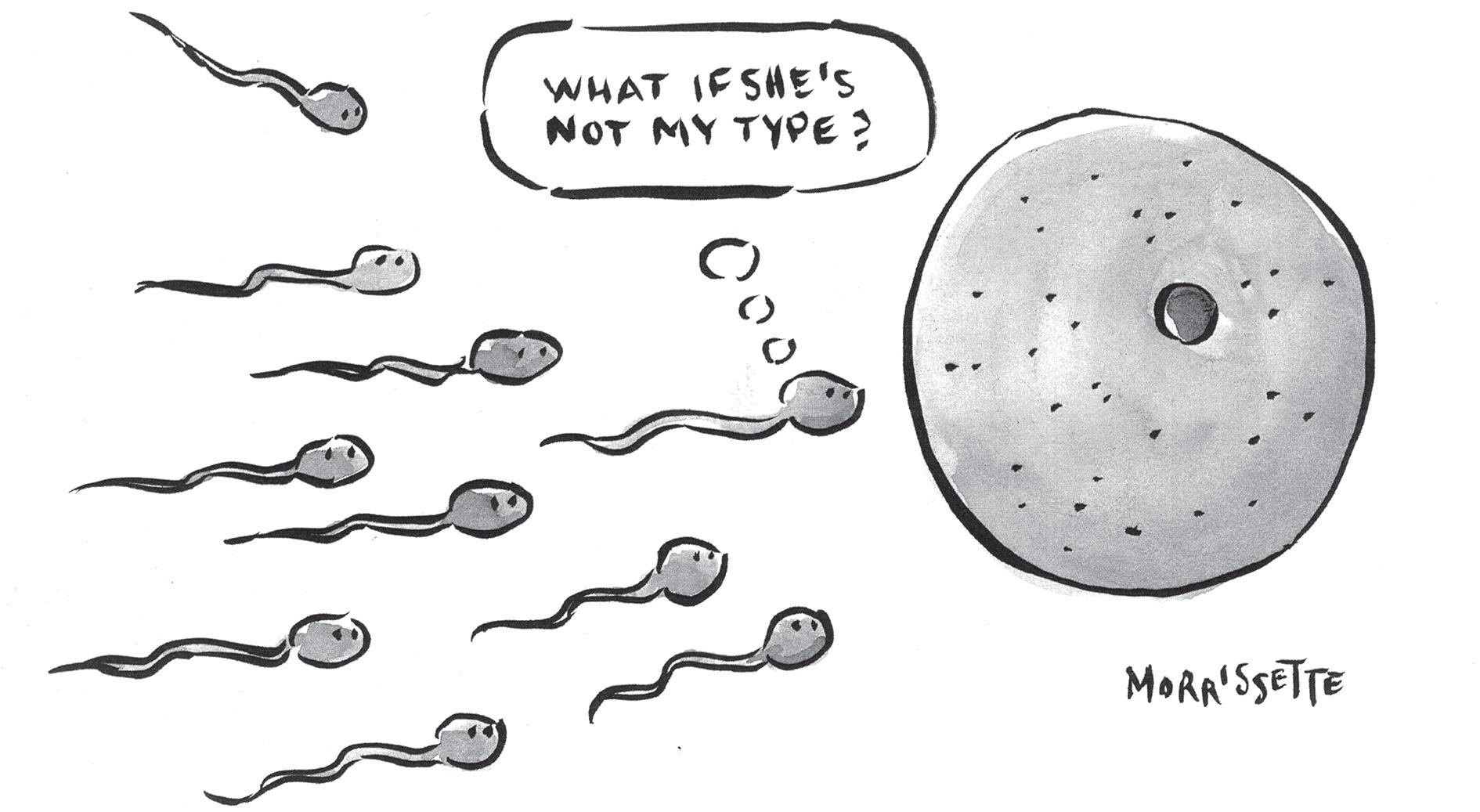
The Oldie August 2023 49
The Oldie, 23–31 Great Titchfield Street, London, W1W 7PA letters@theoldie.co.uk
To sign up for our e-newsletter, go to www.theoldie.co.uk
Thanks for nothing, Rishi
SIR: I have just celebrated my 80th birthday and been much acclaimed by my family and friends. Even the government has got in on the act, as it has increased my state pension by 25p a week. Unfortunately, my village shop has hardly anything to offer at that price, so I need help from Oldie-readers – how would they spend such unexpected largesse?

Dr Patrick Hoyte, Wootton Courtenay, Minehead, Somerset
Cheers, Martin Amis!
SIR: I was an editor at Jonathan Cape when Martin Amis’s first novel, The Rachel Papers, was published in 1973 (Dan Franklin, Oldie Review of Books, Summer 2023). Some of the ladies of Jonathan Cape had rather taken against the book and its author, finding it sexist and very possibly being published only because he had a famous dad.
The grumbling reached the lad’s ears somehow, and understandably he found it rather unsettling. I was given the job of taking him to the pub (it was felt that this was a job for a man) and calming him down, reassuring him that The Rachel Papers was indeed a fine novel, and that he was a proper grown-up writer. This I did – with some success, clearly!
Mike Petty, Folkestone, Kent
Thrashing Lord Lucan
SIR: Algy Cluff writes (July issue) about Lord Lucan electrocuting his dog. But that wasn’t the only example of Lucan’s cruelty and sadism. In his book Portals of Discovery, George Norrie, 2nd Baron Norrie, recalls being flogged by Lucan at Eton – and says he still has the marks to show for it. Norrie says that Lucan was the cruellest boy he had ever known.
Liz Hodgkinson, Oxford
Dame Edna’s ring
SIR: Regarding the article written by Liz Hodgkinson saying that men shouldn’t wear wedding rings (‘The ring cycle’,
June issue), I was surprised to see Barry Humphries sporting one in a photo in the same issue.
For someone so scathing, so unwoke, it seemed such an inappropriate adornment, apart from when he was playing Dame Edna, which in any case was a send-up of the Australian middle class.
On another note, thank goodness for the grumpiness of us old people, so well articulated in The Oldie. Regards, Clare Purbrick, Nagambie, Australia
Lord Craven’s teenage lover
SIR: Lady Craven (1750-1828), who gave her name to Craven Cottage (Overlooked Britain, July issue), evidently passed on her libidinous genes. Her eldest son, a major general, is mentioned in the famous opening line of Harriette Wilson’s memoirs (1825): ‘I shall not say how and why I became, at the age of fifteen, the mistress of the Earl of Craven.’
Yours faithfully, Nick Dean, Welham Green, Hertfordshire
I’ve got the geriatric blues
SIR: I’m puzzled by Christopher Sandford’s assertion (July issue) that the bluesmen who wrote songs covered by the Rolling Stones in the 1960s were in their sixties and seventies when they did so. The Stones’ favourite Chuck Berry was in his thirties when he wrote the songs they played on their early albums,
and Robert Johnson, the most talented of the blues musicians and composer of the Stones’ best blues song, Love in Vain, and very many more, died at the age of 27.
Sincerely,
Colin Crews, Westow, North Yorkshire
Yawn, yawn
SIR: I enjoyed Dr Michael Farrell’s article on the social reasons for yawning (July issue). But I was taught the physiology behind the phenomenon. It’s all down to the pterygoid venous plexus, a collection of valveless veins infiltrating the structures of the jaw joint. If blood stagnates there (for example in tedious situations when the jaws are still for a while), a yawn is triggered to open the jaw and therefore flush out the stagnant blood so it invigorates the flow in the head and neck, restoring wakefulness etc. Presumably if others around you are as bored as you, seeing them yawn unconsciously confirms your need to do the same. But social yawning is contagious only in the afflicted; a boring lecturer doesn’t feel the same need to yawn as his victims.
Dr Ray Lowry, BDS, MB ChB, DRCOG, FFPH
Good manners at
SIR: I am a newcomer to The Oldie, having picked up and enjoyed a few issues that I found in my library’s ‘Magazine Swap’ box, at a time when I was starting to lose interest in the glossies that I’d loved since my teens, and having no desire to buy a magazine aimed at women over 60 that contained crochet patterns and wide-fit-shoe recommendations.
I went and bought the July issue, attracted by Jagger and Richards on the cover. And I am about to take out a subscription, thanks to Dr Michael Farrell’s article ‘Why We Yawn’.
I knew I’d found my tribe when I read the words ‘Each time you yawn, you cover your mouth…’
One of the things I detest about this modern world is the appalling manners of many people, and there are few things ‘There’s been another rant increase’
50 The Oldie August 2023
that send me into a rage more than seeing someone with their mouth wide open, making a noise like a lion on heat and making no attempt to prevent us from seeing their tongue, teeth and back fillings.
It was so heartening to read that someone out there still considers the rest of us.
I look forward now to reading The Oldie every month.
Sue Wilding, Seamer, Scarborough
Kissing cousins
SIR: Mary Kenny (Postcards from the Edge, July issue) writes of cousinades as if they were a recent invention. My widely dispersed cousins (Devon, Bristol, old Berkshire and Oxfordshire) got there first. We’ve been gathering for lunch once or twice a year for the last 12 years.
Andrew Edgington, Bristol
Undesirable ramblers
SIR: Never mind Retired Old Men Eating Out (Modern Life, July issue); our lunch group is the Chilbolton Rambling Undesirable Diners (CRUD).
I was interested to read Alan Ravenscroft’s piece, but he didn’t say when the ROMEO acronym was first used.
We started in early 2013, since when the initial four has grown to 24 members, each garnered from a member’s personal recommendation and not in danger of being blackballed in a secret ballot. We are a varied bunch, mostly fully retired and including engineers, a judge, accountants, a county sub-lieutenant, a senior NHS surgeon and several ex-MDs.
We meet on the third Wednesday of each month, travelling up to 30-40 minutes searching out desirable village pubs, which our T&Cs state may not then be revisited by CRUDs within a sixmonth period.
Luckily, not all CRUDs are able to attend each month, as many hosts cannot accommodate such a large gathering; organising each lunch is akin to herding cats. When a prospective host will accept us only with a food pre-order, that venue is regretfully not visited.
I suspect that the ROMEOs referred to in Mr Ravenscroft’s article, who meet more often, must use the same host or venue, but we like to explore our wonderful Test Valley and surrounding countryside for that unexpected villagepub gem.
Richard Richardson, Chilbolton, Hampshire
Hats off to Matt
SIR: The joy of funny papers (Stephen Carr, Letters, July issue) is not just in the written word. The Telegraph’s peerless pocket cartoonist Matt (Matthew Pritchett) has been keeping the newspaper funny for years, as confirmed by Judy Davies’s letter in the same issue.

I don’t buy the Telegraph, but when picking up my preferred newspaper at the shop, I always take a sneaky look at Matt’s offering of the day before replacing it on the newsstand.
Sincerely, Derryn Borley, St Albans, Hertfordshire
PC in the dock
SIR: I refer to the letter in the June issue from Michael Gordon about police notebooks. Many years ago, I was chairing a Magistrates’ Court trial. The defence representative was interrogating a young police constable. The constable was checking his notebook, as allowed.
Suddenly, the defence representative asked to see the notebook. The court was astonished to be told that the pages of the notebook relating to the case were totally blank! I had no alternative but to dismiss the case. I don’t know what happened to the constable. Regards, Tony Grice, Welwyn Garden City, Hertfordshire
SIR: May I congratulate Giles Wood on his find of a splendid Neolithic stone axe head (Country Mouse, July issue). Having spent a lifetime searching for such things, I can assure him the find is not common.
May I suggest he take it to his local museum, where they should be able to arrange its recording by the PAS –Portable Antiquities Scheme?
This national database, available to all, has recorded over a million significant artefacts found in England and Wales over 25 years.
They may also be able to help with identifying the source of the stone –there were several production sites in the UK.
Or it is possible it has come from even further afield. I once found one near my home that had come from the Italian Alps!
To paraphrase founding father of scientific archaeology General Pitt Rivers, ‘a find dates not from the time of its being found in the ground but from the time it appears in print.’
And Giles has already done that! Keep your eyes peeled.
Martin Green, Sixpenny Handley, Dorset
The Oldie August 2023 51
‘Oh, Supreme Traffic Cone Overloard, invasion of Earth is nearly complete’
Congratulations to Giles the axeman
I Once Met John Lewis
One ordinary lunchtime in 1957 at my prep school in Dorset, when I was 12, I saw my father walk into the dining room.

I’d had no forewarning he was coming, and I panicked that he was bearing some terrible news. Was my mother or perhaps my sister dead? But he smiled, with that shy expression expected from mildly autistic Royal Society Fellows who want to be excused from some social obligation they do not understand.
Our headmaster stood up and beckoned me to meet my father with the faux-avuncular style masters adopt when parents are watching.
No one was dead and we were going for a drive, to have tea with someone. The family chauffeur – Mr Pallet – was waiting in the Humber Super Snipe.
We drove along the A30 and I prodded Mr Pallet to go 80 miles an hour through Cranborne Chase and then, just before Stockbridge, we turned into a long drive and we were at Leckford Estate, a 1,800-acre tranche of Hampshire with a long frontage on the River Test.
A woman came out of the mansion to greet us, and she showed Mr Pallet and me into a vast kitchen where we were given orange juice and a great selection of fruitcakes. But we were there for only a short time.
The woman came back for us and we were reunited with Papa in the entrance hall. An elderly man bent down to talk to me. He had a long white beard and he looked like the picture of Jesus in my school Bible. He gave me a book, saying, ‘Johnny, I do not think your papa will ever read this, but you might.’
On examination, back in the front bench seat of the Humber, the book turned out to be Fairer Shares and the author who gave it to me was John Spedan Lewis (1885-1963), founder of the John Lewis Partnership.
It was only much later that I heard, from my mother, that John Lewis had read something Papa had written about starting his business and invited him to tea.
He offered Papa a choice of Indian or China tea before asking him what he thought about his partnership scheme. Papa said that he did not understand it. John Lewis explained that all the employees were shareholders.
Papa then asked if they could sell their shares when they wanted. They most certainly could not. Papa said, ‘In which case, they are not shareholders. At best, they can look forward to a bonus.’
At that point, John Lewis got up and left, leaving Papa to finish his cup of tea.
A good friend joined Waitrose in Cambridge when it opened and for the next ten years was the supervisor of all the checkout tills. When she left, they gave her a bouquet of flowers and a bottle of wine. She had never been a shareholder in spite of the notice on the wall declaring that the staff serving customers are all partners.
This is in contrast to a friend who worked in Tesco, who can elect to have a fraction of her salary to buy Tesco shares every month, which is efficient as you avoid tax. After a decade, she sold her Tesco shares and retired with £35,000 of real money and a bouquet of flowers and a bottle of wine.
John de Bruyne
No place like The Holme
they used The Holme, nearby, for the English and Italian departments.
Back in the ’60s, I had my 21st-birthday party in what has become the most expensive house in London. It’s on the market for £250 million.

The Holme is a white architectural wonder, with a pillared portico, a rotunda and pediments aplenty.
Built by Decimus Burton in 1818, it’s set in four acres of Regent’s Park, next to the lake.
No, Mummy and Daddy weren’t rich or titled – I just happened to be a grant-aided Eng Lit student at Bedford College, also in the park, and
We translated a lot of Anglo-Saxon there (eg Beowulf) and checked out Chaucer, among many other writers. It was a traditional course, Virginia Woolf being as modern as it got.
But, alas poor Bedford –where is she now?
In 1985, the college merged with Royal Holloway on their campus in Egham and the Bedford name was unofficially dropped. The main building became an American university and The Holme, that Georgian gem, was sold.
The ‘Bedford grievance’, as it’s called, is shared by many alumni, at the loss of their college and its rich history as the first women’s college,
predating those at Oxbridge.
Founded in 1878 by Elizabeth Reid, a social reformer and anti-slavery activist, to raise the standard of women’s education, it flourished first in Bedford Square and then in Regent’s Park. Degrees were awarded and the college affiliated to London University. In the ’60s, it went co-ed.
Back to the party.
After finals, I was allowed to hire the ballroom – aka lecture hall – at The Holme. I designed a fancy invitation
and made myself a frilly maxi-dress, channelling my inner Jane Austen.
I shifted desks, opened French windows onto the lawn, imported a bar and a noisy band. Ah, the nostalgia… I could go on in Brideshead halcyon-days mode – though I admit to having sometimes taken our surroundings for granted, as you do when you’re young.
How little we knew, really, but I’m now so grateful for the riches of studying somewhere idyllic. Not the sort of riches needed to buy The Holme today.
By Pamela Howarth, Rutland, who receives £50
Readers are invited to send in their own 400-word submissions about the past
52 The Oldie August 2023
Founding father: John Spedan Lewis
The Holme, Regent’s Park

Books





Infamy! Infamy!
Ivo Dawnay admires Ferdinand Mount’s new study of rogue leaders, from Julius Caesar to his mendacious brother-in-law, Boris Johnson
There are no prizes for guessing what motivated this book and it wasn’t the Roman.


Though Ferdinand Mount strolls with effortless erudition round the careers of Caesar, Bonaparte, Hitler and even Indira Gandhi, it is the former Prime Minister who is in his sights.



Mount, a baronet, tries to temper his outrage. He is, after all, part of the noblesse oblige tradition, a liberal Conservative who believes in what Lord (Peter) Hennessy has described as the ‘good chap’ school of government, where politicians try to do what’s best for the country.
The outgoing PM (but one), now stomping off to his tent, less like Achilles and more like a pudgy cross between Ted Heath and Prince Harry, is not of that ilk. Johnson’s classmates in the bad-chap school might include Victor Orbán and President Putin, with the class bully, Donald Trump, leader of the gang.
It was Hennessy, a usually mildmannered historian, who first described Johnson as ‘tone deaf’ to the niceties of a constitution based on the outdated premise that Britain would always be run by people with morals.


And Mount would no doubt endorse his conclusion that the man Conrad Black described as a fox disguised as a







NICK GARLAND 54 The Oldie August 2023
teddy bear ‘hasn’t got a single feel for either proper behaviour, proper procedure … no sense of restraints’.

The purpose of the book, however, is not as a mere cri de cœur – a ‘Why, oh why?’ polemic by disgusted of Islington – but more as a What Is to Be Done? As its subtitle promises, it charts not simply the rise of Caesars, big and little, but also how they come unstuck.

Moreover, drawing on the ultimate fates of his rogues’ gallery of authoritarians and dictators, Mount’s conclusions are broadly optimistic. He believes that Johnson’s ejection from office and the conclusions of the Privileges Committee inquiry are evidence that Parliament is at last righting the leaky ship of state.
I am not so sure. Full disclosure here. As my brother-in-law, Johnson has, in turn, charmed, entertained and horrified me for more than 30 years. During this time, I can barely remember him ever asking me a single thing about myself.
So, if that is the corrupt, subconscious driver for my own Johnson scepticism, it is also heavily reinforced by nagging guilt that, as his foreign editor on the Sunday Telegraph in the 1990s, I objected only
By Nicholas Garland
mildly when his fanciful (not to say purely fictitious) copy landed – late, of course – from Brussels.
‘Oh, but it’s so well written,’ the then Sunday Telegraph editor, Charles (now Lord) Moore, used to say as I hovered, eyebrow raised, in his office doorway. ‘Bung it in.’
My theory as to why Sir Max Hastings, Boris’s editor at the Telegraph, is so splenetically anti-Johnson is that he created – and used to boast about the circulation gains of – the Boris-inBrussels phenomenon.
Mount is not shy about detailing the charge sheet. Specifically, he lists the five Acts of Parliament in spring 2022 that extended executive control over Parliament, elections, the courts, immigrants and public demonstrations.
He castigates the scoundrel-like patriotism of the new flag-waving regime, the £2m White House style briefing room, the effort to prorogue Parliament and the night of the long knives when 21 Tory MPs – all ‘good chaps’ – were sent to the tumbrils.
‘Let’s be quite clear,’ Mount stresses. ‘A parliamentary Conservative party which contained anything like the traditional broad spread of opinion would never have conceived, let alone assented, to a single one of these ghastly laws.’
Nor does he hide his European sentiments. In a thundering peroration, he takes his scourge to the temple of the right-wing tabloids and their fellow travellers in the Commons.
‘Perhaps the most egregious aspect of the Brexiteers,’ he writes, ‘was their boast to be restoring the sovereignty of Parliament while doing their damnedest to prevent Parliament from scrutinising the terms of Britain’s exit – with catastrophic results for small exporters,
fruit and veg farmers, care homes and a dozen other sectors.’
But if Mount is magisterial on the hows and the whats of the Caesar syndrome, he entirely ignores the whys. Perhaps the inexactitudes and equivocations of psychology – the very sociopathology of narcissism – are beyond his impressive powers.
For the reader, one pines for an explanation as to what drove Caesar himself to cross the Rubicon? Or how his midget imitators, Indira Gandhi or Johnson or Trump, decided that they, and only they, should impose themselves as national leader and were then willing to play fast and loose with constitutional custom and practice to stay there.
How too can one explain the furious loyalty of the fanbase for whom no outrage is outrageous enough? What lies behind the doe-eyed devotion of Nadine Dorries and the doublebreasted, de haut en bas would-be patrician (now Sir) Jacob Rees-Mogg – the Tories’ own Gussie Fink-Nottle?
Mount never explains.
After he’s described the symptoms of the illness, his prognosis that – like the autoimmune response of an organism – Parliament will naturally rid itself of the disease feels Pollyannaish indeed.
The Make Britain Great Again horde has put Tories like Macmillan, Major and Mount to the sword. The dogs of Twitter are let loose; all we good chaps can do is ‘Cry “Havoc!” ’
Ivo Dawnay was foreign editor of the Sunday Telegraph
Big Caesars and Little Caesars: How They Rise and How They Fall – from Julius Caesar to Boris Johnson by Ferdinand Mount (Bloomsbury, £20)
The Oldie August 2023 55
Boris Johnson at a Daily Telegraph leader conference, 1999.
Et tu, Brute? The Murder of Caesar by Karl von Piloty (1865)




Our grapes
BILL KNOTT Vines in a Cold Climate: The People Behind the English Wine Revolution
By Henry Jeffreys
Allen & Unwin £16.99
Sometime in the 1970s, two friends on a tour of the South Downs spot a sign for a vineyard and decide to pay it a visit.
They are greeted by a blue-blazered chap with a military moustache, who proudly shows them round the rudimentary winery in his garage.
Seated on the terrace of his house, their glasses charged, they listen as the retired major, pointing proudly at a patch of straggly vines, reaches his peroration.
‘And the most remarkable thing,’ he declaims, ‘is that the wine in your glasses was grown just over there!’
One friend takes a dubious sip and whispers to the other, ‘Doesn’t travel well, does it?’
The story may be apocryphal, but 50 years ago the parlous state of English winemaking was not. As wine writer Henry Jeffreys relates in Vines in a Cold Climate, his entertaining study of this country’s wine and winemakers, it was to be another 20 years or so before English wine was taken even remotely seriously.
It took a wealthy couple from Chicago, Stuart and Sandy Moss, to
demonstrate conclusively what some oenophiles had suspected for a while: that England’s best chance of producing world-class wine lay not in growing hybrid grapes with unpronounceable Germanic names, but in making something akin to Champagne.
Like the south of England, Champagne rarely produces grapes ripe enough to be made into top-notch still wine, but it does produce exactly the kind of acidic, low-alcohol wine that –when primed with sugar and left to develop bubbles – makes excellent fizz.
In 1987, the Mosses planted their newly-acquired Nyetimber vineyard, in West Sussex, with Champagne grape varieties (despite being told by the man at the Min of Ag to stick to growing apples); they produced their first vintage in 1992 and released it to general acclaim a few years later. Mike Roberts at Ridgeview, in East Sussex, followed a similar path and achieved equal success.
The die was cast. Many existing wineries turned their attention to fizz, and a host of other vineyards were planted with Champagne varieties. Investment came from some unlikely sources – ‘watercress barons at Exton Park, lettuce magnates at Tinwood’ –as well as hedge-fund managers and tech millionaires.
This unlikely bunch of characters –some passionate about wine, some in it for the money, some maverick by nature,
some slick and efficient – caught up in a kind of grape-fuelled gold rush (although, according to Jeffreys, few estates have yielded any profits yet) is what makes Vines in a Cold Climate such a fascinating read.
Jeffreys has a knack of eliciting pithy opinions from his colourful cast, about English wines, about one another – the words ‘shits’, ‘charlatans’, ‘backstabbers’ and ‘fucking French consultants’ pepper the text – and about the future of viticulture in this cold climate.
But, of course, our climate is changing. Fizz may have saved English wine, but it may not dominate the future, despite vast investments from Champagne houses Taittinger and Pommery.
Grapes are, in most years, getting riper: better knowledge of where, how and what to plant, combined with a rise in temperatures, means that still wines may yet come to the fore.

And I agree with Jeffreys that the distinctly Burgundian Chardonnays from Chapel Down’s Kit’s Coty vineyard are superb. Jeffreys also highlights low-rainfall Essex as a region with huge potential for still wines, even reds, with New Hall among the leading producers.
In the meantime, there is much fizz to be enjoyed, especially from the warm and ripe 2018 vintage: Mark Driver’s Rathfinny wines from Sussex, for example. He was behind the recent, controversial award of a Protected Designation of Origin to Sussex wines – and the fizz from the hugely ambitious Hundred Hills winery in Oxfordshire.
There are excellent sparklers made by Coates & Seeley, Ridgeview, Nyetimber, and by veteran winemaker Dermot Sugrue’s new ‘Sugrue South Downs’ label.
That Jeffreys’s book will not age as well as some of its contents is not his fault: the world of English wine is in a constant state of flux.
Taittinger’s grand Domaine Evremond project is about to launch, with the first vintage due soon: how will it compare to Nyetimber and Ridgeview? Will the market for English wine continue to flourish, or will it stagnate, leaving an EU-style wine lake (well, a large puddle) behind?
Prices are high: might a cheaper, Prosecco-style English fizz succeed in broadening the market? Vines in a Cold Climate seeks to address all these questions and many more, but I suspect that we will have to wait for the book’s second edition to discover the answers.
The Oldie August 2023 57
Bill Knott is The Oldie’s drinks critic
GARY WING
English vendange: a chilled wine harvest




Letters to absent friends
NICHOLAS LEZARD Last Post
By Frederic Raphael Carcanet £30
Since 2001, Frederic Raphael – author of The Glittering Prizes, screenplay writer of Far from the Madding Crowd and Kubrick’s Eyes Wide Shut – has been writing memoirs under the umbrella title Personal Terms.
The sixth appeared in 2013; this volume, as its title suggests, will be the final one. How could it not be? He’s 91, for goodness’ sake (going on 92). Five hundred pages, not counting the (wholly necessary) index – he’s not making it easy for himself.
And it’s not as if his style makes things much easier for any of us. Clotted, arch, arcane even, finicky and deeply open to parody. This makes it sound horrible but, strangely, I find it hugely entertaining, even when – especially when? – it seems to go beyond even self-parody. (As you can see, it’s also infectious.)
Example (the ‘you’ here is Nabokov):

‘In your books, caressing the details delivers the art of the matter. Branding Fyodor Dostoevsky a “journalist”, you rated him a case of scribbler’s rush. You conceded that his manic tendencies came of having been subject to mock execution by the Tzarist authorities, but in your aesthetics, as with Henry de Montherlant when it came to fautes d’orthographe, sympathy procures no remission. Then think of Raskalnikov. Genius, quand-même, Fyodor?’
Here we are approaching Joycean levels of allusion and cross-linguistic punning. As so often in his writing, Raphael, in his urge to look as clever as possible, can go too far.
‘Art of the matter’ is OK because later on he gets onto Graham Greene, who of course wrote a novel with a similar title. The z in ‘Tzarist’ is a forgivable, even an enjoyable, anachronism. And, while we can enjoy ‘Raskalnikov’, do we gain much by calling spelling mistakes fautes d’orthographe?
Actually, I think we do gain something, not the least of which is a sense of Raphael’s own pleasure in his wilfulness. Apart from Joyce, the only other writer I can think of offhand who used to do this kind of thing – ‘used to’, because absolutely no one does it any more in case they’re accused of élitisme – sorry, elitism (gosh, it’s catching) – was Clive James.
Raphael does not like Clive James, and not just because he might have been parking his charabancs on his pélouse (I’ve got to stop doing this), but because James had written ‘a sneering notice of the first episode [of The Glittering Prizes] in the Observer.’
And who’s having the last laugh now?
Nabokov et al are being addressed in the second person singular because each chapter in Last Post is addressed either to a celebrated writer with whom Raphael has had dealings, or to people less celebrated but still in the worlds of theatre, film or literature.
The result is a panorama both huge in scope – nearly a century, after all – yet with all the laser-guided intimacy of gossip. If nothing else, this is a gold mine of tale-telling (as readers of Raphael’s earlier memoirs have come to appreciate). ‘The nicest story about [Hugh] Walpole as a handsome young person is that he as good as invited Henry James to, as they used to say, take advantage of him. H J is said to have responded, “I can’t, I can’t.”’
I imagine that, like me, most readers will go for the famous names first –Nabokov, Kubrick, Jonathan Miller, Willie Maugham – but the less famous names also provide fascinating stories, as well as evidence that Raphael is not a namedropper – or not just a name-dropper.
Here are obligations settled to those he knew when he was young, who never quite achieved their promise. It’s a familiar and timeless Cambridge theme; for there intellectual rigour trumps social advancement, unlike in the Other Place.
Take his mention of John Patrick Sullivan, ‘the best undergraduate scholar of my generation’, and the son of a Liverpool docker: ‘Excellence beaten into him by the Jesuits’ tawse, he retained their instruction, abandoned their faith.’
Among other things, that superb sentence reminds us that Raphael’s style is in fact the opposite of longwindedness. A biography in 15 words.
And then there’s his letter to Dorothy Nimmo, a poet of whom I should have heard but hadn’t. ‘At Cambridge, you chose to pass for an actress, a star among few twinkling females.’
After a mere eight and a half pages, I feel as though I have come to know her, and even some of her work. ‘Your poems, true as pain, are at hand beside me.’
This book is a phenomenal act of gratitude, as well as remembrance.
Nicholas Lezard is author of It Gets Worse: Adventures in Love, Loss and Penury
CHRISTOPHER HOWSE Metropolitain: An Ode to the Paris Metro
By Andrew Martin Corsair £16.99
We must start with the smell, obviously.
Everyone has mentioned the smell of the Paris Metro, yet it remains indefinable. Its ‘cloying but not unpleasant sweetness’ reminds Andrew Martin of emanations from a chocolate factory in the York of his youth. Garlic, dust and tobacco (black) have been cited among its ingredients, though smoking was banned in 1991.
There may also be an element of a perfume called Eau de Madeleine, which since 1998 has been added to the wax that polishes the bitumen platforms each night.
The smell would have been harder to celebrate if a proposal in the 1880s had been adopted of making the Metro tunnels sewers by night, freshened by fans each morning. That is the sort of byway of Metro knowledge that stops the author’s ‘ode’ drifting into the emotionally abstract.
Andrew Martin has written books on the London Underground (and one entirely on the moquette patterns covering its seats), and he loves the Metro, but his love is grounded – even undergrounded.
The 140 miles of the Metro (Martin eschews the acute accent, pointing out that it does not figure on station signs) have 304 stations, compared with the 272 on the 250 miles of the London Underground. A grand projet is now tunnelling to add 125 miles for a 24-hour driverless railway, serving 68 new stations.
Perhaps that will somehow reconnect the two million residents of central Paris with the 10 million of the Île-de-France region, which includes the car-burning banlieues (a word that, pace Martin, does not literally mean ‘banned from the place’, but derives from Latin words meaning ‘jurisdiction’ and ‘a league’s distance’).
Martin’s Metro is intimately woven into ‘the most beautiful city I have seen’, the old Paris that the social historian
The Oldie August 2023 59 Vive le Metro!

Richard Cobb mourned during its ‘assassination’ in the 1960s. Cobb referred to a non-Maigret novel by Georges Simenon, The Move (Le Déménagement, 1967), in which the protagonist, Emile, moves from the Marais’s shabby clutter and finds himself isolated in an anonymous development where no bells ring on Sundays.
Of course the Métropolitain de Paris was modernity itself when opened in 1900, 37 years after London’s Metropolitan Railway. Thank heaven, proposals to run elevated tracks down the boulevards were dropped (just as, in London, plans failed for railways down the middle of the Thames). Before the mid-20th century, the Metro was carrying a billion passengers a year (increasing numbers by 50 per cent during the Second World War, when cars were hard to run), while London reached a billion only in 2007.
The Metro as an expression of Parisian culture became lovable in every detail, starting with the Art Nouveau entrances by Hector Guimard. At first no station name was visible from the street, since –the thinking went – you would know where you were. In 1916, the station called Berlin reopened as Liège. Seven stations were named after Resistance heroes.
In 1903, Parisian Metro passengers displayed sangfroid to a suicidal degree. Smouldering was detected on a train (of wooden construction at that date). The passengers were transferred to another. The fire burst out fully at Ménilmontant on Line 2. A train crowded with displaced passengers was at the station before, Couronnes, and they were told to leave. But they wouldn’t, not without a refund of their 15-centimes fare: ‘Nos trois sous,’ they chanted at helpless officials. Then black smoke rolled down the tunnel and 84 died of carbon-monoxide poisoning.
Steel Sprague carriages replaced the wooden rolling-stock in 1908 and remained in use till 1983. They had wooden slatted seats; a reflection, I think, of ideas about hygiene (while England preferred soft sitting). Martin loves those carriages, as he does the original bevelled white tiling of stations.
Rubber-tyred trains were introduced on five of the 16 lines, but new trains make less noise with steel wheels. Very long, wooden benches stood against platform walls until removed as an unwanted invitation to rough sleepers. The very wording of public notices recruited nostalgia: the emergency alarm must not be used sans motif plausible
In this utterly enjoyable voyage under Paris, I felt one moment of shame.
I learnt I have always misused the little folding seats, the strapontins, near the carriage door. Martin rightly applauds the social sensitivity with which Metro passengers know the precise moment that the train becomes too crowded to continue using them, standing up as one to let them snap back upright.
I hadn’t realised. I shall do better in future.
Christopher Howse works for the Daily Telegraph

Surreal life
LUCY LETHBRIDGE
Surreal Spaces: The Life and Art of Leonora Carrington
By Joanna Moorhead
Thames & Hudson £30
Joanna Moorhead wrote the wellreceived biography of the Surrealist artist Leonora Carrington (1917-2011). Now she has produced a lavishly illustrated book which revisits Carrington’s life in the context of her various homes.
The artist was in flight from a conventional upper-middle-class English childhood. Her amorous and artistic adventures took her from Morecambe Bay to Mexico City, where she lived, on and off, for 60 years.
‘Nothing is ordinary; everything is extraordinary,’ Carrington told Moorhead before her death, aged 94, in 2011.
There is certainly plenty of the extraordinary on display here, but it now draws its power to shock mainly from the domestic ordinariness that surrounds it.
The spectacles that still sit on Carrington’s bedside table in Mexico City (her house is now a museum) seem almost as unsettling as the bird-headed men and human serpents that appear in her paintings.
She was born in 1917, in Lancashire, to a Catholic family with money from textile manufacture. Her first home, Crookhey Hall, was a Victorian brick mansion designed by Alfred Waterhouse.
Though the Carringtons soon left it for another sombre pile, Hazelwood Hall, near Morecambe, Crookhey’s dark corridors, mullions and bird-headed heraldic symbols appeared in Leonora’s work for the rest of her life.
In a reverse of nominative determinism, Leonora’s family called her Prim. After she was sent to board at New Hall, a convent in Essex, her report read only, ‘Leonora Carrington, desperate to
‘The answer is yes –terms and conditions apply’
be different.’ Nuns appear regularly in the paintings, in hordes and galleons and with faces hidden by enormous wimples.
A reluctant debutante, she escaped to art school (her father suggested she stay at home and breed fox terriers) and in 1938, after she visited the first Surrealist exhibition in London, her destiny was sealed.
The Surrealists’ wonky assemblages and mannequins in suspenders are nowadays the hackneyed stuff of any old art-school degree show, but in the late 1930s Surrealism took itself very seriously indeed.
Anything went, as long as members abided by the rules laid out in André Breton’s ‘manifesto’, which was unexpectedly prescriptive (members were always being expelled for unSurrealist behaviour). Art had to well up from the unconscious, as a process of ‘psychic automation’.
Leonora’s self-portrait of 1937 accordingly shows her in an almost empty room in a large country house. There is a rocking horse, a pregnant hyena and out of the window the white horse of her alter ego galloping over the fields.
Leonora then fell for the much older German artist Max Ernst, who took her off to live the free-love dream in France (Leonora paid for the house), pursued by his furious wife Marie-Berthe.
Ernst cut an unlikely swathe through the women of the Surrealists; he went on to marry both Peggy Guggenheim and the painter Dorothea Tanning. He must have been more exciting than photographs suggest, and the prolific originality of his work must have been alluring (he was a founder member of Dada).
But perhaps Leonora’s portrait of Ernst, on an iceberg, dressed in a furry suit and striped knee socks, reveals another (unconscious) truth: that he was also slightly absurd.
The Oldie August 2023 61


Moorhead’s scoop is to have found the house in Saint-Martin-d’Ardèche where the couple lived. And, by an extraordinary stroke of luck, it is completely untouched. There are the murals they painted, the wardrobes covered with dragons, the stone relief of naked lovers – and Leonora’s shelf of 1930s paperback novels and her golf clubs. Did they play golf? It’s hard to imagine.
When Ernst was interned in 1940, Leonora’s parents arranged for a Jesuit to help her over the Spanish border. When she had a breakdown and was committed to an asylum in Spain, they sent her old nanny in a warship to persuade her to come home.
But she ended up in Lisbon marrying Renato Leduc, a poet attached to the Mexican Embassy. It was a marriage of convenience – but they had quite a sexy time, too. Then Ernst turned up with Peggy Guggenheim and everything got a bit complicated.
‘Leonora had moved on emotionally,’ writes Moorhead, and the reader may cheer.
She arrived in Mexico City up for a new adventure, which turned out to be living in an artistic commune with her new Hungarian lover, Chiki Weisz, and the artist Remedios Varo.
By the time Moorhead met her, decades later, Leonora was a queenly, still beautiful figure in her late eighties, one of the last surviving Surrealists but endlessly adaptable to whatever new ideas came her way. Eco-feminism, Ouspensky, Buddhism, Kabbalah, Celts – they all get swirled about in the dreamworld paintings.
She even wrote a play about the last woman on earth to have eggs. It was a far cry from Crookhey Hall – as she had hoped all along.
OLDIE NOVEL OF THE MONTH
Tuscan holiday
MARY KILLEN The Three Graces
By Amanda Craig
Abacus £18.99
Critics have been confused by the novelist Amanda Craig (this is her ninth novel) because she tackles big, troubling subjects but within highly readable narratives.
I consumed this one – multilayered, full of discreet wisdom and wit, within 36 hours.
The Three Graces of the title call to mind La Primavera by Botticelli. But, here, they refer to three 80-something female friends who are among the expats trying to live (the end of) their best lives in Santorno, a Tuscan hill town.
There they face the problems peculiar to this fool’s paradise – free of doctors just when you pass your physical peak.
There is Diana, an Oldie-reader and impoverished aristocrat, whose husband, Perry, an arrogant philanderer and ex-colonial racist with years of entitlement syndrome behind him, is now demented, in a wheelchair and dependent on dutiful Diana.
There is prosperous Ruth, still on HRT, an American-born retired consultant psychotherapist. She sold the one-time hovel in Belsize Park, which she’d transformed into a ‘white stuccoed palace’, and swapped it for the ruins of a large abandoned Tuscan farmhouse with 20 hectares. It’s now an eco-paradise kept going by WWOOFs (Willing Workers On Organic Farms).
And there is well-pensioned Marta, a concert pianist, who, owing to aches and pains, which the three old ladies have a pact never to discuss among themselves, still gives one public concert a year. ‘My life is all D minor now; I will never hear the major key.’
All three women have dogs but, more to the point in this multi-generational novel, they all have grandsons – and these three turn up in Santorno.
Hedge-funder Olly has come for his wedding to an influencer with three million followers – 25-year-old Tania, the most beautiful girl most people have ever seen.
She is constantly likened to the Botticelli in the Uffizi: ‘She was exquisitely proportioned, her eyes, her lips, her nose, her hips – like a mathematical calibration of female perfection.’ But Tania who is followed and cat-called everywhere she goes because of her beauty – and suffers from panic attacks and mental-health problems like so many of her generation – has a
secret reason for wanting to marry hedgefunder Olly – and it’s not his money.
Xan, the grandson of Marta, who has graduated with a First but is tutoring because he cannot find a proper job, is particularly vocal about his resentment of the generational divide: ‘Your generation had free tuition, no student debt, cheap council mortgages, proper jobs, the lot. Of course you could buy a second home in Tuscany. We can’t even buy one. No matter how hard we work, most of us will never have anything but crap jobs for ever.’
The generational divide, both moral and financial, is a major theme. Ruth is disgusted by the sickening amount of free products delivered to her farmhouse for Tania to display as she posts every step of her wedding preparation on Instagram.
Ruth does not understand the new jobs such as influencer and hedge-funder, which ‘didn’t even exist ten years ago’.
Marta is horrified that the only people who still treasure classical music ‘seemed to be the old and dying, and this was an almost unbearable thing because when the audience for classical music was gone, the essence of the human spirit would be no more.’ Diana observes the changes that have afflicted aristocrats. ‘From having been admired and feted, anyone upper class was now supposed to be a brute, a scoundrel and a thief.’

Another running theme is how Tuscany has changed with the annual influx of 300,000 immigrants into Italy. Enzo, 40, the last local still living on the hillside, who helps out the three old ladies with driving and odd jobs, is allowed to give free rein to his racist thoughts.
‘Nothing was as alarming as the migrants, whose numbers, hundreds of thousands each year, were seen as a visible manifestation of everything that was wrong in the world. Crime had soared: not the familiar Italian kinds such as the bribery of officials or using the black market, but robberies, drugs and assault. All these, Enzo was now certain, were the fault of foreigners.’
Bitter Enzo, whose family have lived in the same farmhouse for hundreds of years (as tenants), is now the only person who knows how to look after the land in the old way but, as a tenant, he has no security.
And love, of course, is another of the big themes within this most ingeniously plotted and ultimately satisfying novel. There’s much more to it than just readability.
Mary Killen appears on Gogglebox with her husband, The Oldie’s Giles Wood. Together they wrote Country Life: A Story of Peaks and Troughs
The Oldie August 2023 63
Lucy Lethbridge is author of Tourists: How the British Went Abroad to Find Themselves
‘I have to warn you – my parents are a bit old-fashioned’

So little, England. Little music. Little art. Timid, tasteful, nice. But one loves it. Loves it. You see I can say I love London. I can say I love England. I can’t say I love my country. I don’t know what that means.
The Guy Burgess character in Alan Bennett’s An Englishman Abroad
Tiger, to park a: to deposit involuntarily the colourful remnant of a large meal upon some inappropriate surface – eg carpet, bedspread, dining table etc.
Barry Humphries, A selection of Australian words and phrases in current popular use, from The Complete Barry McKenzie
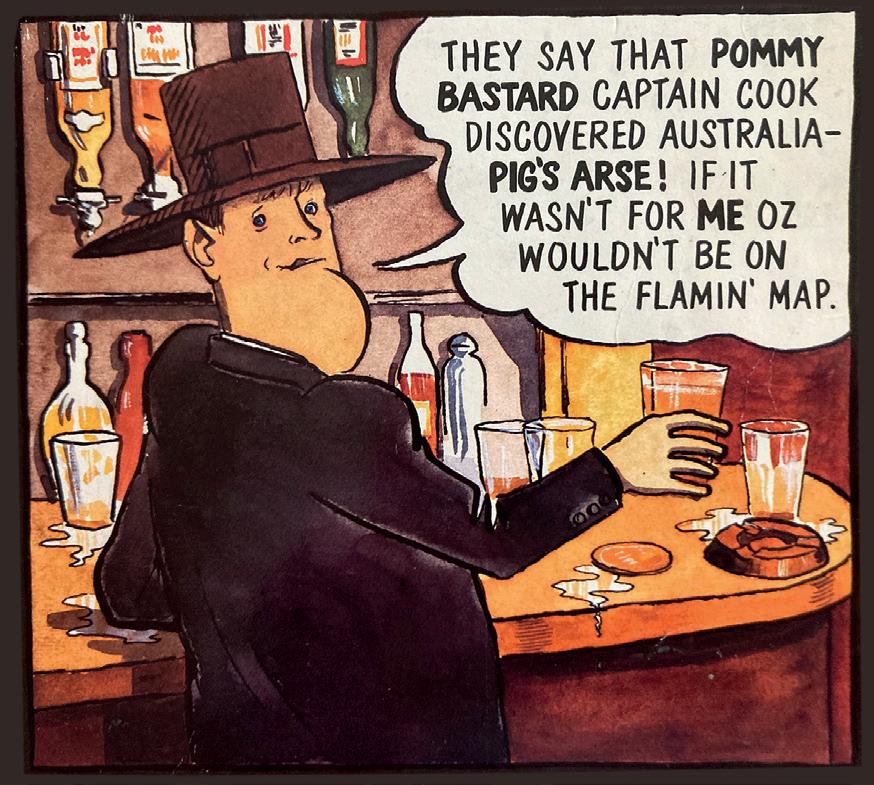
Conversation as I love it – with anecdote occurring spontaneously and aptly, jokes growing and taking shape, fantasy.

Evelyn Waugh, letter to his wife, Laura Waugh
All conscious efforts to assert individuality in so trivial a fashion end in conformity that represents a form of social cloning
Dr Theodore Dalrymple on tattoos
A single copy of The Times contains more useful information than the whole of the historical works of Thucydides.
Richard Cobden
One of those TV programmes you persist
with only for reasons of austere selfimprovement.
James Walton
All Conservatism is based upon the idea that if you leave things alone, you leave them as they are. But you do not. If you leave a thing alone, you leave it to a torrent of change.
G K Chesterton
We laugh at honour and are shocked to find traitors in our midst.
C S Lewis
Silence, like a poultice, comes to heal the blows of sound.
Oliver Wendell Holmes
carton which had been sellotaped to death, even right across the perforated slot for supposedly easy access to the individual boxes. Time for impatient slashing with a penknife.
Packaging
How many times recently have you had to do battle with opening packages? I am fed up with having to line up a variety of tools to do this, including a nail le, a Stanley knife and mini shears.
A cardboard container arrived recently. I pulled the end of the masking tape to yank it open. Surprisingly easy, I reckoned. Er … no. Inside was another, thinner
Another horror is blister packaging. It’s as if no one’s meant to open what’s inside.
My teenage granddaughter recently bought nail scissors in a pharmacy because she had to repair a broken ngernail. She couldn’t break through the plastic front or tear o the cardboard backing which was rmly stuck on. So she had to ask for help.





‘This happens a lot,’ the shop assistant moaned as
Greatest living Australian: Barry McKenzie, by Barry Humphries & Nick Garland
We tell ourselves that God is dead, when what we mean is God is Dad, and we wish him dead.
A N Wilson
He was not old enough to know what a narcotic is Habit and that one can become attached to and interested in the most unpromising jobs.
P G Wodehouse, Psmith in the City
He showed me what style is all about: not fashionable things, but that elusive quality no one is capable of buying, the opposite of pretence. The ability to command attention without soliciting it. Being authentic without making a conscious effort at being so.
Taki on Gianni Agnelli
In the internet age, when there are so many other demands on our attention, why should anyone bother to learn Latin, let alone Greek? It is a fair question… Seneca asked a similar question: ‘Haec sciam? Et quid ignoram?’ ‘Do I know these things? And what can I afford to ignore?’
Professor Emily Wilson
she cut it open – with large scissors. ‘Toothbrushes are a right pain too.’
By far the worst of all is hard plastic clamshells. These are made from two clear plastic halves hinged together, then securely glued shut. Here’s a typical case: I found a perfect Christmas present for my great-nephew, but his poor father had to attack the pack with a junior hacksaw before
SMALL DELIGHTS
Cutting open an empty tube of cream to nd plenty still left inside.
 PAUL STONE, FENSTANTON, CAMBRIDGESHIRE
PAUL STONE, FENSTANTON, CAMBRIDGESHIRE
Email small delights to editorial@theoldie.co.uk































eventually his son got to play with the toy soldier inside.

Why do we have to put up with all this nonsense? So that manufacturers and retailers can boast that these almost impenetrable barriers protect against tampering (they mean theft) or rough handling? Is this more important than buyers’ not being infuriated? It seems so.
For Pete’s sake, think about us harassed customers. I’m sick of having to hack into, stab or pierce almost everything I’ve bought. So why not put on readable opening instructions and proper perforations and tabs you can actually tear. It can’t be that di icult or costly.

proper perforations and It can’t be that di icult or costly.
CAROLYN WHITEHEAD
Commonplace Corner
TOM PLANT
The Oldie August 2023 65
FILM HARRY MOUNT HELLO, BOOKSTORE (PG)
Had enough of films about Marvel comics, misery and death, punctuated with sex and swearing? Can’t face Indiana Jones going through the motions in his eighties or Mission Impossible, Part 93?
Well, here is the charming film for you. Hello, Bookstore is the swearwordfree, heart-warming story of The Bookstore, a bookshop in Lenox, Massachusetts.
For 47 years, it’s been run by Matt Tannenbaum, now 77. What a gift he is to director, A B Zax. Here is a wide-eyed, enthusiastic bookshop-owner who actually loves books – the polar opposite of heroically grumpy Dylan Moran in the British TV series, Black Books.

With no pretension, Tannenbaum remembers great tracts of Henry V and Laurie Lee, suddenly declaiming them to the camera and his rapt customers.
He isn’t a show-off – more an exile to the world of words from his New York youth, where he worked as a ‘young stoner’ at the fabled Gotham Book Mart in the early 70s.
Arts

His customers are bewitched by his book recommendations. Of one favourite, Tannenbaum says, ‘It took me three days to read it. My bookmark never had a chance.’



In return for his sweetness, the customers bring scallops and coleslaw to his doorstep.
Tannenbaum is a clever innocent –with the looks and tousled grey locks of a Hollywood film star – still in love with his job. As he describes it, he spends all day talking about the things he worships – books – and occasionally being interrupted by people paying him for the privilege.


The problem is, they don’t interrupt him enough to pay for the bookshop to keep going during the pandemic.
Those customers who do come to the shop, in facemasks, to speak to Tannenbaum from the other side of his front door are touching. They show the desperation for company – and for reading – in those dark times.
But there simply aren’t enough of those book addicts turning up. So Tannenbaum is on the verge of going bust. As he says, ‘Who would spend all the hours that I spend for the little pay that I get? I’ve been a poor bookseller all my life. I tried not to make money.’
47




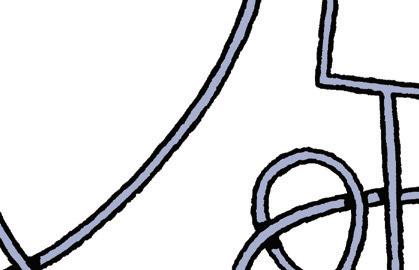


Suddenly, this quiet, agreeably slow film comes to life, when a GoFundMe drive from local and international supporters raises $60,000 to save the shop within 23 hours.
The goodwill this smalltown hero has built up over nearly half a century comes back in oceans of cash. As one adoring customer says, he is Lenox’s George Bailey – James Stewart’s selfless hero in It’s A Wonderful Life (1946) – ‘the richest man in town’, thanks to his selfless acts of kindness.
Tannenbaum responds to those acts with touching wit, ‘I always wanted to be a writer. Now I’m going to write thankyou notes.’




As if all that poignancy wasn’t enough, it emerges that Tannenbaum was widowed after only 11 years of marriage. He was left to bring up his two young daughters alone – they regularly drop into the bookshop to help out their Dad, who they palpably adore.


In a heart-stopping climax, one daughter presents Tannenbaum with a baby grandson in the closing scenes, who he dandles on the bookshop floor.
It doesn’t stop there. It emerges that Tannenbaum’s Jewish ancestors escaped from Poland during the war. He proceeded to open a little corner wine bar in his bookshop, Get Lit, in their memory.

He has a good line in Jewish jokes, too. Confronted by a moose recently, out in the wild, his first thought was, ‘Do moose eat Jews?’
It all made me want to fly to Lenox tomorrow – a lovely corner of the Berkshires, close to Edith Wharton’s home, the Mount, and the Norman Rockwell Museum.
How I’d like to buy one of Tannenbaum’s fine selection of new and secondhand books – and follow his credo: ‘Our motto is you can’t drink all day unless you start in the morning.’
66 The Oldie August 2023
years of service with a smile: Matt Tannenbaum, bookshop-owner
THEATRE WILLIAM COOK CRAZY FOR YOU
Gillian Lynne Theatre, London, until 20th January
What’s the recipe for a great musical? A superb songbook is essential, and so is a first-rate cast, but the most important element is the most elusive: to become a surefire hit, a musical must make you feel glad to be alive.

Crazy For You has that ineffable joie de vivre which it shares with all the best stage shows. It leaves you feeling warm and giddy, like a stiff drink before dinner or a kiss on a first date.
What makes it so intoxicating? Partly the timeless, glorious songs of George and Ira Gershwin, but mainly because every performer on this stage is clearly having such a splendid time.
This exuberant production opened at Chichester Festival last summer and is now making its West End debut, but its pedigree dates back to its US premiere in 1992. The choreographer of that sell-out show (which won three Tony awards on Broadway, and three Olivier awards in the West End) was Susan Stroman, who directs and choreographs this revival.
How fitting to see it in this theatre, dedicated to the late great director and choreographer Gillian Lynne (19262018).
Stroman’s choreography is athletic and sensual, and these actors rise to her exacting challenge. Her ensemble numbers are full of tricks and stunts, but she’s never showy for the sake of it.
Stroman knows how to razzle-dazzle, but she also knows when to step aside and simply let the music breathe.
Crazy For You doesn’t suffer from that awkward problem which afflicts so many musicals, where the playing style shifts uncomfortably between spoken word and song. Not many people can wear both hats, but Stroman combines the roles of director and choreographer perfectly. In her care, dance and dialogue form one seamless, uninterrupted flow.
The show started life in 1930 as a Broadway musical called Girl Crazy. In 1943, it spawned an enjoyable but forgettable movie starring Judy Garland and Mickey Rooney.
The original plot was unremarkable: New York socialite Bobby Child is sent out to Nevada by his wealthy, puritanical family, where he falls for a singing dancing cowgirl called Polly Baker. It was an efficient vehicle for some enchanting Gershwin songs, but that was it.
Half a century later, playwright Ken
Ludwig rewrote this routine story, turning it into a brand-new musical full of comic twists and turns. Bobby becomes a stagestruck wannabe, sent to Nevada to take possession of an old theatre, and Polly becomes the daughter of the theatre’s owner.
When Polly turns him down, Bobby disguises himself as famous impresario Bela Zangler. His deceit works a treat, until the real Zangler comes to town…
Carly Anderson is an alluring Polly, alternating between tough and tender. Her powerful singing voice is full of passion. She holds the entire auditorium in her potent, penetrating gaze.
Charlie Stemp is a charming, boyish Bobby. His dancing is electric, and his impish personality lights up the stage. Tom Edden is a manic, hyperactive Zangler, finding laughs in every line. Beowulf Boritt’s art-deco set pays homage to Busby Berkeley movies. The show lasts two and half hours (plus interval), but it never drags.
Crazy For You retained the best Gershwin songs from Girl Crazy (including I Got Rhythm, But Not For Me and Embraceable You), supplemented by other Gershwin numbers gleaned from other shows.
This medley of their greatest hits revived interest in that classic partnership, at a time when Andrew Lloyd Webber musicals reigned supreme, on both sides of the pond.
‘When future historians try to find the exact moment at which Broadway finally rose up to grab the musical back from the British, they just may conclude that the revolution began last night,’ wrote renowned theatre critic Frank Rich in the
New York Times, reviewing the show’s Broadway opening in 1992.
Rich was right. Thanks to Crazy For You, the Gershwin brothers are back where they belong, in the pantheon of America’s finest songwriting duos. This effervescent show features just a small fraction of their life-affirming oeuvre. Ira, who wrote the lyrics, lived to the grand old age of 86, but George, who wrote the melodies, died of a brain tumour when he was only 38.
If he’d lived as long as Ira, who knows what else he might have achieved?
RADIO VALERIE GROVE
To care about how people talk is to align yourself with some pretty blimpish bedfellows, including the horrible Professor Higgins. ‘It’s “Ow!” and “Garn”, that keep her in her place – not her ragged clothes or dirty face.’
When Keir Starmer took up the theme – pledging that ‘oracy will be embedded in the curriculum’ – I was listening on Times Radio. The reaction of Matt Chorley’s guests was ‘Oracy? That’s a new one on me.’
You could already hear the sound of galloping hooves, and of stable doors being locked too late. Oracy was a popular topic 40 years ago, when the redoubtable Christabel Burniston was running the English Speaking Board, founded in 1953. It awarded certificates in oral skills to catering apprentices and police cadets for their ability to speak clearly, take telephone messages and engage with customers.
It gave prizes to broadcasters
The Oldie August 2023 67
GARY SMITH
Crazy for him: Charlie Stemp as Bobby Child
Sue MacGregor and David Attenborough.
‘We do not elocute. We are not interested in brown cows,’ Mrs Burniston declared. ‘The important thing is that people should talk in a lively and engaging way.’ The Board is still there (in Ormskirk) and tweets its endorsement of Keir Starmer’s initiative.
Huh! ‘It’s hard enough to get schoolchildren to sit still and listen for five minutes,’ said a teacher on Times Radio.
Others scathingly suggested more essential skills: boiling an egg, paying council tax or getting a parking permit. And what hope is there when the use of pronouns is an entirely random choice? ‘Her and her sister were’…. ‘Me and my brother always knew…’ says a writing member of the House of Lords. Nobody seems to mind any more, except us. Or we!

The Oldie’s first theatre critic Beryl Bainbridge, having eradicated her native Scouse, was a vociferous advocate for elocution. Her voice rang out in an Archive Hour called RIP RP?, from 2011, presented by Melvyn Bragg. Find it on BBC Sounds. Bragg began by uttering his pre-Oxford, broad Wigton dialect (‘Aa’s gannen hyem.’ ‘Owster?’ ‘Nowt but middlin’). It featured the voices of Lord Reith (who insisted on ‘Glass-go’ not ‘Glarzgow’), Alvar Liddell and Alistair Cooke – who sat on the BBC’s pronunciation committee when George Bernard Shaw was in the chair. Do readers recall the beautiful diction of Stirling Moss?
Ah, the NHS: a plethora of anniversary programmes and podcasts to get us sprinting uphill etc. The doommongering Lord Winston was terrifyingly honest. Dr Phil Hammond’s Archive Hour, How I Ruined Medicine, was just terrifying. Private Eye’s ‘M.D’ since 1992, and author of sitcoms like ‘Struck off and die’, Dr Hammond has been blowing whistles and fostering mistrust for medics for three decades.
He remembers when surgeons would be dragged from the pub to operate. Bird and Fortune chipped in: ‘They only struck off Harold Shipman when he’d been jailed for multiple murders.’ ‘They haven’t yet struck off Dr Crippen!’
Sometimes you need The Skewer, Jon Holmes’s mash-up that ‘remixes news into satirical shapes’. The techie who does the mashing is the well-named Tony Churnside. Or Rewinder, where Greg James plucks gems from the archives, eg jingles from 1967, when Radios One and Two were brilliantly jingled by Kenny Everett. Apropos the
new Barbie film, we heard from Mr and Mrs Handler, who created Barbie and boyfriend Ken, named after their daughter and son.
‘It was a conscious decision,’ said Mrs Handler, ‘that Ken wouldn’t have “gennidals”. But I wasn’t sure. I thought he should have a little bump. Which eventually he did.’
BBC Sounds and online stations (some now voiced by cloned AI presenters) make broadcast dates redundant, but fans of I’m Sorry I Haven’t a Clue and Ed Reardon will now be happy. Christopher Douglas dedicates the latter to his late co-writer Andrew Nickolds. Ping thinks Ed should ghostwrite Jaz Mulvane’s memoir, ‘I, Jaz’. Ed rails against ‘non-entity-lit’. And Elgar – trigger warning – is dead.
TELEVISION FRANCES WILSON
My earliest television memory is from the summer of 1973.
I crept downstairs in what seemed like the middle of the night but must have been around the 9pm watershed, to find my mother transfixed by a small man with enormously bushy eyebrows.
Wearing a thistly jacket and tie, he was balanced precariously on a kitchen table with one leg resting on a chair and the other swinging loose, talking with tremendous fluency about things I didn’t understand. On and on he talked, pinching his fingers together to make his point, grabbing handfuls of air, never taking his eyes off my mother. In the green glow of that tiny black and white screen, she looked as though her head would explode with the wonder of it all.
I remember this moment because the atmosphere of the room was transformed by the presence of this
astonishing man. I had never seen my mother so interested in anyone before in my life.
I could have set myself alight and she wouldn’t have noticed because this was Professor Jacob Bronowski, whom she clearly should have married. He was presenting The Ascent of Man, the 13-part series commissioned by David Attenborough, then head of BBC2.
Everything Bronowski said was lifted, word by word from his book, also called The Ascent of Man, which explains why he spoke in elegant literary sentences rather than soul-destroying sound-bites.
Does Chris Packham, presenter of the BBC’s new five-part series, Earth, have the same charisma? Does the atmosphere – the subject, in fact, of episode four – change in his presence?
The series rests more on Chris’s enthusiasm than his erudition, although the erudition is clearly there.
Spinning around like Maria Von Trapp on an alpine slope, he opens his arms to the heavens and exclaims, speaking as always in capital letters, italics and exclamation marks, ‘I LOVE THE SKY! Wherever I am in the world I can LOOK UP AT IT! The same blue expanse that the dinosaurs looked up at!’ Earth explores five catastrophic moments in its four and a half billion year history, beginning 252 million years ago with the two-million-year-long volcanic eruption, which created enough lava to cover Australia and wiped out 90 per cent of all living species.
A clock races us back through time, as aerial shots span vast expanses of rock formation and special effects show fast-moving clouds and rapidly growing fungi. There are more explosions than an episode of Jack Ryan
We then move on to the climate emergency that resulted when Rodinia – the giant supercontinent – was ripped apart by tectonic forces, resulting in vast quantities of carbon dioxide being syphoned from the atmosphere and the earth being encased in ice.
Happily, Chris explains, no matter how bad things get, earth always manages to bounce back. The tone of the series is determinedly upbeat.
I’m often struck by the sartorial choices of the presenters of Very Important Documentaries, who hotfoot it round the world with a camera crew and a capsule wardrobe.
Jacob Bronowski clearly had several jackets and ties, but Chris alternates between two Polo shirts, one sludgey green, the other a colour best described as bleh, which he wears buttoned right to
NETFLIX
68 The Oldie August 2023
Mona Lisa smile: Philomena Cunk
the very top. When it gets chilly in the mountains or wet in the rain forest, he puts on a yellow canvas jacket.
Philomena Cunk, AKA comedian Diane Morgan, who presents Cunk on Earth (Netflix), also in five parts, does the entire show in a plaid coat, Doc Martens, and blue shirt, which is similarly buttoned up to the top. Cunk on Earth is clearly a parody of Chris on Earth, which will do your head in because Cunk on Earth came out first. It’s like one of the time-loops in Dr Who.
‘This is planet Earth,’ says Cunk, ‘Landmark Documentary Presenter’, standing on a beach at sunset. ‘It’s the planet I’m literally on right now.’
In the next shot, she’s in a rainforest, looking around her in wonder. ‘This is the incredible story of how humankind transformed our world, turning it from being a load of pointless nature like this [same shot of rapidly growing fungi as later used by Chris] to full of modern things like this!’ [Cunk is now in the middle of Piccadilly Circus].
To better understand the wonders of the world, she interviews the experts: ‘Why do they say it’s a mystery how the pyramids were built, when it’s obviously just big bricks in a triangle?’
She’s equally unimpressed by the ancient cave paintings of animals. Leaning heavily on Sacha Baron Cohen, Cunk on Earth is infantile, embarrassing and horribly funny.
So who is the better tour guide, Chris or Cunk? My advice is to go back a million years and buy the box set of Bronowski.
Kipper Williams
MUSIC RICHARD OSBORNE
GARSINGTON OPERA: MOZART AND ROSSINI
In past seasons, Garsington Opera has revived three of Mozart’s rarely performed early operas. This year, they added a fourth – the most challenging yet: the epic dramma per musica Mitridate, Re di Ponto.
Mozart was just 14 when he wrote the piece. Not that age is a factor where genius is concerned – particularly when you add in genius’s powers of assimilation and the ability of the old European court elites to nurture and fund it.

In February 1770, Mozart was auditioned by the governor of the Austrian-controlled Duchy of Milan with a view to his writing for the court theatre – today’s La Scala, Milan.
Duly approved, Mozart returned to the city to write bespoke numbers for the singing legends who’d been engaged to showcase a new adaptation of Racine’s tragedy Mithridate
In their timelessly wonderful prologue to the revised version of Ariadne auf Naxos, Richard Strauss and Hugo von Hofmannsthal give us a blow-by-blow account of court theatres of the time, and the kind of thing a nervy young genius such as Mozart would have had to endure. That, too, was included in this year’s Garsington season.
Racine’s Mithridate was one of Louis XIV’s favourite plays – an interesting
‘Oh, what’s it called? It’s on the tip of my tongue...’
choice, given that Mithridates VI, ruler of the Graeco-Persian kingdom of Pontus, was a cruel and pitiful creature who never did achieve his aim of bringing the Roman Empire to its knees.
In the opera, it’s Mitridate’s misreported death that triggers tensions between his disloyal heir, who has designs on his father’s beautiful new Greek queen-in-waiting, and his younger brother, who’s her true inamorato.
The Milanese singers loved Mozart’s music. Not like Guglielmo d’Ettore, a suitably choleric tenor imported from Munich to play the title role.
Narcissistically addicted to his twooctave range and gleaming high Cs, he bullied Mozart into making five attempts at the defeated Mitridate’s entrance aria.
This wasn’t wise. The music d’Ettore finally accepted from Mozart depicts Mitridate – and by implication d’Ettore himself – as being faintly absurd.
Director Tim Albery portrayed the king as a dishevelled elderly thug, a concept powerfully realised by Richard Murray, who happily had all the notes.
The Milan’s company’s queen was Antonia Bernasconi, a soubrette with a strong lower register: the Queen of the Night meets Donna Elvira, both of whose music is prefigured here. Elizabeth Watts impressed in the darker music, notably the great aria Pallid’ombra, when thoughts of suicide overwhelm the queen.
The roles of the warring brothers were created for two castrati. That of bad boy Farnace, written for alto castrato Giuseppe Cicognani, can be sung by a
The Oldie August 2023 69
modern countertenor, as Garsington’s Iestyn Davies memorably proved. Not so Sifare. Created for a trumpet-toned high castrato trading under the name of Sartorini, the role is literally beyond the reach of any modern singer.
Garsington’s Louise Kemény had her moments, not least in Sifare’s moving farewell to Aspasia with its elaborate horn obbligato, and in a love duet of almost Bellini-like beauty.
Mozart’s voice broke that summer – a bore for him (he liked to sing what he wrote) but a trigger, clearly, for him to go beyond and beneath boyish emotion.
The purity and beauty of the castrato voice made a similarly deep impression on the young Rossini, something he never lost sight of, even in as iconoclastic a piece as Il barbiere di Siviglia.
Theatrically and scenically, Christopher Luscombe’s new Garsington staging of Il Barbiere was a great success, thanks largely to his trusting the music to marshal the action – vital in this of all operas – while making excellent sense of the Beaumarchais-derived text.

I noticed Noël Coward’s Hay Fever among Mr Luscombe’s theatre credits. There was a touch of that here in the nicely judged update to the 1920s.
Comfortable in his Art Deco townhouse behind the brightly coloured façades of old Seville, Richard Burkhard’s beautifully observed Dr Bartolo – the wealthy bachelor who has designs on his ward, Rosina – was very much the linchpin of the action.
Bartolo is not a bel canto role, nor is that of Figaro, strongly but unobtrusively played by Johannes Kammler. Neither singer, then, was much troubled by Garsington’s decision to deploy the period instrumentalists of the English Concert in Il Barbiere.
Superb in Mitridate, under the skilled direction of Clemens Schuldt, they failed to provide the all-important legato
Katie Bray (Rosina) and Johannes Kammler (Figaro) in Il Barbiere di Siviglia
shut up the snarks who started saying she was past her sell-by date circa 1990. Every time she’s gone for a Burton at a concert in crotchless fishnet tights, they have treated it as proof she is embarrassing herself and her fans by not gracefully leaving the stage.
When I was editor of the Lady, someone suggested putting her on the cover for a Christmas edition in 2010. The publisher knocked this back. I now wish we had given the cover to the material girl instead of to Julie Andrews. And this is why.
underlay that the bel canto roles of Almaviva and Rosina both require. Where orchestral writing is concerned, Rossini was as much a modernist as Beethoven. (Old-school types dubbed him ‘the little German’.)
Luscombe’s production merits revival but, next time, please, can we have Garsington’s other orchestra, the Philharmonia, in the pit?
GOLDEN OLDIES RACHEL JOHNSON
GOD BLESS HER MADGESTY Isn’t it strange that it’s taken a hospitalisation and her Celebration world tour postponed for people to admit that Miss Madonna Ciccone is one of the most important artists of the modern age?
She collapsed with a bacterial infection the day she’d been rehearsing with Katy Perry ahead of her planned Celebration tour – 84 shows in Europe and North America, the month before her 65th birthday.
This is a pop star who emerged from the underground of lower Manhattan in the late ’70s, in the thick of the social and sexual revolution. She is a woman who has always let her freak flag fly. Her work ethic proved that even if you weren’t Nina Simone/Ginger Rogers/Meryl Streep but put in a proper shift, you could achieve pretty much anything.
Madonna sang. Madonna danced. Madonna acted (Desperately Seeking Susan, Evita).

And yet, when she hit her thirties, journalists older than her started asking the biggest-selling female rock musician of the 20th century when she would retire. The cheek!
Nearly three decades later, she said the most controversial thing she’d ever done was to ‘stick around’.
Her sticking around has eventually
She came to New York in 1978 escaping a stifling Catholic home, festooned with Virgin Marys and plastic saints, with 30 bucks in her pocket, and this year was declared by Forbes the wealthiest female musician in history, with a net worth estimated at $850m.
This Madonna has also accumulated six children (two from her own loins), is the biggest single supporter of Malawi, has campaigned for gay rights and AIDS and scored the soundtrack of my life.
I would hesitate to put her on the cover of the Lady today as I find the ‘work’ she has put in on her face a distraction from her actual work, but I’m prepared to accept this is part of her identity as a performance artist. She is all about work. Also, she’s the boss – so who are we to judge?
Let’s all pray like a virgin that, later in the year, we can prance around in lacy mitts and pointy basques in celebration of Her Madge’s complete recovery.
70 The Oldie August 2023
Madonna makes a point, 1990
MIRAMAX FILMS / ALAMY
EXHIBITIONS HUON MALLALIEU LUCIE RIE: THE ADVENTURE OF POTTERY


Holburne Museum, Bath, to 7th Janaury
In 1950, the potter Lucie Rie (1902-95) declared, ‘If one should ask me whether I believe myself to be a modern potter or a potter of tradition, I would answer I don’t know and I don’t care. Art theories have no meaning for me: beauty has. This is all my philosophy.’

If only the arts establishment today had such wisdom. Referring to her friend and collaborator Hans Coper, she said, ‘I am a potter, but he was an artist,’ and this was only partly true: she was both a potter and an artist.
Rie and Coper (1920-81) were the most talented potters of their day to work in Britain. They are a reminder of the cultural wealth inadvertently donated to this country by Hitler.
From Auerbach to Rudolf Wittkower, the list of artists and art historians alone is long enough, without venturing into
philosophy, architecture, music, medicine or literature.
This exhibition covers six decades of Rie’s career and demonstrates her perhaps unexpected variety and verve, as well as the elegance and grace that characterised the potter and her pots. They are always also happy in the hand.
She was born in Vienna, daughter of a distinguished ear and nose doctor, who counted Freud among his patients.
A teacher at the Werkstätte was the great architect and designer Josef Hoffmann, who promoted her work from the start.
He was something of an exception, since in Austria, as later in Britain, the public warmed to the simplicity and strength of her pots more quickly than the art establishment.
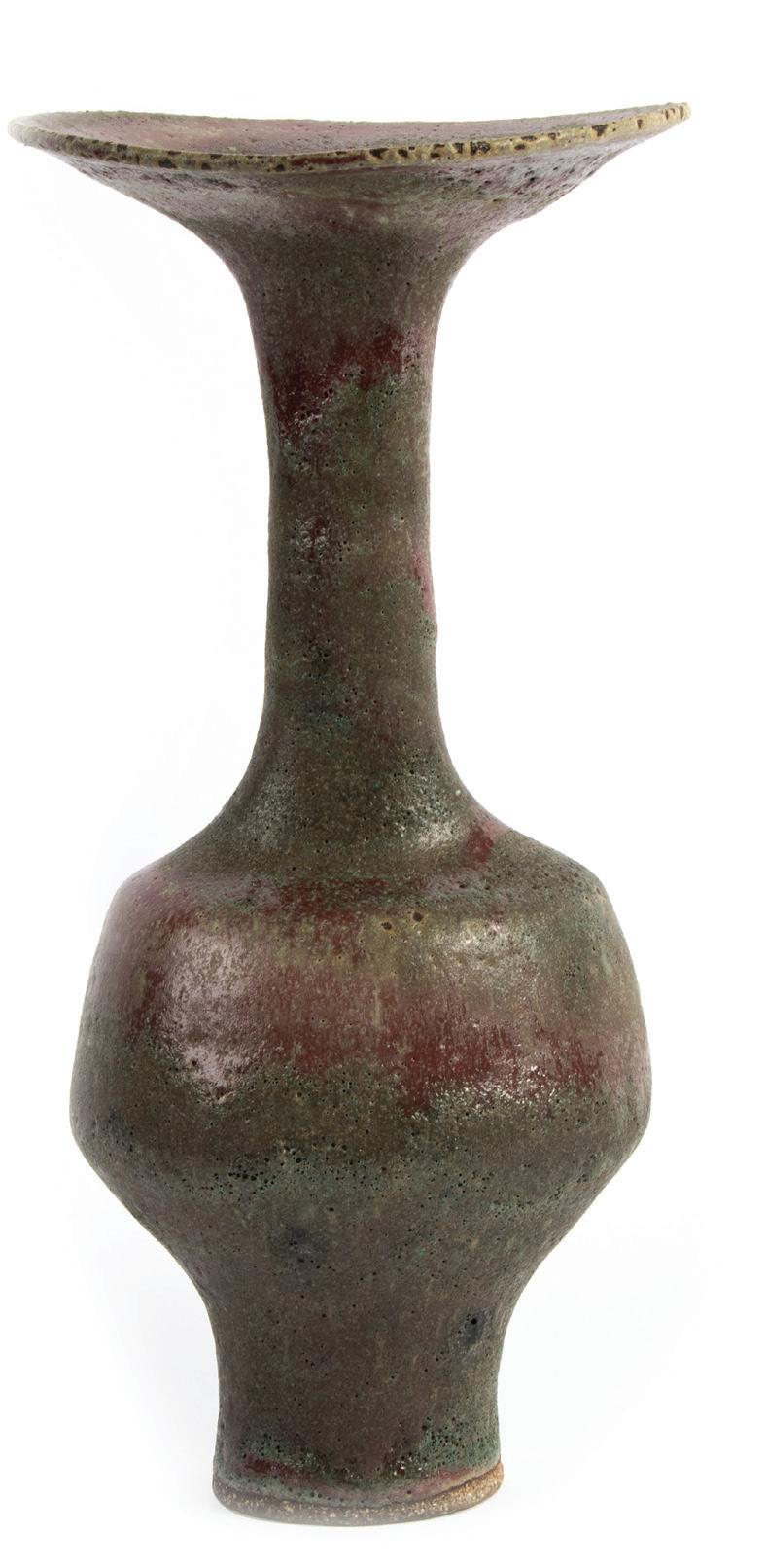
After she arrived in London in 1938, both Bernard Leach and William Staite
Murray were dismissive. Later on, Bernard Leach became a friend and advocate, praising her work as ‘free from the direct influence of other potters, ancient and modern’. The exception to that was Coper.
Her wartime production of decorative ceramic buttons, when factories had to concentrate on uniforms, was paralleled afterwards, when she and Coper made colourful tableware in contrast to industrial wares, limited to Utility white.

This was the foundation of her popular success. Her wares were rightly categorised as ‘metropolitan’ and were a relief from the worthiness of Leach’s rustic studio pots.
The exhibition is accompanied by an admirable introductory book, Lucie Rie, by Isabella Smith (Eiderdown Books, £10.99)
The Oldie August 2023 71
STOKES PHOTO LTD / TAKAO ŌYA / RACHEL DEAKIN / JASON HYNES
Lucie Rie (clockwise from above): jasperware, stoneware, earthenware, porcelain and buttons



Pursuits






GARDENING DAVID WHEELER WELSH WONDERS

If you already have a 2024 diary, I urge you to enter ‘Ferryside Garden Crawl’ on Sunday 23rd June.
Then begin to make plans to visit Carmarthenshire for a happy summer’s day. A score of seaside gardens within a mile of one another will open to the public, raising funds for the independent lifeboat service that keeps watch over our three local rivers: the Towy, the Taf and the Gwendreath.

We moved close to Ferryside (population fewer than 1,500) two years ago and have thus enjoyed two Crawls. You wouldn’t necessarily want to see all the gardens but, by chatting to fellow strollers around the village, you quickly discover the ‘must-sees’.
Ferryside sits on the east bank of the River Towy, where it debouches into Carmarthen Bay.
Said to be inhabited by retired clergy and medics (although the only dog collars I’ve spotted have been around the necks of disparate hounds, and I’ve seen no pensioned-off stethoscope dangling over an elderly rotund tum), the village remains little known.









Owing to fitful tides, its beach is not for bathing. Neither is Llansteffan’s, seen across the mile-wide stretch of water.
Memorable glimpses of Ferryside, simultaneously outrageous and droll, can be found in Jackdaw Cake, the 1984 autobiography by Norman (Naples ’44) Lewis. As a child, he visited his ‘mad’ Welsh aunts regularly. He tells of long-gone summer invasions of miners ‘from their hellish valleys’. They arrived by train (we still have a working railway station) and then crossed by boat ‘to take joyous possession of [Llansteffan’s] sands’ – much to the locals’ despair.
Not much Carmarthenshire gardening is recorded by Lewis. But at home in Middlesex, he lived close to Myddelton House at Bull’s Cross in Enfield. That was the lifelong home to one of my horti-heroes, nonagenarian E A ‘Gussie’ Bowles (1865–1954), self-taught entomologist, botanist, horticulturist, writer and artist, whose land – ‘which shared a special kind of stagnant beauty with that of the great neighbouring estates’ – he and his pals were free to wander.
On his last visit to Myddelton House, Lewis found Bowles ‘in his summer house, painting a fritillaria dug up on some Greek island. The summer house – his favourite place of refuge – was built over a lake.’ On it there floated ‘the great, enamelled shapes of water lilies of many colours’. ‘The banks had been planted with Japanese irises and a Chinese thicket of bamboo and thorns, to provide cover for the birds which flashed their wings and sang among them continually.’
Myddelton House is fondly remembered by a few old hands for its lunatic asylum. Louisa Parker Bowles recalled the old boy nurturing such botanical oddities as a ‘corkscrew hazel, a hedgehog holly and an unusual warped pine’, noting that a ‘pale pink wisteria Gussie planted by the salvaged Enfield
Market stone cross was particularly good this year’.
Three of Bowles’s books seldom stray from my bedside table. My Garden in Spring, My Garden in Summer and My Garden in Autumn and Winter were all published in the early years of the First World War. I cherish, too, his handbooks on crocuses and daffodils.
But back to Ferryside. The Crawl took us up previously unseen lanes and snickets. There, surprisingly, myriad roses were just beginning to give up the ghost after almost two months without any measurable amount of rain.
Below, London-bound trains wound themselves out of sight, hugging the coastline, dragging in their wake Ferryside’s many garden fragrances.
KITCHEN GARDEN SIMON COURTAULD BLACKCURRANTS
Currants are the name we give to those little, smooth-skinned fruit, usually black or red, differentiating them – not always logically – from the fruit we call berries.
In Germany, they are all Beeren: Erdbeeren (strawberries) and Johannisbeeren (blackcurrants).



But, in Greece, currants are dried grapes, the grapes of Corinth, which is also the name given to currants in France – when they are not called groseilles.

Now that this is quite clear, let’s stay with the fresh British currants. It was because of the concentration of Vitamin C in blackcurrants that Ribena was first produced in 1938 and given to children during the war. And the majority of blackcurrants grown today still go to make Ribena.
For those of us who grow them for the classic summer pudding, or for jam, jelly or a fool, the fruit should be ripe and ready now.

The Oldie August 2023 73
Rosy welcome in the hillsides: Ferryside
A blackcurrant bush is usually grown from a two-year-old plant, available between October and March. Some advise pruning as soon as it is planted. However, after two or three years, regular winterpruning is important, cutting out a third of the oldest stems to stimulate the young wood on which the currants will grow. A bush will probably need replacing after about ten years.
Most modern varieties of blackcurrant have ‘Ben’ in their name and are bred to produce large fruit; Ben Connan is a good choice for growing in a container.
Whitecurrants and pinkcurrants are also available, but are inclined to look anaemic and unripe.
Netting against birds is advisable when the fruit start to ripen, though, when growing redcurrants in the same space a few years ago, I found that the birds would leave the blackcurrants alone. Aphids and mites, attacking the leaves of the bush, can also be a problem and may need an insecticide.
Crème de cassis is, of course, the most popular use for blackcurrants in France. Redcurrant jelly is offered with a breakfast croissant, but when I once asked for some with roast lamb in a Paris restaurant, the waiter gave me a very old-fashioned look.
COOKERY ELISABETH LUARD
JAM TODAY
The soft-fruit season’s in full swing. As Simon Courtauld says, above, look out for blackcurrants, strawberries, raspberries, redcurrants, blueberries…
This leads to thoughts of home-made jam. If, like me, you’re a one-person household, it needn’t be a chore. Just cook up one jar at a time and freeze the rest of the fruit for when you’ve run out.
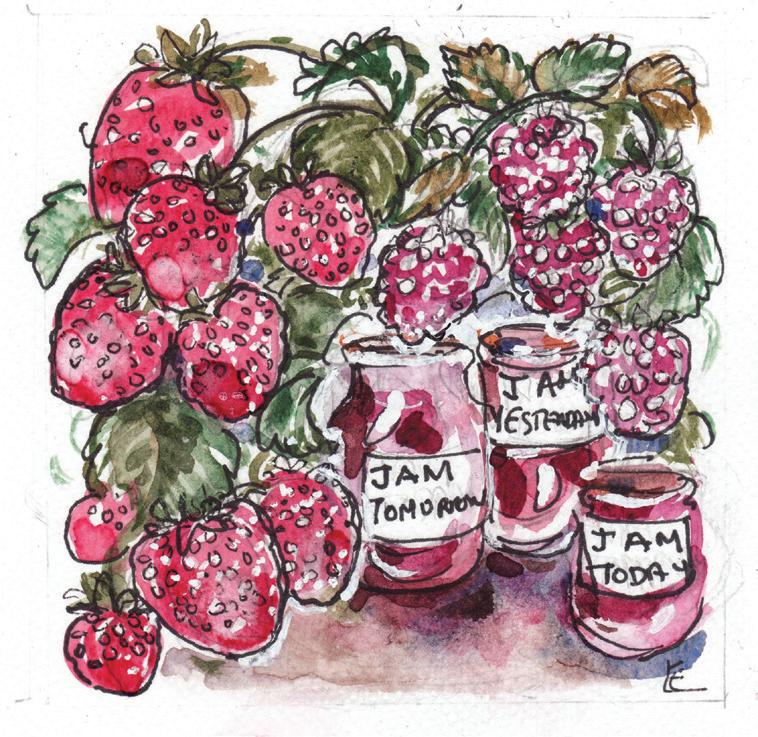
Proportions are key: as a rough rule of thumb, allow a pound of sugar to each pound of fruit. Raspberries and currants have plenty of pectin, the jellying agent that sets the juices when combined with sugar and heat. Strawberries and blueberries need a little help from preserving sugar, or the inclusion of lemon-pips and pith (tied in a scrap of cloth for ease of removal).
To prepare any berry jam, mash with about ten per cent less than their own weight of sugar in a bowl, and leave to make juice overnight. Next day, tip everything into a heavy-based pan and stir over a gentle heat till the sugar granules have dissolved and the juice, if dropped onto a cold saucer, wrinkles when pushed with a finger.
Pot up in sterilised jars, seal tightly and store in a cool, dark corner. To sterilise reused jars and lids, run through the full cycle of the dishwasher. Or fill the jars with boiling water and set in a low oven for 20-30 minutes, then drain and leave to drip-dry.
For an extra seal, top with a round of greaseproof paper dipped in whisky or gin or vodka. Store in a cool, dark place. Home-made jams are particularly vulnerable to mould. If the surface grows a furry little green hat, leave it undisturbed as an extra seal, and then lift off in one piece.
Inhale the fragrance: if this is a little alcoholic, tip the whole batch, whether one jar or 20, into a heavy-based pan and bubble up till the steam no longer smells winey. Rinse and re-sterilise the jars before refilling and sealing as before. This works for all jams, including commercially prepared ones.
No-cook raspberry jam
In a hot summer, there’s no need to cook this high-pectin fruit at all. Simply mix an equal volume of berries and sugar in a bowl and leave to make juice together overnight. Ladle straight into jars, lid and set on a south-facing windowsill to take heat from the sun for a day or two, till the juice, as observed through the glass, looks gloopy. Store unopened in the fridge.
Low-sugar strawberry jam
The method is a little labour intensive, but worth it for the joy of the fresh, sharp flavour of the fruit. Makes 4-5 jars.
4kg fresh ripe strawberries, hulled
1kg preserving sugar
150ml water
Pick over and hull the berries. Bring the sugar and water slowly to the boil in a heavy-based pan, stirring to
dissolve the sugar. Skim off the foam, then boil until a drop in cold water forms a ball (238°F on the sugar thermometer). Add the berries and leave to soften and make juice for 10 minutes or so.
Remove the berries to a bowl with a draining spoon.
Reboil the syrup and juice twice. On the third time, return the strawberries to the syrup as soon as it boils, and bubble up for 5-10 minutes, until the juice falls in thick drops that cling to the spoon.
Allow to cool before potting up in sterilised jars.
RESTAURANTS JAMES PEMBROKE DINERS FROM HELL
Have you sat next to a tapper at dinner recently?
You’ll know if you have because you’ll have bruising between your shoulder and elbow, on the arm nearest to them.
Tappers like to ensure that they have your full attention by tapping (and, even, slapping) your upper arm despite there being no chance of your escaping the table.
They are also very fond of their own jokes and like to bring a firm literality to the concept of delivering a punchline. They are the types who throw their heads back in hysterics at the most meagre of jokes, all the time tapping you as if practising their back hand. They kill pleasure.
On the Venn Diagram of painful dinner companions, they enjoy a massive overlap with the other tribes of darkness: people who can’t make their mind up about what to order; those who scan their plates for any chance of an allergic reaction (‘Me and parsley?’); who are full after the starter; who loved the previous owners; who ‘never normally come out this far’; who only want one glass of wine; who choose the restaurant because it’s the closest cuisine to the one they enjoyed on their recent holiday ‘but nothing like as good’; who, when you ask for salt and pepper, say you should really taste the food first. I could go on.
None of this has anything to do with the three Italian restaurants I tried recently – but be vigilant. Choose your dinner companions as carefully as your venue. La Goccia is part of the Petersham Nurseries township in Covent Garden.
It’s mostly set in a courtyard, which is great because, when you’re outside, there’s nothing wrong with staring at other tables. Inside, and you’re a gawper. Don’t over-order. Two plates each. Start off with one of their coccoli
ELISABETH
LUARD
74 The Oldie August 2023
(‘cuddles’ in Italian; deep-fried dough balls in English) with mortadella. Then a plate of their crunchy-fried chicken, followed by rigatoni with slow-cooked beef ragu. It’s possible to pay less than £100 for two.
This was good news because I had just paid double for the same number of small dishes at Il Borro, ‘the Tuscan bistro’, in Mayfair, where I was lulled by the promise of ‘farm-to-table’ dining.
Who was it who decided that you can charge a fortune for Italian food, if you say ‘It’s real’ enough times? Was it American Ruth Rogers, who will sell you an artichoke salad for £28 at River Café?
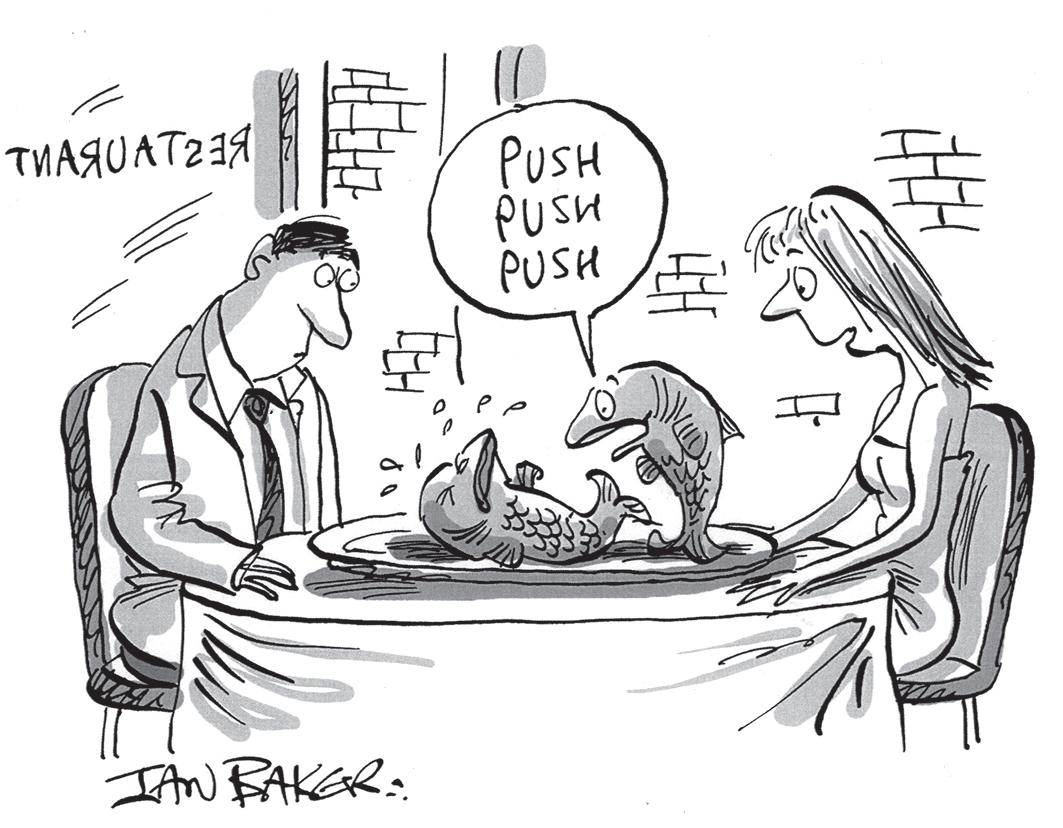
Italians have always prided themselves on being the masters of the margin: pizza, pasta, ice cream. So how can Il Borro charge £27.50 for a mushroom risotto? The cheapest bottle was £50. I rarely list ‘one to avoid’ but don’t be taken in. Or out.
Then I joined a Scottish soldier who I thought would love beef. I had been wanting to try out Macellaio, the small chain of Italian beef restaurants, purveyors of the Fassona breed from the Genovese hills. They’re very on-message: huge fridges stuffed with crimson carcasses, at which Desperate Dan would have baulked, and candles fuelled not by wax but by lard. Their Olympian steak tartare is minced by omnipresent butchers who would readily chop a tapper’s hand off were they to ask, in homage to Keith in Nuts in May, ‘Does this steak come from an accredited herd?’
DRINK BILL KNOTT VINTAGE VINES
We might appear knobbly and weatherbeaten – gnarled and wizened, even –and we may not be as prolific or productive as once we were. But, in our maturity, we can still teach uppity young whippersnappers a thing or two. Old age has its compensations.
What is true of people is also true of vines. Sadly, many winemakers –
especially those who prize quantity over quality - regard older vines as a rather tiresome burden. Once they fall away from their peak of production, after 25 years or so, they are grubbed up and replaced.
Why struggle with ancient, disparate vines planted by your greatgrandparents, low-yielding and eccentric, when you can rip them up and replace them with a shiny new streamlined vineyard of international varieties? No matter that the world already has quite enough Chardonnay and Cabernet Sauvignon: think of the profits.
Even worse, some of these vines have qualities that will die with them. They may be from varieties or clones that are threatened with extinction, denying winemakers now and in the future the chance to propagate their unique genetic material. And, unlike young vines, they do not need irrigating. They have deep, extensive roots and can fend for themselves, as they have done for many decades, even centuries. Sustainability and resilience are in their DNA.
Old vines can also make terrific wine, as I discovered at a recent tasting. Organised by The Old Vine Conference (oldvines.org), a non-profit organisation founded two years ago, it showcased 120 or so wines from ‘heritage’ vineyards.
The aim was to demonstrate that old vine wines deserve a premium category of their own. Thereby, they boost their status and – literally – save their skins.
Some of the vines from which these wines were made have not just survived storms, frosts, fires and droughts. They have even survived phylloxera, the disease that more or less wiped out European vines in the late 19th century. I tasted an Etna Rosso Riserva 2013 from I Custodi delle vigne dell'Etna 2013, made from vines that are 250 years old.
The combined efforts of The Old Vine Conference and the Old Vine Registry (oldvineregistry.org, a kind of online, work-in-progress Oldie for old vines, with listings as wide-ranging as Bolivia and Kazakhstan) are, I am pleased to say, attempting to redress the balance of the wine world in favour of vines with a few decades under their belts.
A word of caution, however. Wine merchant Richard Davis – the ‘D’ in DBM Wines: some of his favourite ‘old vine’ wines make up this month’s wine offer – recently went on a wine tour of Slovenia. In Maribor, he was shown what the Styrians claim to be the world’s oldest vine. ‘It was 450 years old,’ Richard told me, ‘and apparently the resulting wine is terrible!’
This month's Oldie wine offer, in conjunction with DBM Wines, is a 12-bottle case comprising four bottles each of three wines, all from venerable vines: a Piemontese white with bags of class, a Côtes du Rhône from star winemaker Claude Serra, and a superb Californian Zinfandel that would be perfect with the Sunday roast. Or you can buy cases of each individual wine.
Gavi di Gavi 'Bric Sassi', Roberto Sarotto, Italy 2021, offer price £14.49, case price £173.88


Bone-dry, richly textured Gavi di Gavi, from 40-year-old vines. Great structure and a very long finish.
Côtes du Rhône Rouge 'La Borde', Le Plan des Moines 2021, offer price £12.99, case price £155.88

Lovely, savoury Côtes du Rhône from a 12-acre plot north of Avignon. Mostly Grenache, from vines planted in 1949.
Old Vine Zinfandel, Scotto Wines, Lodi Valley, California 2017, offer price £12.99, case price £155.88

Plummy, ripe Zinfandel with a herbaceous edge and a touch of spice. From 50-year-old vines: long and delicious.
Mixed case price £161.88 – a saving of £31.03 (including free delivery)
visit
closes 18th July 2023.
TO ORDER Call 0117 370 9930 Mon-Fri, 9am-6pm; or email info@dbmwines.co.uk Quote OLDIE to get your special price. Free delivery to UK mainland. For details
Offer
HOW
www.dbmwines. co.uk/promo_OLD NB
The Oldie August 2023 75
Wine
‘The caviar is particularly fresh here’
SPORT JIM WHITE
THE NEW MANAGERESS
Way back in 1989, Channel 4 premiered a drama series called The Manageress.

Starring Cherie Lunghi and Warren Clarke, and written by the magnificent Stan Hey, it was based on what was then considered a ludicrous idea: a woman taking charge of a professional men’s football team. Except, then, professional football was an entirely male concern.
For comic and dramatic effect, Hey had chosen a premise reckoned absurd. Lunghi was in charge of an unnamed, struggling northern club after her Italian father, a UEFA executive, pulled a few strings to compensate for his lack of paternal involvement in her life.
Cue relentless sexist assumption from everyone concerned that a woman should be nowhere near the managerial dugout. After all, as the first episode’s title insisted, “This Is A Man’s Game”.
What gave the narrative arc even more propulsion was Lunghi’s obvious glamour. Hey enjoyed playing with the refusal of many to look beyond the idea that the only role someone like that could play in the game was to provide a bit of arm decoration. She was assumed to be nothing more than a wag.
The central twist was that Lunghi’s character was a football fanatic, who knew exactly what was required. When she took charge, she made an immediate difference by the application of brainpower. As well as sorting out their set pieces and organising the defensive wall, she upgraded the players’ diets and got them stretching ahead of training.
She even espoused yoga. And this was seven years before Arsène Wenger arrived at Arsenal. The second series centred on her push for promotion. Because she knew what she was doing.
It has taken 34 years but, finally, fact has caught up with fiction. In June, it was announced that Hannah Dingley was to take charge of Forest Green Rovers. She is the first woman to be put in control of an English men’s league team. By a nice, Hey-like irony, she replaced Duncan Ferguson, the granite-like Scot who for many epitomised the footballing man. Reflecting the times, Dingley won’t be the manageress – but interim head coach.
Even as she was appointed, much of the reaction suggested Hey’s satirical view had not entirely dissipated.
Assumptions were made about the word interim; that she was only there as a brief stopgap to bring some positive publicity to a club that had been
relegated the season before.
And it may be true that her spell in the technical area turns out to be brief.
But here’s the thing about Dingley: had a man been in possession of her experience, his appointment would not have raised an eyebrow because she has coaching’s top qualifications and has worked at all levels of the game. She knows her stuff. This is a proper manager, not a gimmick.
Her appointment will not be a one-off. The growing number of women in the game – coaches like Emma Hayes at Chelsea and Serena Wiegman, the woman leading the Lionesses to the World Cup after triumphing in Europe –has proven it.
Players respond to those who know what they are doing. Whatever their sex.
When he was writing the series, Hey probably didn’t think he was providing a blueprint for change. His priority was providing us with a bit of entertainment.
Three decades on, he looks like a prophet. With several clubs looking for someone with a bit of foresight and intelligence, it makes you wonder – what is Cherie Lunghi up to these days?
MOTORING ALAN JUDD GRAND CARS FOR A GRAND
It was one of those I-bet-I-can/I-betyou-can’t sessions.
I contended that, even in inflationary times, you can buy a clean used car for under £1,000 with a reasonable chance that it will last a year without major expense – maybe much longer.
Even if you throw it away after a year, it will have cost you significantly less than depreciation on a more expensive car. I reckoned you could find one online within minutes.
She argued that it wasn’t worth the risk. You end up with a grubby old banger on its last legs, depressing to behold, squalid and smelly to be in, with undisclosed horrors beneath the skin, likely to leave you stranded in the fast lane of the M6 on a wet Monday night. If old cars were so reliable, why would fleet-buyers buy new every two or three years?
So I set about finding some.
Having spent my car-buying youth at the bottom end of the market, I learned early on that if you want cheap wheels,
you shouldn’t be fussy about make. Look at anything; judge on condition. In particular, look at popular mass-market models too old to be fashionable; too young to be collectable.
Cars belonging to retired couples tend to have been little used and well lookedafter. That said, a high-miler with full service history (fsh) may be a better buy than a neglected low-miler. Look at trade and private sellers alike. The advantage of the former is that consumer law gives you right of return or repair in the event of a serious fault either present or developing at the time of sale.
The advantage of the latter is that prices are usually more negotiable.
Look closely at the wording of adverts, appreciating that phrases such as ‘only two previous owners’ means three owners – not two. I am put off by badly-written adverts, suspecting – rightly or wrongly – that if the seller is careless or ignorant about what he says, he’s probably careless or ignorant about what he’s selling.
Check the MOT history on the DVLA website, which will help verify mileage and indicate how well a car has been maintained. Prioritise cars with service history and, when viewing, make sure you read it. Minor bodywork marks or dents are acceptable, as long as there’s no rust, but walk away from scruffy interiors. They’re not nice to be in, are harder to sell on and suggest a slack attitude to maintenance.
Ten minutes on the AutoTrader website yielded a dealer-supplied, two-owner 2001 Ford Mondeo with 55,000 miles, long MOT and fsh, including 15 service bills and a cambelt change at 47,000 miles. It was red with small marks on the body and bumpers and some lacquer peel, but the interior looked smart and it had been serviced by the same garage for 15 years. Should be a safe buy at £899.
A private seller wanted £995 for his maroon three-owner 2004 Honda Accord: 106,000 miles, automatic with cruise control, documented fsh, MOT until 2024 and recent service, including new brake discs and pads. It looked clean and no doubt the price could come down a bit. What did you pay for the last service on your five-year-old?
Next was a good-looking 2004 ULEZ-compliant Fiat Panda at £999 with service history, 103,000 miles, a full set of tools and a tear in the side cloth of the driver’s seat. Use that to bring the price down.
Of course, as my interlocutor pointed out, I’d need to buy and run one for a year to prove my point. But they’re worth a punt – any of them.
76 The Oldie August 2023
Cherie in charge


Matthew Webster: Digital Life I spy with my little magic eye
This spring, to our delight, a pair of robins built their nest in our porch.
Five eggs were laid, three hatched and the parents diligently sped back and forth every 20 minutes or so, feeding them, although they seemed to pause at night.
Then one day all five lurched out of the nest and were gone.
How do I know all this? I was able to set up an internet-connected camera pointing at the nest. As it was activated by movement, we could watch from afar every time there was a bit of action, without disturbing the birds.
The advances made in this sort of
Webwatch
For my latest tips and free newsletter, go to www.askwebster.co.uk
henry-moore.org
Sculptor Henry Moore was born 125 years ago this July. His foundation’s website is a good starting point to learn about him.
They work for you
theyworkforyou.com
Collates open data from the UK's Parliaments – easy to follow.
I will happily try to solve your basic computer and internet problems. Go to www.askwebster.co.uk or email me at webster@theoldie.co.uk
camera technology are nothing short of astonishing. When I recall the dramas associated with security cameras 30 years ago – cables, power supplies, huge video recorders – not to mention the considerable cost, I shudder.
Nowadays, there are more options than you can count, and you could set up a home network with three cameras for well under £200. I bought the Blink system sold by Amazon; there are many others. The cameras are each about the size of a cigarette packet and all you do is fix them where you want them (one screw), link them by Wi-Fi to the base station (about the size of a matchbox), connect the base station to the internet, and you’re done.
By using a mobile phone, you can control the cameras and see what they see, provided your home Wi-Fi is working. The camera batteries seem to last for years.
They will record both sound and vision, if that’s what you want. In the case of our robins, I simply taped a camera to a convenient window ledge, and we were able to eat our breakfast while watching and listening to the chicks having theirs.
Some people put them in infant bedrooms or use them to keep an eye on the dog while they’re out. Video doorbells have also become popular. They work exactly the same way, and let you see on your phone who is at the door and even converse with them, from wherever you are.
This is all fine, but it’s observing wildlife that I find most intriguing. A while ago, I was given a trail camera –trail, that is, in the American sense, meaning a path through countryside.
It works the same way as my robin cam; you strap it to a tree in your garden and it takes a short video every time it senses something moving within its range and saves it on a removable memory card.
Every few days, I retrieve the card, stick it in the appropriate slot in my laptop and see what’s been going on.
We’ve seen owls, deer, foxes (one with a pigeon in its mouth), cats, rabbits, hares and many birds. I’ve also recorded my wife, clad in her pyjamas, checking her seedlings early in the morning, and had a good view of a grandson hiding from his mother.
There are some privacy concerns, particularly with any cameras indoors. These could easily be seen as intrusive, especially if they are used clandestinely. Airbnb forbids the use of concealed cameras in their properties and any camera at all in ‘private’ areas, which seems a good policy.
If you have these cameras, they should be as obvious as possible, and you should let people know if they are likely to be filmed or, better still, reassure them that they certainly won’t be filmed. Surely that’s only good manners.
Happily, for us, the robins didn’t object at all.
Margaret Dibben: Money Matters
Battle against hidden charges
That cheap flight is no longer a bargain – once you’ve paid extra so you can sit together, carry on a bag too large to fit under the seat and avoid the scramble with priority boarding.
The price of an Airbnb balloons with the owner’s charges for cleaning when you leave. Car-hire companies’ add-ons for insurance, fuel and additional drivers crop up only when you arrive to pick up the car – and wreck your holiday budget.
Tickets for sports events and concerts
are already expensive; additional handling fees and service charges for no apparent purpose can make it difficult to justify the cost.
In the UK and the EU, you cannot be forced to pay unexpected charges at the last minute. So you can refuse to pay a service charge on a restaurant bill unless you were told, before ordering, that it was compulsory.
But if when buying online you refuse to pay for postage or booking fees, the
retailer won’t deliver your purchase. Consumer protection is slow to keep up with this new way of shopping.
You can easily search the web to find a better deal, but the internet has partly caused the problem in the first place. Because you can quickly compare offers, some booking sites are tempted to advertise artificially low prices and make up the difference by throwing in sneaky last-minute extras.
By the time you have worked your
78 The Oldie August 2023
way through all the options when ordering, vendors know you want that item and are more likely to pay up, simply so as not to waste your time and effort. The extras are small enough – so you fail to adjust your perception of value for money.
These charges are junk fees and the process is called drip pricing, gradually adding costs as you move through the process of buying. It is not illegal. A few months ago, Rishi Sunak threatened action against drip pricing and the Department of Business and Trade will be investigating how widespread and damaging it is.
In the US, where mandatory fees can be added at the last moment, President Biden plans a junk-fee bill to outlaw the practice. At checkout, some American hotels charge unexpected but compulsory ‘resort fees’ for facilities such as the gym and Wi-Fi, even if the guests did not use them. An upmarket hotel in the UK adds a last-minute five-per-cent room rate ‘to cover a portion of costs associated with our employees’ – though they cannot force you to pay.
Consumers can fight back. The Competition and Markets Authority (CMA) has launched a new phase of its
Online Rip-off Tip-off campaign, which encourages people to report any retailers who break the law or impose hidden charges. This link takes you straight to the digital reporting form – https:// ripoff-tipoff.campaign.gov.uk.
The next stage in improving consumer protection online is the Digital Markets, Competition and Consumers Bill – flagship legislation to protect online customers from rip-offs and significantly strengthen the CMA’s powers. It started working its way through Parliament last April and perhaps, in time, drip pricing will be legally banned.
The Oldie invites you for A Taste of Castile and León with
Insider’s Travel
18th to 25th April 2024
Friday 19th April – Segovia
Following the great success of the tour of Extremadura in May, we are inviting you for a tour of the varied landscapes of Castile and León. This time, on the recommendation of an Oldie-reader, we have teamed up with Insider’s Travel, who specialise in bespoke tours of the Iberian Peninsula. They have devised an itinerary to show us the highlights of the area, including Avila, Salamanca and Segovia. Through their contacts, they have arranged some visits to award-winning Iberian ham-producers, cheesemakers and wineries in the Sierra de Francia and Ribera del Duero.

We will be based both in the Parador de La Granja, in San Ildefonso, with spa, and in the Hospes Convento de San Esteban (www. hospes.com), in the amber city of Salamanca.
Joanna Wivell from Insider’s Travel and Oldie publisher, James Pembroke, will lead the trip.
Thursday 18th April – arrive at San Ildefonso
Depart Gatwick at 10.45am with Iberia Express; arrive at Madrid Adolfo-Suarez Barajas airport and drive over to the small town of San Ildefonso. A guided visit of the 18th-century summer palace and gardens.

Guided tour of the World Heritage city of Segovia. We walk under the awe-inspiring Roman aqueduct, in use until the 1970s, and through Segovia’s small bustling streets to the 14th-century Alcazar castle, said to have inspired Walt Disney. We take in Romanesque architecture and Sephardic heritage en route.
Saturday 20th April – the wine region of Ribera del Duero
We drive along the Golden Mile near Penafiel, which is home to some of the best tempranillo in the country, and stop to visit friend and winemaker Javier Bohórquez at his winery. A visit to the castle before we head back to La Granja for free time before our local dinner.
Sunday 21st April – Avila
Check out of the hotel and head west to Avila, which boasts the most complete city walls in the world and more Romanesque churches per capita than any other town in Spain. After lunch, we continue to Salamanca to stay at the lovely 16th-century Hospes Convento de San Esteban (www.hospes.com).
Monday 22nd April – Salamanca
Guided tour of the 12th-century Gothic and 18th-century Baroque cathedrals, the university, founded in 1218 by King Alfonso IX, and the Casa de las Conchas. Lunch and a free afternoon before dinner at a local favourite in Salamanca and some more Ribera-tasting.
Tuesday 23rd April – Guijuelo and its hams
We will visit award-winning ham curers Simón Martín. On to the Sierra de Francia village of Mogarraz to visit Agustín Maillo at his winery, La Zorra. Lunch with splendid mountain views from the restaurant, Mirasierra.
Wednesday 24th April – Zamora
En route to Zamora, we visit artisan cheesemakers and Harrods supplier Vicente Pastor. Guided tour of Zamora, which is known mainly for its Romanesque architecture and also for its Byzantine cathedral.
Thursday 25th April
Check out of the hotel. Guided tour of San Lorenzo de El Escorial, final resting place of the Habsburg king Philip II, including the monastery, seminary, basilica and royal library. Lunch in El Escorial before our drive to Madrid airport to catch the 6.40pm Iberia Express flight which lands at Gatwick at 8pm.
HOW TO BOOK: Call 01225 427311 or please email Katherine at reservations@theoldie.co.uk. Price per person: £2,995 which includes accommodation, guides, all meals, wine with meals, transport and entrances. You need to book and pay for your own flights. Single supplement: £330. A non-refundable deposit of £500 will be required, with the full balance due on 10th January 2024.
The Oldie August 2023 79
Avila has the world's most complete city walls
The summer palace La Granja, San Ildefonso
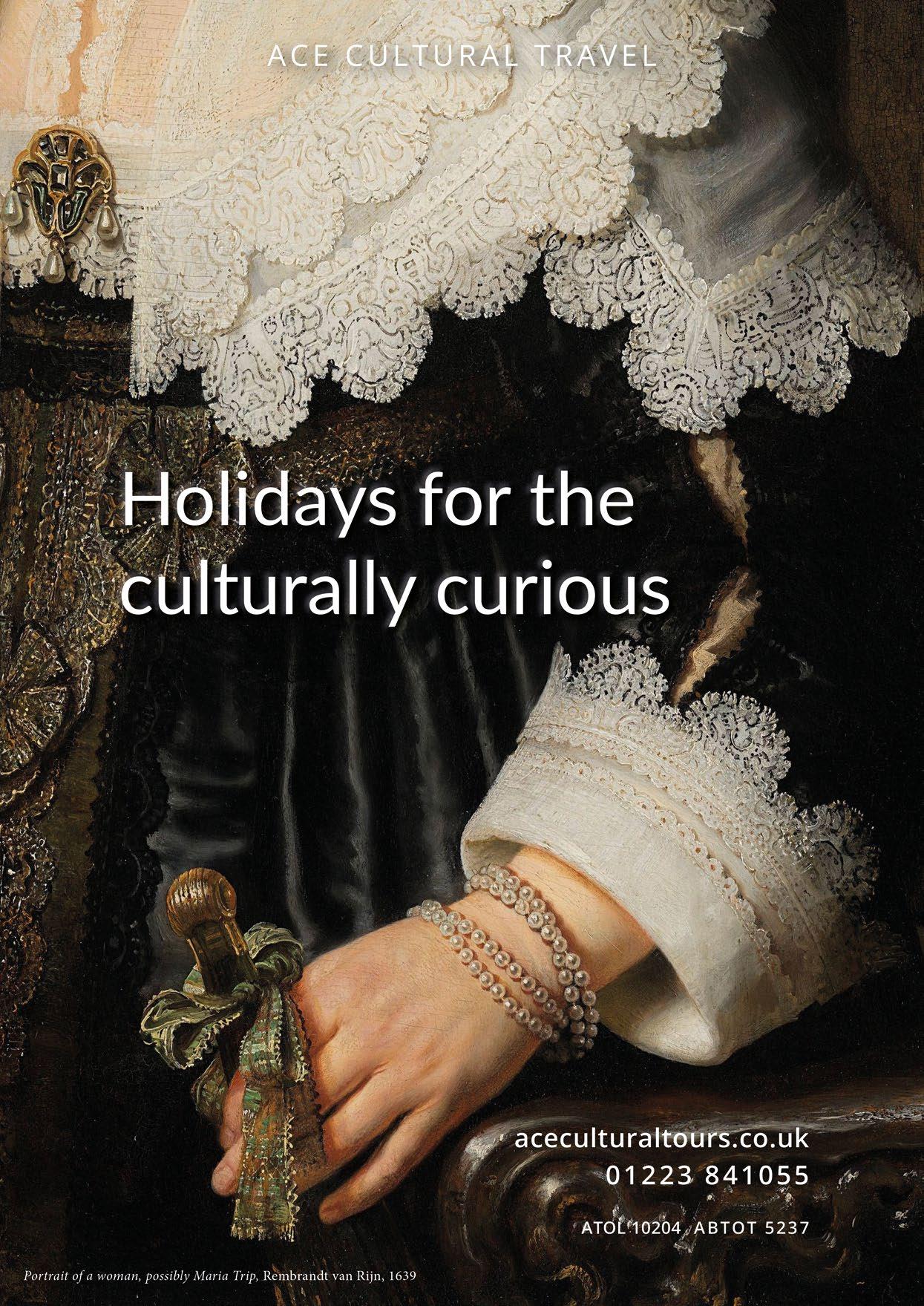
The Shag
by john mcewen illustrated by carry akroyd
One genus and three species of animal are named after Aristotle. The only bird among them is the shag (Phalacrocoracidae aristotelis).
Its English name derives from Old English – sceacged/hairy – and refers to the small crest adults sport in the breeding season.
Adam Nicolson, in The Seabird’s Cry, describes an encounter with a nesting shag on his Shiant Isles in the Minch:
‘As I came over a lip of rock, there was the shag right in front of my face, a foot away, juddering and hissing, its whole head shaking in rage and fear, terrifying as much as it was terrified of me, a fluster of beautiful dark green iridescent feathers in the mayhem of kelp stalk and guano that was its nest.
‘Ancientness bellowed at me from inside the filth-lined crevice, where, in the shadows, two or three featherless, scrotal-skinned shag chicks writhed like embryo sea monsters from the past … as if I had come on some transitional creature, half-pterosaur, half-bird, gleaming in the oily dark of its feather sheath, blazing in the deep rich yellow of its gape and gizzard.
‘Around me, in the air, the other shags coming into the colony honked and hooted, the deep, guttural cry of the arriving males, something from beyond any world I had ever known.’
As this illustrates, seabirds require effort on the birdwatcher’s behalf, the shag more than most. Unlike the commoner and larger cormorant, which carries the name of the species, the shag appears inland exceptionally.
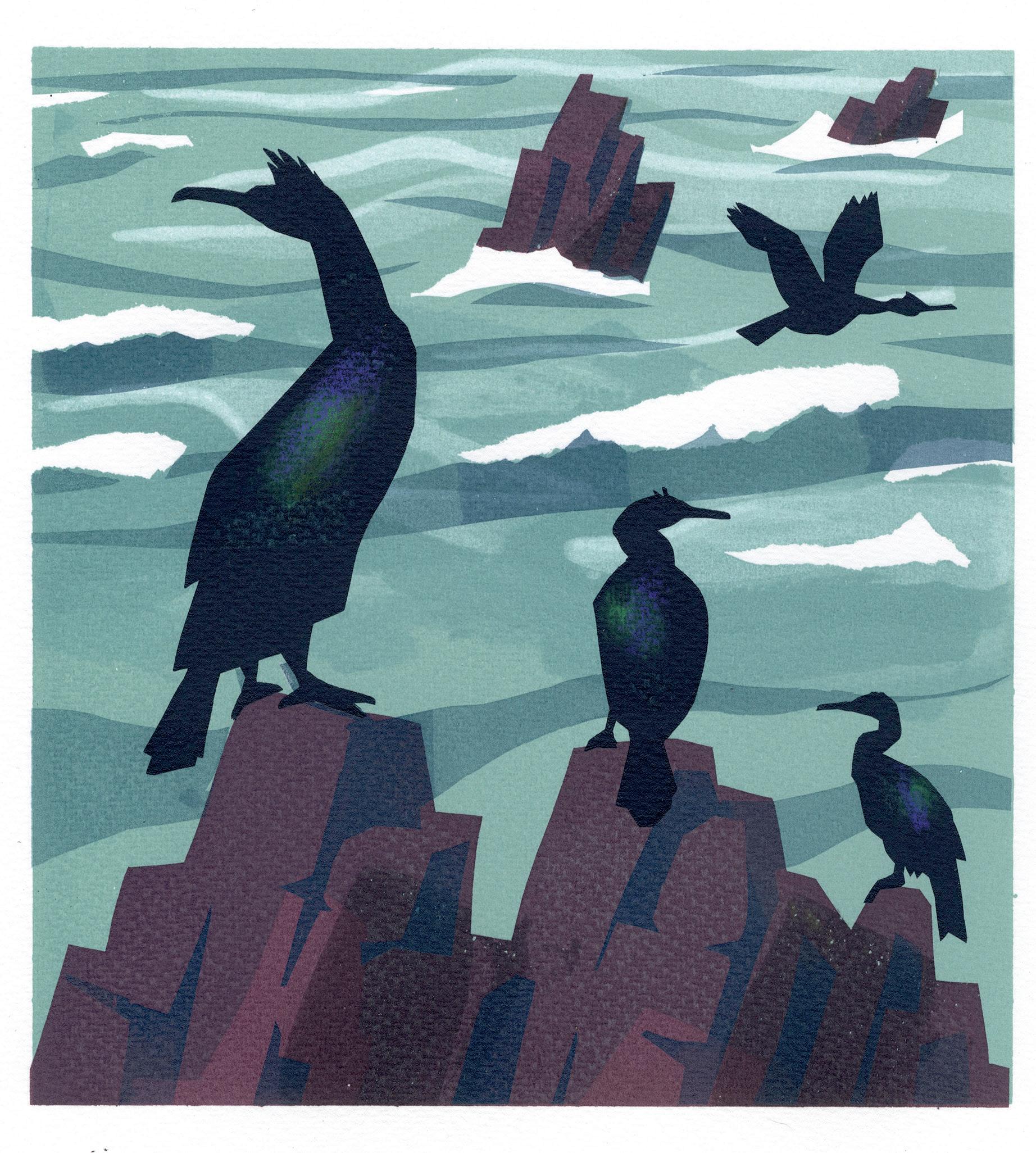
It requires rocky coasts – hence its presence in Shetland, Orkney and the western coasts of the British Isles. But in winter, when the resident population is boosted by juveniles and fish-following migrants – from 17,500 breeding pairs to 110,000 individuals – they pepper the entire British Isles coastline where cliffs, caves and rocks are available.
They hate rain – so caves are a favourite breeding and roosting place. Shags are renowned for their diving abilities; no bird is better able to cope with a rough sea.
Cormorants are more communal and come inland, roosting and nesting in trees and fishing, to the dislike of anglers; on the coast they incline to estuaries, even harbours.
Diet rarely brings the two birds into competition. Cormorants like flat fish and shrimps in seawater, whereas shags depend largely on free-swimming sand eels.
In Ireland, the shag is the ‘green
cormorant’ – it has a green iris, but its green refracting plumage appears black to the naked eye at a distance. Like cormorants, shags hang their wings out to dry, albeit less frequently.
Shooting seabirds driven from the cliffs over guns seated in offshore boats used to be a popular sport. The birds were valued as challenging targets and shot as vermin rather than for the pot – until the Second World War, when shags sometimes appeared as ‘black duck’ in ration-reduced London restaurants.
Traditionally, if eaten, shag was thought best after being buried for a week.
The Oldie August 2023 81
CARRY AKROYD
Travel Putin and the Argonauts

Justin Marozzi drinks his way across Georgia in search of Jason and the Golden Fleece
Here I am in a cool cellar in Tbilisi, wine to the left of me, wine to the right of me.
As each glass is reverently polished off – this is no time for spitting – it is almost possible to imagine that this very act of drinking wine is a critical part of a modern-day quest for the Golden Fleece.
If that sounds a little far-fetched, let’s not forget there is a tantalising connection between Georgia’s ancient winemaking heritage and the legend of Jason and the Argonauts.
When fleece-seeking Jason set off on his improbable expedition, he sailed to the kingdom of gold-rich Colchis, on the Black Sea coast of today’s western Georgia.
‘The wealth of the regions about Colchis, which is derived from the mines of gold, silver, iron and copper, suggests a reasonable motive for the expedition of Jason,’ writes Strabo, the Greek geographer of the first century BC.
Inconveniently for Jason, the Golden Fleece was guarded by a sleepless dragon in a sacred grove close to the palace of King Aeëtes. More conveniently for Jason, the king’s daughter Medea fell in love with him and gave him a potion of special herbs and wine to put the dragon to sleep.



It did the trick. Jason was able to nip in and pinch the fleece, and even managed to sail off with his inamorata. Job done – barring future encounters with Sirens, flesh-burning dresses,
vengeful Medea and wrathful gods. And wine was at the heart of Jason’s triumph.
‘We’re so proud of our 8,000-year heritage of winemaking,’ says Thea Adamashvili at Vinotel, our wine-tasting base in Tbilisi, interrupting these mythical speculations. ‘This is not legend. This is reality.’











During recent archaeological excavations at Dmanisi in southern Georgia, she says, tartaric acid, a key indicator of the presence of wine, was found on clay fragments dating back to the sixth millennium BC.
After the dead hand of the Soviets, who turned Georgian winemaking into a factorybased, high-volume, low-quality affair, the ancient method using qvevri – clay amphorae – to ferment the wines underground is enjoying something of a renaissance.
picture of Putin, a reference to the territories of South Ossetia and Abkhazia that Russia annexed and occupied in 2008 to a deafening, hand-wringing silence from the West. ‘F— Ruzzia’ and ‘Ruzzia is a terrorist state’ graffiti are likewise everywhere.
The millennial history of winemaking is also celebrated from one end of this diminutive country to another. High on a bluff overlooking the capital stands the magnificent aluminium statue of Kartlis Deda, Mother of Georgia. In one hand, she bears a keen-edged sword for her enemies. In the other, she holds a clay bowl of wine for friends.
Sheepish: 5th century BC bracelet, Colchis









History is everywhere in Georgia, yet it often feels like a history that has been imposed on this ancient Christian nation in the Caucasus, rather than history that it has shaped itself. Perhaps that is only to be expected in a tough part of the world where Georgia counts serial invaders Russia, Turkey and Iran as neighbours.
Reminders of the intrusion of both ancient and modern history into the present are ubiquitous. ‘I occupied Georgia’ proclaims a car sticker with a



Medieval monasteries routinely display the carved emblems of grapes and vines on their crumbling façades.
Medieval monasteries and vines on their crumbling façades.
Contemporary history can also be found in Tbilisi’s cosmopolitan, buzzing bars.
In one, we find a Ukrainian and a Russian working together behind the bar, serving heady Georgian craft beer to an eclectic, multinational throng of drinkers, including a Russian tech entrepreneur and his Belorussian model girlfriend. Both fled their homelands after Putin invaded Ukraine.
It is time for my wife and me to flee, too, to the eastern winemaking region of Kakheti. The road to Telavi and Sighnaghi leads through Tsinandali, the Italianate summer mansion of Prince
82 The Oldie August 2023
Alexander Chavchavadze, the Russianborn Georgian poet, military man and father of Georgian romanticism, who also happened to be the creator of his country’s largest and oldest winery.
The contribution to Georgian winemaking of this energetic man of action and man of letters is happily recalled every time a glass of Tsinandali, mouth-smackingly crisp white wine, is raised. We do this regularly – alongside plates of steaming khinkali dumplings, pillowy khachapuri cheese-filled bread, lamb chakapuli stew, pork mtsvadi kebabs, bean-filled lobiani bread, salty sulguni cheese … and so the waistexpanding delicacies continue.
This is no myth. It is an epicurean paradise.
Georgia is also a triptych of monks, monasteries and mountains. Sometimes the bearded holy men allow wine in to make it a high-spirited quartet. In Alaverdi Monastery – for many centuries the tallest building in the country, until the construction in 2004 of Sameba, Tbilisi’s gold-topped cathedral – monks working under the genial command of Bishop David tend to the monastery’s vines, as much as to their vows and prayers.
Sublimely positioned in the Alazani Valley beneath the Greater Caucasus –a jagged line of snow-crested peaks slashed across the sky – Alaverdi must be one of the world’s most beautiful places to make wine. The monastery’s origins date back to the fifth century, and each bottle label still bears the words
‘Since 1011’, a boast as glorious as this empyreal setting.
The Georgian Military Highway is calling. Quite what our underpowered and ancient little Mitsubishi Pajero will make of this famous mountain route is anyone’s guess – but there is only one way to find out.
Although its name conjures merely martial expeditions, this is also a procession of medieval and early modern architectural gems. At its southern terminus, just north of Tbilisi, the ancient capital of Mtskheta is home to soaring Svetitskhoveli Cathedral, the 11th-century burial place of kings. Next comes Ananuri, a complex of fortress and churches crouching over the Aragvi River.
My favourite, though, is the heavengrazing Gergeti Trinity Church, looming high above the village of Stepantsminda, a tiny, 14th-century mountain-framed place of worship which is surely one of the most wondrous places on our planet.

On the return journey from this spirit-lifting site, the Pajero comes a cropper. We lose power and limp to the side of the road as huge container lorries thunder past. The advice from the car company is keep driving until you lose power, stop, wait a bit, start again and repeat.
Impatient WhatsApp messages are exchanged. ‘We are operative, my friend. Everything vill good,’ the car-hire man says firmly. Eventually, after a series of nerve-racking, lorry-dodging manoeuvres, a replacement car is provided and serene progress resumes.
After the obligatory stop at Gori to marvel at the improbable museumcum-shrine to Stalin, we dash west to Kutaisi, Georgia’s languid, tree-shaded second city.


On its outskirts in the spa town of Tskaltubo, we trample through Sanatorium Medea, named after Jason’s lover, one of around 20 abandoned Soviet sanatoria.
Among the forest of Corinthian columns, trees grow through the ruins and marble stairs sweep up into an empty sky. A number of these forsaken sanatoria surreally still house the last of 12,000 refugees from Abkhazia – history again intrudes into the present.
There is time for lightning visits to admire the under-restoration frescoes of Gelati Monastery, a 12th-century masterpiece. Then on to cliff-hanging Motsameta, Place of the Martyrs, which houses the remains of two aristocratic brothers who rebelled against Arab Muslim occupiers in the eighth century.
In a pitiful effort to dilute our winesoaked itinerary, we flash south to Borjomi, home to Georgia’s eponymous brand of sparkling spring water, but it is no good. We must have more wine – qvevri or otherwise; it doesn’t matter. Glasses clink again. Wine glistens. We toast the Golden Fleece. Nika, the car man, was quite right. Everything vill good.
Justin Marozzi is author of The Man Who Invented History: Travels with Herodotus
The Oldie August 2023 83
Left: Sameba Cathedral, Tbilisi, 2004
Above: Gergeti Church, 14th century
Right: Putin annexed parts of Georgia in 2008
Overlooked Britain Veni, vidi, WC...
lucinda lambton
The Romans built a huge public lavatory for legionaries on Hadrian’s Wall 1,900 years ago – and they’re still in full working order

For many years, I had the great good sense of plunging, with passionate interest, into the lavatory.
By that, I mean relishing its history since earliest times. It was invented in Great Britain. Many many HURRAYS!
On the cold, windswept wastes of Northumberland, you discover the very first of such arrangements for man’s relief (pictured).
Three miles north of Bardon Mill, there are the most remarkable ruins of a Roman fort, with a great assembly of stone seats on which men could sit side by side, relishing in, rather than recoiling from, each other’s company.
Hail to such conveniences – always
such an important element of our lives.
The Romans established an extraordinarily sophisticated – as well as efficient and even elegant – sanitary system in Britain.
From the splendour of Bath (Aquae Sulis) down to the most dextrous construction of a pipe, one finds an understanding and appreciation of sanitary needs that were not to appear again, on such a scale, for more than 1,500 years.
Their baths were steeped in luxury, with pools of hot and cold water, as well as sweating rooms and showers.
Wallowing in this splendour, the bather was spread with unguents and oils
– or sand, if the dirt was serious. His skin was then scraped clean with a strigil. There were quantities of public baths. So there was little need to have one in your house – although there was an immense private bathing pool, 30 x 18 feet, at Chipping Warden, Northants.
Less appealingly, the latrines were public, such as at Housesteads Fort near Hexham. The legionaries would enjoy the sight, as well as, I’m afraid, the sound of their companions as they sent up their offerings to Stercutus, the God of smell, Crepitus, the God of noise, as well as to Cloacina, the Goddess of the sewers. She was one of the first of the Roman deities and was believed to have been named, if
84 The Oldie August 2023
DAVID STEELE / MICK SHARP / PRISMA ARCHIVO /COLAIMAGES / ALAMY
What the Romans did for us: legionaries’ latrines at Housesteads Fort, Hadrian’s Wall, built in 124 AD
you please, by Romulus himself.
Impressive latrines also survive at Isca (pictured), the Roman fort in Caerleon, south Wales.

The Romans painted the walls of their latrines with deities and other hallowed emblems to protect them. Vessels for relief were put on street corners. They could be used without charge until the Emperor Vespasian discovered that they could be used for the profitable fulling – or cleansing – of cloth.
In 70 AD, Vespasian imposed a urine tax on the distribution of urine from Rome’s public urinals. When Vespasian’s son Titus said he thought the tax was disgusting, Vespasian declared, ‘Pecunia non olet’ – ‘Money doesn’t smell.’
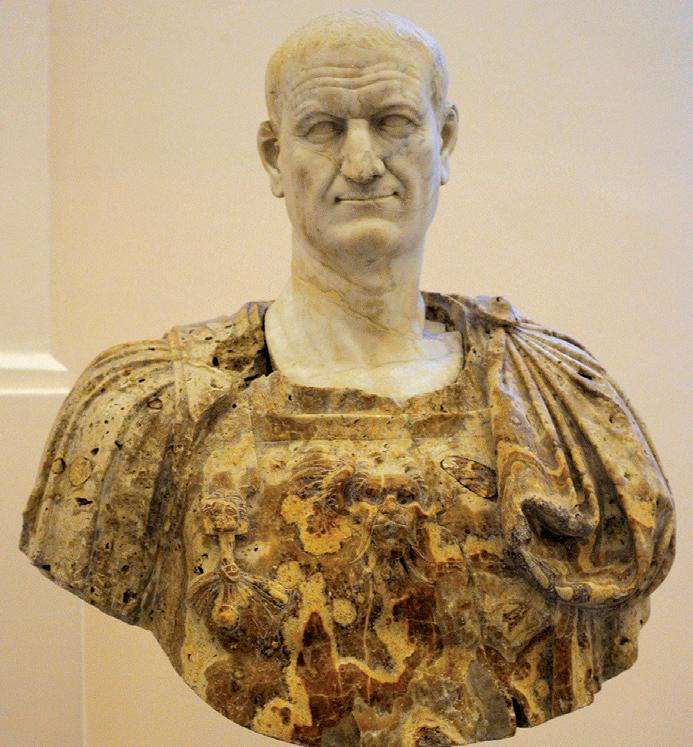
There were other benefits. Pliny noticed that the Roman fullers who worked with human urine never suffered from gout.
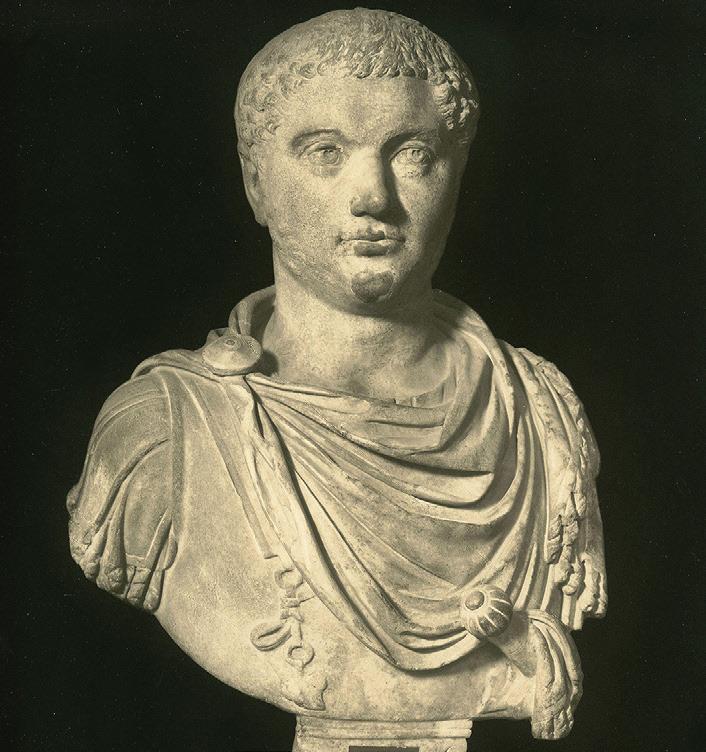
There was no lavatory paper in public latrines. Instead, sponge sticks were kept in containers of saltwater. Seneca wrote of the horror of a German slave who committed suicide by ramming a sponge stick down his throat. There was also the
grim tale of Roman soldiers who, thinking themselves disgraced at being asked to build a common sewer, killed themselves together.
The Romans’ luxuriant depravity reached its grim peak when chamberpots were made of rare stones and metals.
In 1750, Samul Rolleston wrote of Emperor Heliogabalus as ‘a monster of lust, luxury and extravagance, who, according to Lampridus, owned closestool pans of gold, but his chamber pots were made, some of myrrh and gold onyx.’ Heliogabalus’s end was just and fitting: he was killed in a public latrine.
‘The chamberpot had been invented by the Sybarites because they would not be at the trouble of moving,’ wrote the Rev Thomas Dudley in his Encyclopedia of Antiquities.
At Housesteads, a continuous wooden seat was arranged to shelter those sitting
in the teeth of the wind, on high, over a deeply dug outer sewer.
Beneath the sitters’ feet, there was a smaller watercourse, into which was dipped the monstrously unappealing sponge sticks.
There were no springs or wells nearby – rainwater was used for flushing. It flowed in both channels from great stone tanks and then on through pipes and down the hill, where the manure was collected and the liquid – liquid gold – was poured into pots for the fulling of cloth. It is thought that the stone basins were used for washing hands.
The ancient sanitary arrangements are all in perfect working order today – as they have been since 124 AD.
The Oldie August 2023 85
Legionaries enjoyed the sight and sound of their companions on the lavatories
Lucinda Lambton is the author of the history of the lavatory – Temples of Convenience & Chambers of Delight
Left: Garrison latrines at Caerleon – Roman Isca – founded in 74 AD
Below: Emperor Vespasian (left) and Emperor Heliogabalus
On the Road
The piano man’s Grand Tour
Jools Holland’s greatest architectural hits – from 14th-century Nuremberg to the 18th-century Gothic Revival. By
 Louise Flind
Louise Flind
Anything you can’t leave home without?
I’m a very keen tourist, and I used to take John Michell’s Sacred England and the National Trust Handbook.
Is there something you really miss?
Quite a lot of musicians take their own pillow. Noel Gallagher takes his pillow and if the pillow in the hotel is more comfortable, he swaps it.
What is your favourite destination?
The late-medieval world in Flanders and Germany.
What are your childhood holiday memories?
My father took me to Paris when I was 14. I had long, black, oily hair and I’d had it turned into an embarrassing mullety bouffant. He took me to this little jazz club, and there was a noted American jazz pianist playing. I had a play, and my father said, ‘Do you think he’s any good?’ This old pianist said, ‘He’s not going to do anything else.’
Do you come from a musical family?
Both my grandmothers played the piano and probably the first thing I heard was my mother playing Careless Love Blues when I was about four.
At what age did you first sit at a piano?
When I was about eight, I heard my uncle playing the boogie-woogie.
Did you teach yourself the piano?
Essentially, yes. I became obsessed with trying to figure out the boogie-woogie.
Did you do any music at school?
I was the only person who picked music, and the elderly teacher liked only classical music. He showed me the theory of music. So I could read chords.
What was your first big break with Squeeze? We’d start playing in a pub and the landlord would give us money. That turned into a group who were signed with a label, toured in America – the things you dreamed of. We got a gold record and Gilson Lavis, the drummer,
said, ‘Great. I can put it over the damp patch in my sitting room.’
How did you join Squeeze?
There was an ad in a paper-shop window.
Are the Squeeze songs very much about the background of the band?
I think all great music is an expression of what the person is.
Do you prefer performing live to television? You get a confidence on stage and knowledge of how to engage with an audience, and that gives you the confidence to do the stuff on television.
Do you prefer performing solo to playing in a band?
The most effective thing is with a big band, but, equally, if it’s just me, the piano and Ruby Turner, that’s really great too.
at twilight when people have their lights on. In Europe, I always have a bicycle.
What is the most exotic place you’ve ever played in?
We played in the Dubai Jazz Festival and there was a sandstorm – if you opened your mouth, it was filled with sand…
And the least exotic?
Early on, Squeeze played the Hope & Anchor in Islington and there were three people and a dog watching, and one by one the people left and then the dog left.
What’s your favourite building and your favourite architectural style?
The 18th-century Gothic Revival anywhere in Europe, and Nuremberg –the high-Gothic, late-14th-century stuff there.
Who would be your dream person to play with?
Betty Smith and Bach doing the string arrangements, John Lennon playing rhythm guitar and T-Bone Walker playing lead.
What’s your favourite food?
When I was small, Nan’s roast dinner. And in very grand hotels or houses, you get something similar.
Do you speak any languages? No – it’s my biggest regret.
What’s the secret of your TV show
Later… with Jools Holland that’s run since 1992? It’s unbelievable. The show is a mix of things with the great legends of music, people on their way up and contemporary stars. If we’re lucky, we’ll get a million viewers watching and afterwards millions more on YouTube.
Do you have intensive rehearsals before your show?
I’ve never done that in my life.
How do you look after yourself on tour? I’m very nosy, and I like walking around
The strangest place you’ve ever slept? In Leverkusen, we couldn’t get into a hotel. We stayed in a centre for Hare Krishna people and all the seats were orange. I slept very well.
Do you like coming home?
Always – the same way I’m delighted to get out of church…
Do you have any travelling tips?
If a car doesn’t have a spare wheel, don’t buy it.
Jools Holland is on tour in August, November and December. Joolsholland.com
86 The Oldie August 2023
Taking a Walk
Blissful swim in Wiltshire’s happy valley
patrick barkham
In a heatwave, Teffont Evias could have been a mirage.
Slipping away from the thundering A303, descending down sweeping Wiltshire downs, I found a line of dumpy cottages, their thatch as plump as a freshly-baked loaf, with the somnolent chirrup of sparrows and the tinkle of a tiny brook playing by the lane.
I’d travelled here to take a walk and a swim, which I hoped to execute in the River Nadder. A random Google for a suitable spot en route to Shaftesbury suggested this one, and my map seemed to confirm a nice-looking wiggle of a river beside a public footpath.

I was on a book tour, talking about the writer Roger Deakin (1943-2006), who specialised in brave swims in unlikely spots. This looked ideal, especially on a roasting summer’s day.
The little stream in Teffont Evias was like a foot spa – deliciously clear water rippling through Ophelian tresses of ranunculus. The solitary visible villager was earnestly combing excess weed from the riverbed – out-of-control water-weed must be the greatest threat to this perfectly tranquil civilisation.
I parked by the church and admired several flower-filled, stone walls on a slow promenade through the village. It was so surreally pretty, I couldn’t quite believe there weren’t coachloads of tourists or a film director shouting ‘Cut!’
Taking a left, I climbed out of the little valley and onto a field path between a beech copse. This opened onto one of Wiltshire’s characteristically enormous fields, planted with the elegant, greygreen wheat of midsummer. The farmer (I assume) had considerately mown a route through the wheat; the mowings, drying in the sun, smelt as sweet as hay.
An Emperor dragonfly hawked over this bleak field, looking for insects that didn’t seem to exist.
Crossing a small lane, I reached the bottom of the Nadder Valley. The air was scented with the hogweed flowers which towered above me and the river must have been hiding nearby because I’d
never seen so many banded demoiselles moving jerkily in the hot thick air.
As I entered a scrubby field, a red deer hurdled away from me through the long grass. I was no more alone here in the green valley than I had been in downtown Teffont Evias but my walk suddenly took an eerie turn.
The English idyll became an obstacle course. The stile was broken. The path disappeared. The meadow was poached by cattle who had trampled everything and then also disappeared. I leapt a muddy ditch, shimmied under an electric fence and nearly jumped out of my skin at the rattle of distant gunfire from one of Wiltshire’s many firing ranges.
Finally, I found the pool of green on a chalk stream, below an old stone weir. One yellow sign warned of danger of death from the overhead power line. Another sign declared, ‘Dangerous water. No Swimming. No liability accepted for injury or damage.’
It takes moderate courage to swim in water marked ‘Dangerous’ when no one else is doing it. I undressed furtively, ducked under the electric fence, through
some nettles and into the water via a muddy pool, where fat tadpoles gathered in the cool shade.
Oooof, the water was deliciously cool but the current was rapid and I felt for and found the gravelly bottom with relief. I was alone in this beautiful pool with only dragonflies and a wagtail for company and yet I couldn’t enjoy myself as I should. My doggy paddle was dogged by a nagging fear that an angry fisherman/farmer/landowner would tell me off.
No one did. In fact, I saw no human being on this walk at all, which I found melancholy: we are a hot nation of empty woods and rivers and jam-packed roads and retail parks.
I felt as lonely as the solitary ringlet butterfly jinking over the vast green wheat field on the route home. It was a relief to reach Teffont Evias again.
Here, at least, was every child’s fantasy of warmth and homeliness: parental swallows swooping into open barns, an ancient box hedge of sensuous curves and hummocks and those somnolent sparrow-chirps once again.

GARY WING The Oldie August 2023 87



Across
7 Company sense returns, getting capital investment (7)
8 Current amount of water needed to float ship (7)
10 Sign on proper schools (9)
11 Golfer’s row about golf? (5)
12 Horseman’s clear case of error? (5)
13 Obsession with early vinyl recordings? (9)
15 A friend sure at heart but no expert (7)
17 Case of injustice without one is a blow (7)
18 Letters left with peers (9)
20 Story adopted by an immigrant perhaps (5)
21 Bring on again, curiously providing cover (5)
23 Sample exotic teas taken in strength (9)
24 Shows a film for vets (7)
25 New service in essence, outwardly as a group (2,5)
Genius crossword 429 el sereno
Down
1 Cause of diminishing intelligence (5,5)
2 Not right, as carnival sacking leader (6)
3 What makes grass ultimately neater? (8)
4 Team up working for patently loaded man (6)
5 The old man’s daily activities? (8)
6 Eager to know more since the opening of gallery (4)
7 Birds forming circle is a plea (13)
9 Ignore an interlude by getting drunk (4,1,5,3)
14 Vanity of some oddly subject to daffodils (10)
16 Big end about to be made bigger (8)
17 Runs in support of motorway killjoys (8)
19 Deny whistleblower employment (6)
20 Fall for an American (6)
22 Angler’s target may be better across river (4)
How to enter Please scan or otherwise copy this page and email it to comps@theoldie.co.uk. Deadline: 23rd August 2023. We do not sell or share your data with third parties.
First prize is The Chambers Dictionary and £25. Two runners-up will receive £15.
NB: Hodder & Stoughton and Bookpoint Ltd will be sent the addresses of the winners because they process the prizes.
Moron crossword 429



Across
1 Dries up and dies (7)
5 Distance record broken by Roger Bannister (4)
7 Connections (5)
8 Having an end or limit (6)
10 Deceptive trick (4)
11 In a dignified way, serenely (8)
13 Put up with (6)
14 Rich (sl) (6)
17 Abandon building (8)
19 Fine cosmetic powder (4)
21 A noble gas (6)
22 Warehouse (5)
23 Take the lead
(in film) (4)
24 Demureness (7)
Down
1 Affluent (4-6) 2 Drinking vessel (7)
3 Simple (4)
5 Chinese language (8) 6 Svelte (5)
9 Consortiums (10)
12 Casino employee (8)
15 Walk heavily on, tread down (7)
16 I’m a cot (anag) (6)
18 On the ball, awake (5)
20 Nervous (4)
solution
Winner: Len Watts, Stockport, Cheshire
Runners-up: Angela and Martyn Ould, Seaton, Devon; David Williams, West Clandon, Surrey
Moron
Genius 427
427 answers: Across: 1 Landau, 4 Nurse (Londoners), 8 Clamp, 9 Craving, 10 Thin air, 11 Gnat, 12 Emu, 14 Ages, 15 Muck, 18 Era, 21 Acre, 23 Tersely, 25 Compere, 26 Llama, 27 Yanks, 28 Gazebo. Down: 1 Locate, 2 Nearing, 3 Appraise, 4 Neat, 5 Reign, 6 Eighty, 7 Scare, 13 Umbrella, 16 Cremate, 17 War cry, 19 At sea, 20 Dynamo, 22 Roman, 24 Fees.
4 To moderate, dampen (6)
The Oldie August 2023 89

There is something very appealing about a sure-thing problem – where the correct line of play guarantees success. And it’s even more satisfying when a counterintuitive play is required.
Take this Four Spades from Rubber Bridge. Assuming spades split 2-1, there is a 100-per-cent line available on the queen of hearts opening lead – can you find it?
Dealer South Neither Vulnerable
Competition
TESSA CASTRO
IN COMPETITION No 295 you were invited to write a poem called Roots. Cherry MacGregor started off in medias res: ‘Has the vine died? My husband had asked,/ As we enjoyed lunch in the garden.’ Another excellent opening came from DM Davis: ‘Roots, oh my roots, why do you grow so fast/ Revealing the grey in my parting?’
GM Southgate’s narrator explained, ‘I’ve been a cat for many years; in Egypt, first, it so appears,’ but, at 16 syllables a line, the poem spread its roots too wide to fit. ‘I stand beside a roaring tide of speedy cars and seedy bars,’ declared Jenny Jones’s old tree, but her lines too were unfittable sixteeners. Basil Ransome-Davies sent a jolly jingle including the lines ‘Nobody roots for income tax,/ Grey squirrels, North Korea’. But his second entry was even better, so congratulations to those printed below, each of whom wins £25, with the bonus prize of The Chambers Dictionary going to Phil Lowe.
Win the heart, draw trumps and cash the other top heart, eliminating the suit. That has to be right. Now what?
It’s tempting to run the nine of clubs. However, say this loses to East’s jack and a diamond comes back. If you misguess, say playing low and losing to West’s queen (swap the ace and queen of diamonds round), then West can lead a second club and if East holds the king, you are sunk, losing two clubs and two diamonds.
The solution (after the two spades and the two hearts) is the easy-to-miss play of leading the king of diamonds out of hand – no other play is foolproof.
The worst that can happen is West winning the ace and leading a second diamond. Dummy’s jack loses to East’s queen and East leads a third diamond. However, with diamonds now eliminated, you can pass the nine of clubs and, after winning the jack, East is endplayed to lead a second club, or a red card, enabling you to discard a club from hand while you ruff in dummy.
If, after beating the king of diamonds with the ace, West instead switches to a club, you are content when this loses to East’s jack, for East is now endplayed to lead a second club, a second diamond (promoting dummy’s jack for a club discard) or a heart, giving you a ruff-and-discard.
ANDREW ROBSON
Aged eighty-one, my parents moved to Rye.
‘We’re going to put down roots,’ they texted me.
I told them I wholeheartedly agreed To their plan, in a brief WhatsApp reply.
But I imagine them, as time creeps by, Unable to get up (arthritic knees) And worn down by blood pressure and ennui
And unable to speak from clogged bronchi.
But from their four limp feet sprout tendrils fine
That through the carpet probe; the wood, explored, Parts creakily, and now beneath the pine
The prize: rich soil; nutrients galore. Then visiting I’ll tell them, as one should, ‘The sea air’s done you both a power of good.’
Phil Lowe
My roots lie in absent paternities And extinct lineages, the missing links Created by two cataclysmic wars, The artful or unlucky other ranks, Whose lives were torn by unenvisioned fates:
The squaddies tombed abroad, the dodgy dads
Who fled the family in demob suits, Survivors being strangers to their kids. This was uprooting on a cosmic scale, And women, who had loneliness to face,
Now reapplied tired shoulders to the wheel
Coping with death, desertion and divorce.
After the devastating conflict’s end
Their vital Home Front task of love and will –
To foster healthy growth in what remained, Preserving family – proved radical.
Basil Ransome-Davies
Roots take their time and skulk in darkness
Beneath the blameless trees. As leaves and branches
Obediently observe the seasons Roots lurk unseen to plot And organise resistance cells Against our ordered surface world Until some scorching heat or winter frost
Gives them the go-ahead to pit their strength
In secret networks pushing Up and outwards day and night Against the crumbling asphalt And the pavement slab. In ways that trip and undermine, Roots mock our vain attempts To make them toe the line.
David Dixon
Uproot a single strand of hair, A tiny thing, just barely there, But in it, if you look, you’ll find Where I fit in to humankind.
Mum and Dad, the grands, the greats: The history of the world awaits, Within that strand, the helix flowing; You may well say my roots are showing.
Denise Shelton
Seven years ago you wrote poems called The Ring, about Wagner, boxing, auction houses, Stonehenge and wedding bands. Now please write a poem called Bells, in any sense. Maximum 16 lines. We cannot accept any entries by post, I’m afraid, but do send them by e-mail (comps@theoldie.co.uk – don’t forget to include your postal address), marked ‘Competition No 297’, by Thursday 24th August.
COMPETITION No 297
The Oldie August 2023 91 North ♠ 5 4 3 2 ♥ 6 5 ♦ J 7 3 ♣ A Q 10 8 West ♠ J ♥ Q J 9 8 4 ♦ A 9 6 2 ♣ 6 5 2 East ♠ Q 8 ♥ 10 7 3 2 ♦ Q 10 8 4 ♣ K J 4 South ♠ A K 10 9 7 6 ♥ A K ♦ K 5 ♣ 9 7 3 The bidding South West North East 1 ♠ Pass 2 ♠ Pass 4 ♠ end

92 The Oldie August 2023 Mobility
To advertise, contact Monty on 0203 8597093 or via email MontyZakheim@theoldie.co.uk scc rate £45+vat. The copy deadline for our next issue is 7th August 2023















The Oldie August 2023 93
UK Travel Overseas Travel
Gifts
Wild Gardening

Genealogy
YOUR ANCESTORS FOUND
Health
PETITE ORIENTAL BEAUTY
Stunning Young Slim Classy Elegant and Friendly Lady. 2 mins from South Kensington. Call 020 7581 2144 IN/OUT calls.

UNDERSTANDING ATTRACTIVE CONTINENTAL LADY Offers memorable massage to discerning gentlemen in discreet Marylebone surroundings. 07932644459


BEAUTIFUL, BUSTY, MATURE BLONDE, University Graduate, unhurried massage in discreet surroundings. Call 07854 748 760





Books & Publishing




94 The Oldie August 2023
Retired school inspector, Cambridge history graduate, genealogist for 40 years, researches and writes your family’s history. No task too big or small. Phone 01730 812232 for brochure, sample report and free estimate.
Video Personal
UK Travel
Music Wanted
Jewellery
To advertise, contact Monty on 0203 8597093 or via email MontyZakheim@theoldie.co.uk scc rate £45+vat. The copy deadline for our next issue is 7th August 2023










The Oldie August 2023 95
Mobility Friendship & Dating Books & Publishing Books & Publishing Wanted Courses Services
Societies
Societies









96 The Oldie August 2023 Health
Wanted
Genealogy
To advertise, contact Monty on 0203 8597093 or via email MontyZakheim@theoldie.co.uk scc rate £45+vat. The copy deadline for our next issue is 7th August 2023
Clothing & Bedding

The Oldie August 2023 97
Disappointing climax
QNow nearly 60, I have suffered from premature ejaculation for most of my life. But I’ve just met a wonderful woman and have fallen in love for the first time in my life. Everything is fine – except in the bedroom. I’ve read books about it, but nothing seems to work. She is so understanding and says it doesn’t matter at all, but I so long to have a full sexual experience with her and be able to give her the pleasure she deserves. Can you help me?
Name and address supplied
AI only recently discovered that Jack Nicholson – yes, the famous star himself – suffered with this when he was young and, with help, overcame it to transform himself into a notorious lover and womaniser. Have you seen your GP and asked for referral to a sex therapist? Or you could contact the Institute of Psychosexual Medicine (ipm.org.uk) for advice. I can understand your wanting to give your lover pleasure, but do believe her when she says it doesn’t matter. Don’t try to think her thoughts or feel her feelings for her. It never works.
DIY man can’t do it
QMy husband has just triumphantly turned 90. We have had 53 happy years together and he is one of those men who used to be able to fix anything around the house. However, as he ages and gets weaker and less motivated, the list of things needing repair gets longer and longer. It is depressing. When, impatient, I get someone round to mend something. He stands over them, demanding to know why they’re doing
Ask Virginia
virginia ironside
everything and offering advice and pointing out their faults. They feel very unwelcome, do the job hastily and depart – probably intending never to return. I call it snoopervision. How can I get around his masculine pride and territorial manner?
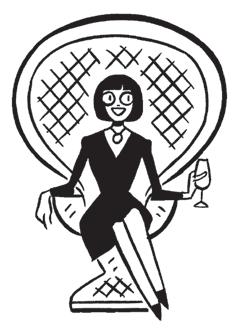 W G, Ascot, Berkshire
W G, Ascot, Berkshire
AI can only suggest you confide in the builders or service engineers before they arrive and apologise as they leave. I know it’s disloyal, but at least they’ll know they have someone on their side. Eventually you’ll find a group of workmen who will be bright enough to understand the situation and be able to deal with him in a jovial way and not take his snoopervision personally!
Doctor doesn’t know best
QI’m starting to feel that these days I have to be my own doctor! When I visit my doctor, he often gives me several options as to how to go ahead with a problem, and when I say I don’t know which to pick, he says that it’s up to me – he can only give me the information. Frustrated the other day, I said, ‘But if you were me, what would you do?’ And he said, ‘I am not you.’ Emily D, by email
AIn the bad old days. doctors often behaved like minidictators and their patients lived in fear and trembling. They followed their doctors’ strictures blindly, not daring to point out the occasional glaring flaws in their prescribed treatments.
In around the ’70s, all this changed. ‘Empowering patients’ was the approach and doctors became terrified their clients
might sue them if they gave the wrong advice. So the pendulum swung the other way. Is there not another doctor at your practice whom you could try?
Or could you go to another surgery in your area? Or try explaining, charmingly and kindly, that you have no desire to catch him out in any way, but you do just want some advice. Say you will write this down if he feels happier. But remember that he may really have no views.
What works for one patient doesn’t always work for another.
Storm over a teacup
QJust after our mother’s death, my brother started up a major row over a tea set he said he wanted – but had taken no interest in before. I had always understood my mother wanted me to have it, and now we’re locked in this horrible fight. I feel so upset. I need time to grieve and this feud is stopping me from being able to do so.
Name and address supplied
AOh dear – you’ve fallen for the old grieving trap. There is no specific ‘time to grieve’ – a few weeks when we sit down quietly, mull over old letters and memories, pore over old photographs and weep. Grieving is frequently painful, unpleasant and messy, involving anger, jealousy, hatred and all kinds of other horrible emotions that pop in unbidden. This row with your brother is all part of grieving.
Bereavement, sadly, often brings out the worst in other people. And ourselves.
Please email me your problems at problempage@theoldie.co.uk; I will answer every email – and let me know if you’d like your dilemma to be confidential.
98 The Oldie August
2023
The Oldie is published by Oldie Publications Ltd, Moray House, 23/31 Great Titchfield Street, London W1W 7PA ISSN 0965-2507. Printed in England by Walstead Group. Distributed by Seymour Distribution Ltd, 2 East Poultry Avenue, London EC1A 9PT; www.seymour.co.uk
order a print subscription, email theoldie@subscription.co.uk, or call 01858 438791, or write to The Oldie, Tower House, Sovereign Park, Market Harborough LE16 9EF. Print subscription rates for 12 issues: UK £49.50; Europe/Eire £58; USA/Canada £70; rest of world £69. To buy a digital subscription for £29.99 or a single issue for £2.99, go to the App Store on your tablet or mobile and search for ‘The Oldie’. All rights of reproduction are reserved in respect of all articles, drawings, sketches etc published in The Oldie in all parts of the world. Reproduction or imitation of any of these without the express prior written consent of the publisher is forbidden. The Oldie is available in audio and e-text format for the benefit of blind and partially sighted readers through RNIB Newsagent. Telephone 0303 123 9999 or visit www.rnib. org.uk/newsagent for further details.
To

















































































































































 PAUL STONE, FENSTANTON, CAMBRIDGESHIRE
PAUL STONE, FENSTANTON, CAMBRIDGESHIRE































































































































 Louise Flind
Louise Flind


























































 W G, Ascot, Berkshire
W G, Ascot, Berkshire

